
- (954) 633-4878
- [email protected]

Compass Articles
- February 2, 2024
The Aesthetics of Modern Yacht Hull Designs

When Function Meets Form
In the realm of modern yachts, the hull design has evolved from a purely functional element into a statement of art and individual expression. The sleek contours, bold lines, and innovative shapes seen on today’s vessels do more than just navigate the water efficiently; they convey a level of sophistication and aesthetic appeal that is as important as the yacht’s performance. A thoughtfully designed hull can turn heads at the marina and make a lasting impression as it cuts through the waves.
The Trend of Sculptural Hulls
Gone are the days of boxy, utilitarian boats. Today’s yacht hulls are sculptural masterpieces, with every curve and angle designed to evoke emotion and allure. Naval architects often draw inspiration from luxury automobiles, aerospace, and even nature to create hull forms that are dynamic and fluid. This drive for visual appeal has led to more diverse and daring yacht profiles on the water, catering to a clientele that desires an artful representation of their passion for the sea.
Colors and Finishes: More Than Just White
While white remains a classic and popular choice for yacht hulls due to its heat-reflective properties, we’re now seeing a wider palette of colors and finishes. Metallic hues, matte textures, and even custom graphics are being used to add personality and brand identity to vessels. A yacht’s finish can accentuate its shape, highlight unique design features, and make a personal statement about its owner.

Lighting: An Illuminated Experience
Lighting has become an integral part of modern yacht hull design. Strategically placed underwater lights or LED accents not only serve a practical purpose but also create a visual spectacle that enhances the yacht’s presence, especially after sunset. The interaction between light and water brings a new dimension to a yacht’s aesthetics, offering a mesmerizing display that captures the beauty of marine architecture.
Integrating Nature with Open Hull Concepts
A rising trend in hull design is the seamless integration of indoor and outdoor spaces, blurring the lines between the yacht’s interior and the surrounding environment. Panoramic windows, fold-out balconies, and open stern concepts maximize natural light and provide uninterrupted views of the ocean. The hull becomes more than just the base of the yacht; it’s the gateway to the sights and sounds of life on the water.
The Value of Aesthetics in Yachting with Fly Yachts
At Fly Yachts, we recognize that the aesthetic of a yacht is as essential as its performance. Whether it’s sleek minimalism, classic elegance, or avant-garde flair, the visual statement a yacht makes is a reflection of its owner’s style and sensibilities. Our team keeps a finger on the pulse of design trends, ensuring we can provide access to the most stylish and visually impressive yachts on the market. When aesthetics matter as much as the journey itself, Fly Yachts is your partner in finding that perfect blend of art and ocean.

Ready to captain a yacht that stands out from the rest? Check out yachts for sale at Fly Yachts, offering a range from high-end luxury yachts to sturdy and dependable center consoles. Get insights on who’s selling these impressive vessels by visiting the About Us page, where you’ll learn about the team’s dedication and expertise. Thinking about designing a yacht that’s uniquely yours? The Build a Yacht page is where you can start planning your dream build. If you’re itching for a yachting adventure in beautiful locales, Charter Destinations lists some of the best places to take your yacht. Considering selling your yacht? Sell Your Yacht page is where you’ll find the guidance you need to make a successful sale. For those who enjoy the heights of luxury in the skies, the Aircraft for Sale page presents a selection of premium aircraft. Stay well-informed about yachting with informative articles on Compass Articles and get the latest news from Gulfstream News . Want to charter a yacht? Yacht Charter has the information on rentals to suit your needs. If you have questions or need assistance, Contact is the place to get help. Start your exciting yachting journey from the Homepage , where luxury and adventure await.
About FLY Yachts
Unmatched Industry Knowledge, Paired With Brokers Who Care Equals Yachting You Love.
Recent Posts
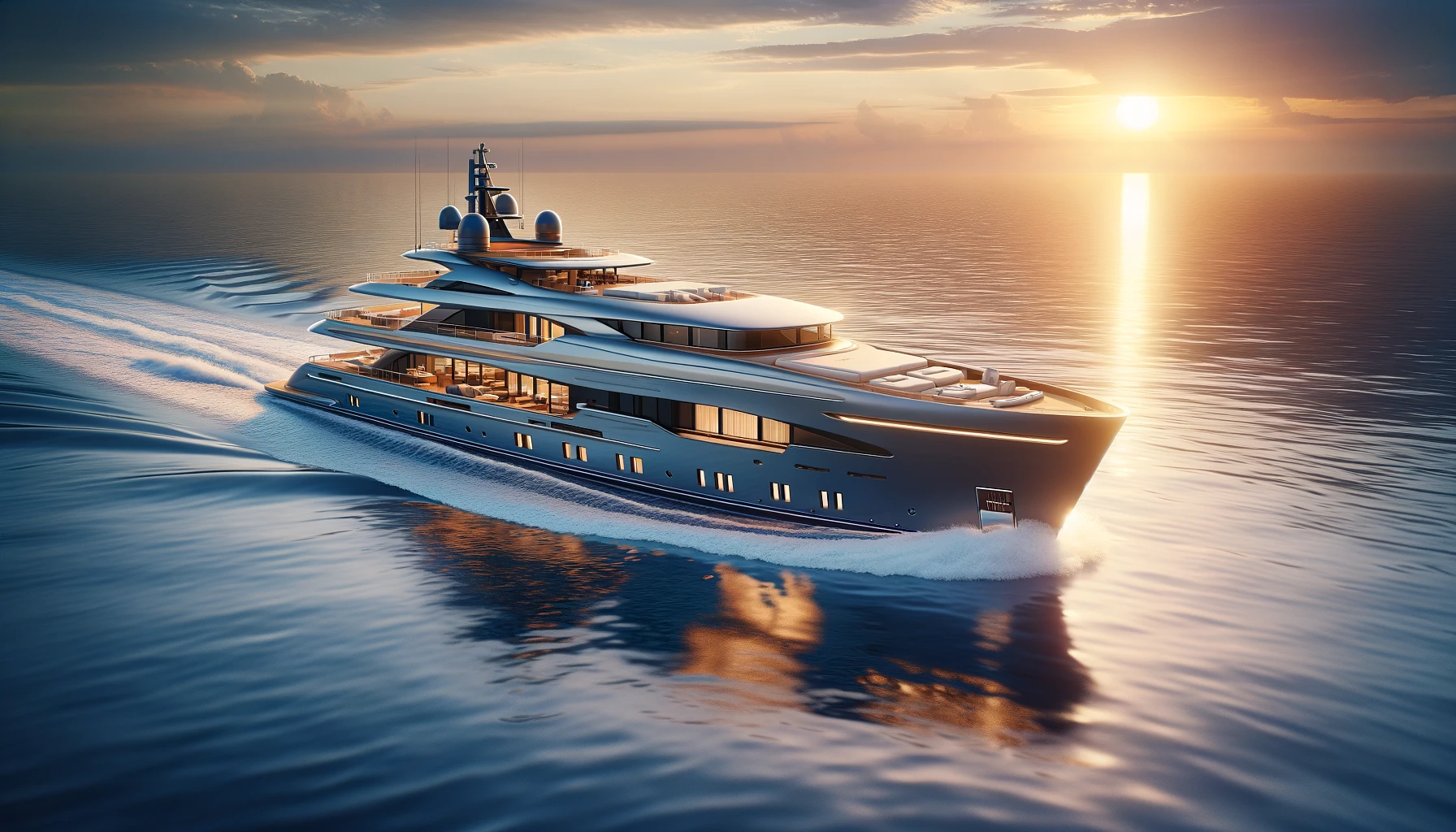
Yachting as a Legacy: How to Choose a Vessel That Lasts Generations

The Epitome of Sea Elegance: Your Guide to Buying an Exclusive Yacht

Decoding the Luxury Yacht Market: What Every Aspiring Owner Needs to Know


The global authority in superyachting
- NEWSLETTERS
- Yachts Home
- The Superyacht Directory
- Yacht Reports
- Brokerage News
- The largest yachts in the world
- The Register
- Yacht Advice
- Yacht Design
- 12m to 24m yachts
- Monaco Yacht Show
- Builder Directory
- Designer Directory
- Interior Design Directory
- Naval Architect Directory
- Yachts for sale home
- Motor yachts
- Sailing yachts
- Explorer yachts
- Classic yachts
- Sale Broker Directory
- Charter Home
- Yachts for Charter
- Charter Destinations
- Charter Broker Directory
- Destinations Home
- Mediterranean
- South Pacific
- Rest of the World
- Boat Life Home
- Owners' Experiences
- Interiors Suppliers
- Owners' Club
- Captains' Club
- BOAT Showcase
- Boat Presents
- Events Home
- World Superyacht Awards
- Superyacht Design Festival
- Design and Innovation Awards
- Young Designer of the Year Award
- Artistry and Craft Awards
- Explorer Yachts Summit
- Ocean Talks
- The Ocean Awards
- BOAT Connect
- Between the bays
- Golf Invitational
- Boat Pro Home
- Pricing Plan
- Superyacht Insight
- Product Features
- Premium Content
- Testimonials
- Global Order Book
- Tenders & Equipment
A guide to superyacht hull design
In this guide to superyacht hull design, we break down the specs, must-know information and outline all of the pros and cons of the typical superyacht hull shapes.
Displacement yacht hull design
- Fn: up to about 0.42
- Average power requirement: 5hp/ton
- Prismatic coefficient: 0.56 0.64
- LCB: 0.50 0.54 (54 per cent back from waterline entry)
- Can be optimised for resistance
- Capable of doing hull speed
- High displacement over length
- Much more forgiving in terms of weight, where the impact on performance is minor
- Less initial stability, but more dynamic stability, which equals more comfort
- If you want more speed, you have to increase the length
- Can carry more fuel, and use less, which equates to more range
- Offers the most volume at common interior positions
- Engine room smaller less power:weight ratio
- Increase stability by reducing weight (if the centre of gravity remains the same) a heavy boat is not necessarily more stable
- Interior materials do not need to be lightweight
Semi-displacement (semi-planing) yacht hull design
- Fn: 0.6 1.1
- Average power requirement: 10hp/ton 40hp/ton
- Prismatic coefficient: 0.63 0.68
- LCB: 0.53 0.57 (more volume aft)
- More buoyancy aft means can keep pushing more power, but this means increased resistance at lower speeds
- Resistance heavily depends on the frictional component; reducing weight can minimise it
- Flatter, lighter, sharper forebody all more suitable for generating hydrodynamic force on the bottom
- Higher initial stability
- Larger transom beam means more broaching tendency in a following sea
- Less flexibility in weight and weight position
- Wider speed range, so lower speeds mean lower engine loading which is not optimal
- There is an optimum size going smaller and smaller makes semi-planing hull harder to achieve, and going larger and larger means the weight increases disproportionately
- Much superior seakeeping compared to planing boat
- Can optimise for higher or lower speeds, but not both
- Less volume in hull, especially forward part
- Best of both worlds lots of possibilities
Planing yacht hull design
- Fn: 1.1 and above, preferably from 2 and up
- Average power requirement: 60hp/ton plus
- Prismatic coefficient: 0.68 0.76
- LCB: 0.58 0.64
- Typically monohedral prismatic aft shape constant deadrise
- Light displacement
- Engine room forms a significant part of hull volume (up to 30-40 per cent)
- Weight matters power:weight ratio is critical
- Usually very sharp entry angles, although Fn 1.2 to 2 favours LCG forward and blunt entry
- Big beam and little weight mean extreme initial stability
- Uncomfortable in certain sea conditions
- Friction significant, so if left in the water for a couple of seasons speed will drop
- Wavemaking coefficient very low, so frictional resistance is the dominant component
- Lots of exotic hull shapes, designed to reduce wetted surface and improve comfort in a seaway
- Little effective volume foreship, nothing fits; aft ship all engines
- Dynamic stability is a big factor, and can limit what is possible
- Speed benefit, and can escape bad weather
More stories
Most popular, from our partners, sponsored listings.
- Motorcycles
- Car of the Month
- Destinations
- Men’s Fashion
- Watch Collector
- Art & Collectibles
- Vacation Homes
- Celebrity Homes
- New Construction
- Home Design
- Electronics
- Fine Dining
- Costa Palmas
- L’Atelier
- Les Marquables de Martell
- Reynolds Lake Oconee
- Scott Dunn Travel
- Wilson Audio
- 672 Wine Club
- Sports & Leisure
- Health & Wellness
- Best of the Best
- The Ultimate Gift Guide
9 Stunning Wooden Boats That Blend Classic Design With Modern Tech
These 9 yards are still turning out mahogany boats using hand-crafted methods that started centuries ago. the difference they're using the latest engines and hull designs. call it good wood., kevin koenig, kevin koenig's most recent stories.
- Open Space, Eco-Friendly Tech: What a Rising Class of Millennial Superyacht Owners Is Looking For
- ‘People Don’t Want to Be Inside’: How the Outdoors Became Yachtmakers’ Most Coveted Design Element
- Azimut’s New 72-Foot Yacht Has One of the Largest Flybridges in Its Class. We Hopped Onboard.
- Share This Article

There are few more classic sights in boating than a small mahogany runabout splitting the serene waters of a lake in some picturesque locale—be it northern Italy, Lake Tahoe, or a pristine stretch of Michigan’s Upper Peninsula. There is something almost primal about being on board a boat built from the first material humans fashioned roughshod canoes with.
Fortunately, there are multiple yards around the world that are still building wooden boats—but with modern hulls and systems that eliminate the hassles of owning a vintage yacht. Some build classic-inspired designs from the 1920s through the 1960s, while others focus on contemporary hulls, but with wood instead of fiberglass.
These builders will tell you that their material of choice offers the softest ride available, thanks to its natural properties. They will also say that the prestige of owning one of these boats is all but unmatched in the world of boating—wooden boats have long been a favorite of kings and movie stars. When you catch a glimpse of the beautiful brightwork and gleaming mahogany from the dock, you’ll find they clearly have a point.
Here are 9 of our favorite wooden boatbuilders.
Grand Craft, Genoa City, Wisconsin

“Our boats are few and far between, so the people who look at our boats often say they resemble a piece of art,” says Patrick Gallagher, president and CEO of Grand Craft Boats. The Wisconsin builder is currently focusing on two different models, the Burnham 26 runabout (opening image) and Winchester 36 commuter (pictured above). “The common denominator among our customers is that they want something that sets them apart from their neighbors without being gaudy or ostentatious,” says Gallagher. “A wooden boat is a way to demonstrate that.”
Boesch, Kilchberg, Switzerland

Jakob Boesch built his first boat in the 1890s, and more than a century later, his family continues to merge new technologies with old-world Swiss craftsmanship. Boesch ’s 28-foot 860 has a classically styled mahogany hull with up to 11 layers of wood laid at right angles, sealed with six layers of epoxy and finished with six layers of varnish. Propulsion choices include modern options such as twin 150 kw electric engines for quiet, emissions-free operation or more conventional gas or diesel engines. The runabout’s meticulous craftsmanship disguises a beast of a machine designed for precise handling, tow sports and speed. Equipped with twin 380 hp Ilmor gas engines, the 860 can hit 48 mph.
Spirit, Ipswich, England

The 111-foot Geist , launched in 2021 by Spirit, is the largest single-masted wooden sailing yacht built in the UK since the 1930s, when the America’s Cup yacht Shamrock V ruled the seas. But Geist is much more than a giant sloop. Her eco-conscious owner mandated systems like the first-of-its-kind electric propulsion by Torqeedo—a 100 kw motor fed by BMW lithium-ion battery banks, which recharge while Geist is sailing—while her Rhoades Young interior elevates wood to its maximum potential, showing off sustainably sourced sipo mahogany, teak and walnut in a series of continuously flowing curves. Even her sails are made of recyclable materials.
HackerCraft, Queensbury, NY

Founded in 1908, HackerCraft is one of the most prominent names in the wooden-boat world. The builder does series of boats such as its Sport, Sterling, and Racer models and also takes on full-custom jobs. “The build method lends itself to customization,” says Erin Badcock, Hacker Craft’s COO. “We build on a jig so anything is possible. Our main focus is to maintain the timelessness of the boat, but at the same time we have the ability to do custom designs.” For a builder with timelessness in mind, Hacker also has an eye on the future with its fully electric 27 Sport , which has a run time of up to three hours and a 30-knot top end.
Shearline, Morehead City, NC

Shearline is one of the cluster of custom sportfish builders centered around North Carolina’s famously rough Oregon Inlet. The builder is not uncommon amongst its peers in that it only turns out one or two boats a year. But the firm stands out among sportfish builders in that it’s still building in wood. Using wood instead of fiberglass is a no brainer. “The strength of a tree is in its ability to bend with the wind,” says Chip King, Shearline’s president. “You come off a wave and wood absorbs the shock, whereas fiberglass transfers it. There’s no comparison between the two materials when you want the softest ride possible.”
StanCraft, Hayden, Idaho

From out west comes Idaho’s StanCraft . This 90-year-old brand was founded in 1933 by W. H. “Billy” Young and his son Stanley C. Young. The company has remained within the family, with new boats now built by the third generation. A fourth generation is coming up in the business as well. The builder offers a line of five models, plus full-custom jobs. The boats are notable for the variations seen in its shearlines, which can be straight, broken, or cambered. The company also prides itself on its fit and finish. Each boat, for example, receives 16 coats of varnish, buffed to a mirror shine before delivery.
GarWood Custom Boats, Brant Lake, NY

GarWood Custom Boats is headquartered in New York State’s pastoral Adirondack region, where the multitude of freshwater lakes make an ideal playground for a wooden runabout. The builder constructs its boats using richly grained mahogany, with low-profile, retro lines. The first version of the brand, launched by Garfield Arthur Wood in 1922, was famous for its 33-foot Baby Gar runabouts. The most recent ownership of the brand continued with its racing pedigree, turning out boats like the 22- and 27-foot Speedsters, which can pass the 60-mph mark, a redline that holds real weight for lovers of go-fast boats. Combine that with beautiful wood and you have a one-of-a-kind runabout.
Vandam Custom Yachts, Boyne City, Michigan

Vandam is a fully custom builder that only creates its wooden boats on commission. “We only build one of each boat,” says Jeremy Pearson, Vandam’s worldwide sales manager. “The people that come to us are usually seasoned and know what they liked in previous boats they owned—the lines, the seats, that kind of stuff. We do a lot of listening to the clients. The concept phase is a lot of fun here.” The Michigan yard has turned out a long list of very different yachts, from the Geromino commuter yacht to the pictured downeast-style vessel, with dozens of other styles in between.
Streblow, Lake Geneva, Wisconsin

Streblow has been building handmade wooden boats for 73 years. Each boat is framed using white oak, with a marine plywood bottom and Philippine mahogany for the outer planking. The attention to detail seen aboard these boats has gained an almost cult-like following, with customers often purchasing consecutive Streblows. Part of this loyalty stems from Streblow’s storage facility, a 17,000-square-foot structure that the builder says can extend the lifetime of a wooden boat indefinitely.
Read More On:
- Wooden boats
More Marine

This New 220-Foot Hybrid Megayacht Uses State-of-the-Art Heat Recovery to Save Energy

This New 62-Foot Solar-Electric Catamaran Is Topped by a Luxe Skylounge

This New 131-Foot Electric Catamaran Can Cruise the High Seas Sans Emissions

Asia Just Got a New Luxury Airliner. Here’s What It’s Like Onboard.

Culinary Masters 2024
MAY 17 - 19 Join us for extraordinary meals from the nation’s brightest culinary minds.
Give the Gift of Luxury
Latest Galleries in Marine

12 Fascinating Facts About ‘Kismet,’ the 400-Foot Megayacht With an Underwater Lounge

The 11 Best Water Toys for the High Seas, From Electric Surfboards to Personal Subs
More from our brands, what 2024 nominees wore to their first cmt awards: kelsea ballerini’s flowing costarellos dress, kacey musgraves’ sparkling gomez-gracia minidress and more, irs letter an ‘indictment’ of nil collectives’ exempt status, nbcuniversal, bbc execs talk ‘the traitors’ follow-up, ‘destination x’: ‘we are entering a golden age of unscripted’, a $20-30 m. lucio fontana from the rachofsky collection could set auction record at sotheby’s in may, the best medicine balls, according to fitness trainers.
- New Sailboats
- Sailboats 21-30ft
- Sailboats 31-35ft
- Sailboats 36-40ft
- Sailboats Over 40ft
- Sailboats Under 21feet
- used_sailboats
- Apps and Computer Programs
- Communications
- Fishfinders
- Handheld Electronics
- Plotters MFDS Rradar
- Wind, Speed & Depth Instruments
- Anchoring Mooring
- Running Rigging
- Sails Canvas
- Standing Rigging
- Diesel Engines
- Off Grid Energy
- Cleaning Waxing
- DIY Projects
- Repair, Tools & Materials
- Spare Parts
- Tools & Gadgets
- Cabin Comfort
- Ventilation
- Footwear Apparel
- Foul Weather Gear
- Mailport & PS Advisor
- Inside Practical Sailor Blog
- Activate My Web Access
- Reset Password
- Customer Service

- Free Newsletter

Tartan 30: An Affordable Classic

Ericson 34-2 Finds Sweet Spot

How to Sell Your Boat

Cal 2-46: A Venerable Lapworth Design Brought Up to Date

Solar Panels: Go Rigid If You have the Space…

Leaping Into Lithium

The Importance of Sea State in Weather Planning

Do-it-yourself Electrical System Survey and Inspection

When Should We Retire Dyneema Stays and Running Rigging?

Rethinking MOB Prevention

Top-notch Wind Indicators

The Everlasting Multihull Trampoline

What Your Boat and the Baltimore Super Container Ship May Have…

Check Your Shorepower System for Hidden Dangers

DIY survey of boat solar and wind turbine systems

What’s Involved in Setting Up a Lithium Battery System?

Waste Not is the Rule. But How Do We Get There?

The Scraper-only Approach to Bottom Paint Removal

How to Handle the Head

The Day Sailor’s First-Aid Kit

Choosing and Securing Seat Cushions

Cockpit Drains on Race Boats

Re-sealing the Seams on Waterproof Fabrics

Safer Sailing: Add Leg Loops to Your Harness

Waxing and Polishing Your Boat

Reducing Engine Room Noise

Tricks and Tips to Forming Do-it-yourself Rigging Terminals

Marine Toilet Maintenance Tips

Learning to Live with Plastic Boat Bits
- Sailboat Reviews
Practical Sailor Takes a Look at Trends in Modern Boat Design
Is the quest for speed and interior comfort trumping smart design in todays sailboats.
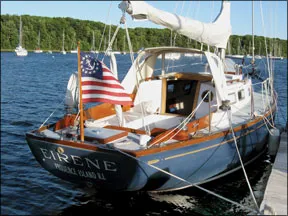
Practical Sailor editors have noticed the increasing tendency in newer-model sailboats to be ill-mannered in gusty conditions. Establishing balance between the sails and the hull is one of the main factors in quality boat design. For correct trim, many things must be considered: the ballast package location, the combined longitudinal center of gravity (LCG), and the longitudinal center of buoyancy. At the same time, to maintain a balanced helm, the keel must promote sufficient lead (the fore and aft distance between the center of effort and the center of lateral resistance). To highlight how these boat design principles play out, Practical Sailor looks at classic sailboats such as the Bill Shaw-designed Pearson 32, Ericson 41, Valiant 40, and Peterson 44, and compares their keel/sail ratios and lead values to more modern sailboat designs such as the Catalina, Hunter, Tartan, and Beneteau.
In the course of taking out boats for testing, Practical Sailor editors have observed an increased tendency for new-model sailboats to be ill-mannered in gusty conditions. We have been watching this trend for several years, and it seems to be becoming more usual than unusual.
In a typical situation, we will be sailing the test boat on the wind in 12 or so knots of breeze and everything is fine. Then, the breeze picks up to about 15 knots and the helm loads up. OK, thats to be expected, so we flatten the main, drop down the traveler, and that takes care of it.
Then we get a puff. Were already on the point of needing to reef, so in the puff, were overcanvassed. Instead of just heeling farther, the boat begins to round up. Fighting it with the helm is hard work, and easing the main so it luffs doesn’t help much.
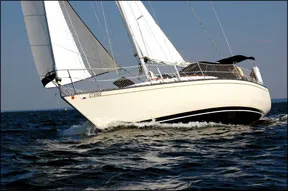
Photo by Ralph Naranjo
We take in a reef, which usually means we roll in a bit of the jib or a bit of the main, or both, and the helm lightens up. We trim to the new wind and sail along, a bit slower now in the light spots, but then the next gust comes along, and the helm immediately loads up again.
In the worst case weve experienced, the boat rounded up so quickly that it tacked, even though the helm was hard over in the opposite direction. To prove that wasnt a fluke caused by a temporary diversion into a parallel universe, it did the same thing on the other tack.
Practical Sailor editors are old enough to remember a generation of cruising boats that didnt behave in this manner. For sure, there have always been twitchy boats, but most, when hit by a gust, would heel a little more, put some pressure on the wheel or tiller, and once the boat picked up speed, the pressure would come right off. A boat like that will sail for a long time with a loose lashing on the helm.
So, where does this bad habit come from? Several trends in modern cruising yacht design can share the blame. One of them is builders inclination to tilt their designs toward the performance end of the cruisers spectrum. Many recent and current cruising boats, if suitably fitted out with racing sails and the hardware and software to tweak them, could put up an impressive show on the race course.
The sensitivity to trim that accompanies such potential isn’t always suited to cruising shorthanded or with a family, when balance and good manners are key both to enjoyment and, to a degree, safety.
Establishing Balance
Many factors contribute to the balance of a sailboat. The obvious and principal pair are the sails and the hull. When working up a new design, the architect develops these in close association, but both are in turn influenced by other aspects of the boats design as it evolves.
In the standard approach, the designer works up preliminary drawings to express the basic requirements of the design brief, which normally include a desired length, displacement, cabin arrangement, and sailplan to provide the desired performance.
He then sketches out the hull lines (the matrix of contours that define its three-dimensional shape and its volume) to enclose the interior and meet expressed performance goals. The preliminary lines also serve as a basis on which to perform a number of calculations, one of them being the location of the center of buoyancy (CB).
With everything roughed out, the designer then “weighs” every item that will go into the complete boat, from the hull laminate to the toothbrush holder, but excluding the ballast. He combines these weights and their locations on the three axes, X, Y, and Z, to calculate the center of gravity (CG) of the whole package. Computer programs have helped to speed up this process and make volume calculations more accurate, but the process hasn’t changed much.
For the boat to float on its desired lines, the ballast package must then be designed and located to bring the combined longitudinal CG (LCG) of hull and ballast to the same fore-and-aft location as the CB (LCB). Once everything has been resolved satisfactorily, the designer can finalize the lines, carry out the necessary calculations, and establish shape and locations for the keel and the sailplan.
On most boats of current design, the ballast also constitutes the fin keel, and in that role, its location determines the center of lateral resistance (CLR), which in conjunction with the center of effort (CE) of the sailplan, influences how the boat balances under sail.
Even as boat design procedures have evolved from three-dimensional modeling using half hulls, through two-dimensional modeling using pen on vellum, to three-dimensional virtual modeling on computers, the fundamental principles have remained constant. One of the fundamental values used for predicting the proclivities of a boats helm is the dimension termed “lead.” Lead, pronounced “leed,” is the fore and aft distance between the CE and the CLR, expressed as a percentage of the waterline length (DWL).
“Skenes Elements of Yacht Design,” as revised by Francis S. Kinney, and other references for yacht design provide rules of thumb for calculating lead from the sailplan and the hull profile. (See illustration above).
Looking at the diagram, its easy to see how lead is an elusive quantity. First of all, no boat sails with the sailplan as shown-the sails are never flat and on centerline. The traditional range for lead places the CE forward of the CLR by 14 to 19 percent of DWL. This value is lifted from “Skenes,” for years the first reference for any designer. Since that book was written and updated, hull forms have changed, and with them, optimum values for lead.
On designs with fin keels, lead is often calculated with reference to the keel alone. One feature remains constant whatever the design. Moving the centers closer together-reducing lead-increases the tendency to weather helm. Moving them apart reduces that tendency. If the lead is too great, the result may be lee helm, which is generally considered undesirable-and is in fact, rare.
In Kinneys prime years, the 1960s to the 1980s, the basic working sailplan of a sloop included a 150-percent genoa, which would have the effect of moving the CE closer to the CLR. Many designs today have headsails with short or even no overlap and very often a full-battened mainsail with lots of roach. The different aerodynamic characteristics of such rigs might well affect optimum lead, something which designers can only determine through experience. (If a boatbuilder offers an in-mast furling mainsail as an option, its effect on lead will differ from that of the “classic” sailboat.)
The effective CLR can also be very different from that calculated. On a deep-bodied, full-keel hull, that difference simply might be the difference between the geometric center and the center of hydrodynamic pressure of the whole profile.
A sharp bow with a pronounced “chin” might well move the effective CLR forward. On a modern, fin-keeled boat with a shallow, broad canoe body like that of a dinghy, the keel makes a proportionately larger contribution to lateral resistance, so the location of the keel will strongly influence where that resistance operates.
Obviously the rudder, too, is part of the lateral plane, but if our objective is to sail with light to neutral pressure on the helm, under normal conditions, it should not be making a significant contribution to lateral resistance. Its role is to provide a means to change the boats direction and to compensate for the constant fluctuations in the forces applied to the boat in the normal course of sailing. A certain amount of pressure in the form of weather helm helps by providing positive feedback to the helmsman on the state of balance. That said, on many racing hulls, the rudder is designed to contribute lift and has an active role in driving the boat to windward. (It is worth noting that those wide-bodied race boats also tend to have twin rudders.)
Then and Now
Even in the age of computer modeling, yacht design remains a series of compromises. At the moment, it seems the pendulum has swung to a point where high-volume, wide-beam shapes dominate. With them come large rigs to overcome skin drag and its negative effect in light air. As a result, theres a need to sail the vessel as flat as possible or suffer the consequences.
The sailplan and outboard profiles of boats from different eras represent the shift in yacht design that has occurred during recent decades. The modern boats have longer proportional waterlines, indicating higher potential speed. It also means that the boats immersed volume, or displacement, has been distributed over a greater length.
Given two boats of similar displacement like the classic Pearson 32 and the modern Tartan 3400 (above), the Tartan winds up with a shallower canoe body. This also contributes to its being potentially faster and, if both boats had the same draft, would give the keel a slight advantage in span, and therefore effectiveness to windward.
So far so good, but a shallower canoe body forces the cabin sole upward, especially if the belowdecks accommodations are to take full advantage of the wide beam favored in the modern hull. To achieve comparable headroom with its older counterpart, the cabintop has to go up, too, and to ensure sitting headroom on the settees under the sidedeck, so does the freeboard.
Ultimately, the whole deck moves upward. To ensure the boom doesn’t sweep everybody out of the cockpit during an unplanned jibe, the boom too goes up. If sail area is not to be compromised, the entire mainsail goes up, and with it, its center of effort. The bigger the boat, the less pronounced these differences become as the proportions become more relaxed.
Differences are visible, too, between the boats keels; the modern Tartans is smaller in area. While it might be claimed that less wetted surface promises higher sailing speeds in light air, some builders accept a smaller keel to simplify the manufacture of the hull.
In a perfect world, the designer draws a keel to suit the boats sail area and other characteristics, places it to obtain the desired sailing performance, then massages the needed ballast to both fit the keel and trim the boat correctly. The volume of the ballast is usually less than that of the keel, and the builder has to do some intricate laminating work to mold a keel to receive ballast internally or a stub to which to bolt it externally.
On many production boats today, the keels are bolted directly to the bottom of a fair canoe body, a practice which eliminates much labor. The consequence is that the area of the keel is determined by the weight, and therefore the volume, of the ballast. To achieve the desired hydrodynamic properties and mechanical strength-it mustnt bend under the influence of normal sailing loads-a given volume of ballast can be formed into a limited range of shapes. Placing ballast in a bulb at the bottom aids the keels efficiency by creating an endplate effect and raises stiffness by placing ballast low, but it means that the keels lateral plane is sharply reduced.
For a more dramatic representation of how changes in keel design can affect helm balance, compare a Cruising Club of America (CCA) design like the Ericson 41 above, to a modern equivalent with comparable sail area like the Beneteau 46.
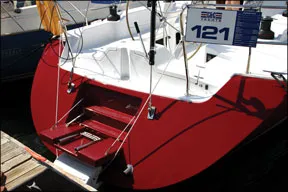
When sailing, two boats are subjected to similar forces on the sails. Resisting that side force are the immersed hull, the keel, and the rudder. If the hulls offer similar resistance, the remaining force is shared between the keel and rudder. If one keel is smaller than the other (as is clearly the case here), the effect is to increase the share taken by the rudder.
When the sails are trimmed properly and all is in balance, the rudder will carry a small load. If however, you hit a gust, the rudder must pick up a high proportion of the added side thrust until balance is restored, usually by some adjustment to sail trim.
Simply put, boats of the general modern type are not forgiving in changeable conditions, say, for example when the apparent wind is in the 12- to 18-knot range. At the higher end, youd want to be reefed; at the lower end, probably not.
On a day when you expect the wind to soften rather than harden, youd rather not put in the reef, so that you can maintain speed in the lulls. In the puffs, you want your hands free to ease the traveler and flatten the jib, which is hard to do if the helm is a handful. Compounding the problem on most boats, the mainsail controls are usually not within reach of the helm.
On racing boats, such sensitivity isn’t an issue. On the contrary, sufficient crew are on hand to make adjustments on the fly as quickly and often as needed to keep the boat sailing at her fastest.
Cruising boats are often sailed shorthanded and by crews who are not looking for a constant physical workout. An autopilot might be doing most of the steering, and good balance is helpful in protecting it from having to work too hard-or from being overpowered.
Another striking difference between the older and newer designs is visible in the plan (overhead) view. By 1980, cruising-boat hulls were already becoming beamy relative to boats of the 1960s and 1970s. The current trend is to carry the beam aft, so that in the region of the rudder, its as much as 85 percent of the maximum beam, far wider than the 55 percent to 60 percent once considered acceptable. The principal beneficiary of this extra breadth is the boats interior-builders often offer twin double cabins aft where a generation ago they might have squeezed in a quarter berth and a cockpit locker. The cockpit, too, becomes roomier, and the transom, scooped and sculpted, is transformed into a swim platform and dinghy dock.

Photo by Jarrod Scanlon
All this additional boat aft adds weight aft, in both construction materials and outfit. To compensate, the ballast-that is to say, the keel-has to be fitted farther forward.
The full beam aft does provide a significant boost to the boats ability to carry sail. As the boat heels, the center of buoyancy moves quickly outboard, away from the center of gravity. This lengthens the righting arm, giving a positive contribution toward stability, but it also moves the immersed centerline of the hull away from the static centerline along which both the keel and the rudder are attached. Depending on the hulls shape, this can create a distortion in the immersed volume, which can in turn affect the dynamics acting on it.
Effect of Keel Area
Another factor entering the equation is the area of the keel. This, too, is apparent when comparing the drawings of the older and newer generation boats. Many of the standard tracts on the design of sailing yachts are, lets say, vague on what keel area is adequate or even desirable, although many designers have come up with their own formulas.
Because the keel is reacting in the water to forces generated on the sails by the wind, it makes sense that the area of a fin keel should be related in some way to sail area.
When naval architect Dave Gerr took over as director of the Westlawn Institute of Marine Technology, he found the course materials for sailing yacht design had little detailed explanation on this topic, a gap he subsequently filled. Briefly, he recommends no fin keel should be less that 2.5 percent of the sail area (mainsail 100 percent foretriangle) and need be no more than 5 percent. The smaller value is appropriate for a racing boat with a full crew aboard to trim and tweak the sails to every change in the wind. The larger area is suited to cruising boats, which need to be more forgiving to shorthanded crews.
Current Design Trends
In the past, racing measurement rules have been criticized because the boats designed to compete under them have become type-formed, sometimes with unwelcome consequences in how they handle. We might just as easily level criticism at present-day marketing and manufacturing methods for doing the same to cruising boats.
Lets face it, but for a few differences in sailplans and keel shapes, modern cruising sailboats are quite generic below the sheerline. They are all beamy; they carry their beam aft; they have long waterlines; they have dinghy-like underbodies; and they have spade rudders. The forces that have created this shape have at least as much to do with how many people can sleep and shower in them comfortably as with how the boats will sail.
Dishing out the hull shape in this manner makes it fairly easy to push through the water, but arranging the keel, rudder, and sails so they work in concert has become a more complex problem, exacerbated by having to compensate for extra weight of accommodations aft, something thats less of an issue in raceboats.
The byproduct of these design parameters is zesty performance, a bonus for the marketing department, but speed for its own sake is not the first priority of cruising sailors. In the brochure for the Beneteau 37, the boats polar diagram shows a maximum theoretical sailing speed of over 12 knots in 30 knots of wind. When cruising sailors encounter 30-knot winds, they are more likely to hunker down in the expectation it will blow even harder than they are to set the chute to go surfing. What they want is a boat that will take readily to hunkering, and all the signs indicate those boats are getting fewer in number . . . and they are mostly older designs.
- The Balancing Act
- Pearson 32 vs. Tartan 3400
- Ericson 41 vs. Beneteau 46
- Practical Sailor Design Guide
- The Modern Hull and Helm Balance
RELATED ARTICLES MORE FROM AUTHOR
Leave a reply cancel reply.
Log in to leave a comment
Latest Videos

Fuel Contamination? The Baltimore Francis Key Bridge Collapse

Safety At Sea For You & Your Family – The Joe...

What’s The Best Vinyl Window Cleaner for Your Boat?

40-Footer Boat Tours – With Some Big Surprises! | Boat Tour
- Privacy Policy
- Do Not Sell My Personal Information
- Online Account Activation
- Privacy Manager
- AROUND THE SAILING WORLD
- BOAT OF THE YEAR
- Email Newsletters
- Best Marine Electronics & Technology
- America’s Cup
- St. Petersburg
- Caribbean Championship
- Boating Safety

Hulls of the Modern America’s Cup
- By Mark Chisnell
- Updated: January 8, 2021
Hull design has always been the most venerated aspect of an America’s Cup yacht. The name on the drawings has often been remembered with the same reverence as that of the skipper. This might not hold for much longer because the result of the 36th America’s Cup is just as likely to be determined by the work of a systems engineer as by a naval architect.
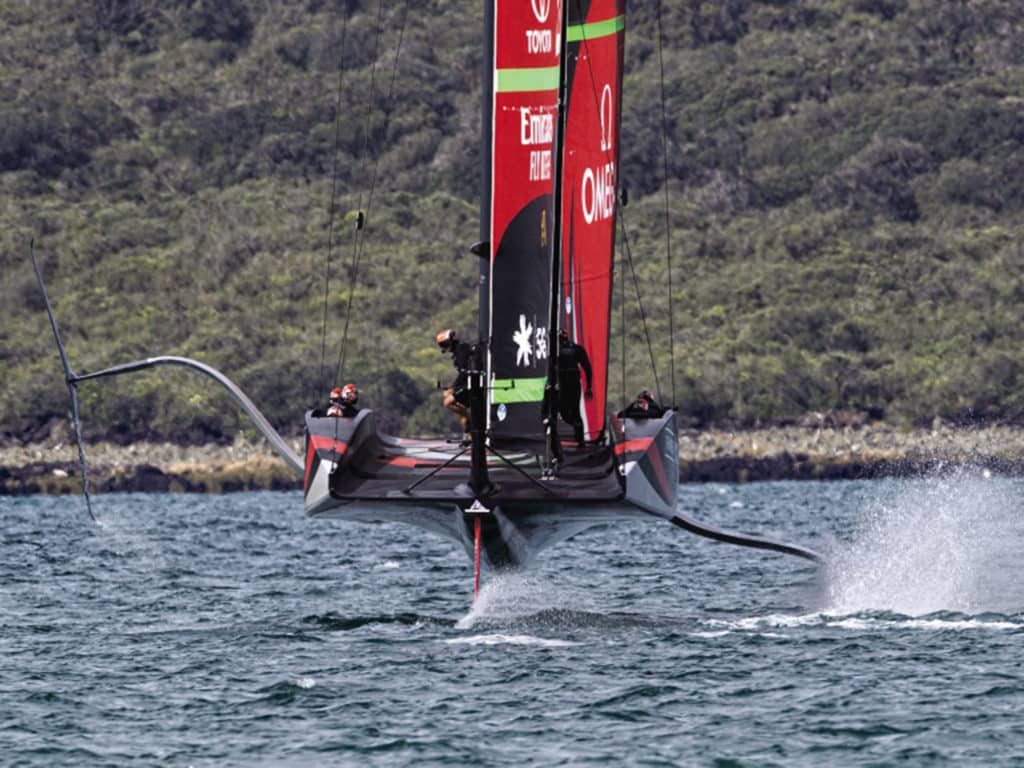
“The hull design is one aspect of many, but it’s not the dominant aspect,” explains Martin Fischer, co-design coordinator (along with Horacio Carabelli) for the Luna Rossa Prada Pirelli Team, who is on his second America’s Cup with the Italian team. “It’s not as it was with the 12 Metre or with version five (of the International America’s Cup Class), where the hull is really almost everything.”
The rules controlling a class are always a good place to start when seeking to understand a race boat because they drive so much of the design; working for the Challenger of Record, Fischer was part of the team that wrote the class rule for the AC75 with the defenders, Emirates Team New Zealand.
In the case of the AC75, the rules, Fischer says, are actually very open. They have little to say on the structure, for instance, requiring only a “minimum areal density of any part of the hull shell” (2 kg/m²). There’s also a limit on the internal volume (at least 70 m³), and after that, much of what’s left deals with details such as water retention, fairing flaps and penetrations.
There are only a few rules that drive the hull shape and its potential performance. “There is the length,” Fischer says. “The overall length is limited to 20.6 meters (minimum, without the bowsprit), while the beam must be 5 meters. Then there are two other very important rules: There is a theoretical capsize test that is done virtually on the computer. If the boat is turned by 90 degrees, the center of buoyancy must be at a certain position.
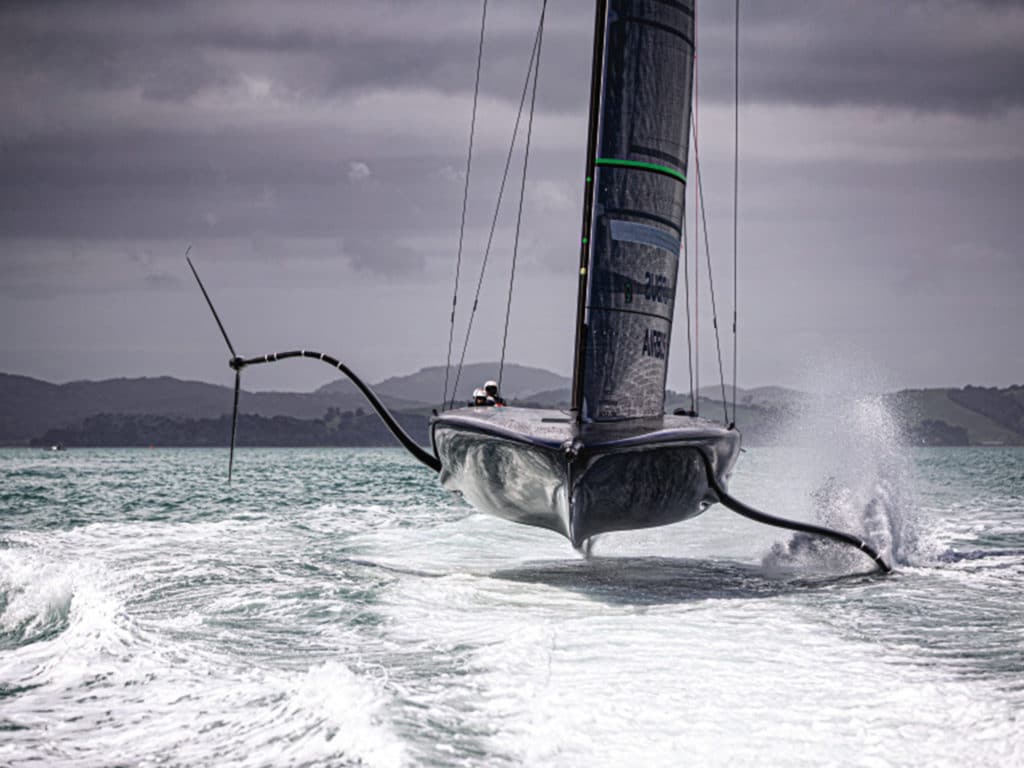
“This rule has a strong influence on the deck shapes. You might have noticed that all the boats have relatively high freeboard; this is partly for aerodynamics, but also, if you don’t have relatively high freeboard, you don’t pass this capsize test. The next important rule is that there is a minimum requirement for the waterplane inertia.”
Er…the water what?
“If the hull is floating, then you look at the intersection of the hull with the water surface (waterplane), and that gives the surface a certain shape. And then compute the inertia of that shape (it must be at least 20 m4). It’s not important to understand exactly what it is; in the end, it is more or less a measure or a constraint on the combination of that surface and its width.”
I’m not going to try to explain the calculation of the “second moment of area”—the important thing, according to Fischer, is that you “basically cannot make an extremely narrow hull, so you have to respect a certain area for that surface, and a certain width. The rule on the inertia is also quite type-forming; it imposes widths at the waterline. Of course, we all would like [the hull] to go narrow. Especially when the boat starts going fast, just before takeoff, we all want a narrow hull. And this is why we have these humps underneath the hull.”
Ah yes, the humps, skegs or bustles are one of the most significant shared features on all four of the newly launched, second-generation AC75s. The terms refer to the narrow, protruding section that runs down the centerline underwater. In the first-generation boats, only the Kiwi and Italian boats had this feature, and it was most pronounced on the latter.
“It’s a trick not to get around this inertia rule but to deal with it,” Fischer explains. “What you do is design a hull wide enough to pass this inertia rule while it is at the design flotation. And then as soon as it gets a bit of speed, the foil starts pushing up, and so the boat comes up, and then this wide part of the hull gets out of the water and only the narrow part remains. This significantly reduces the drag, especially during the takeoff phase.”
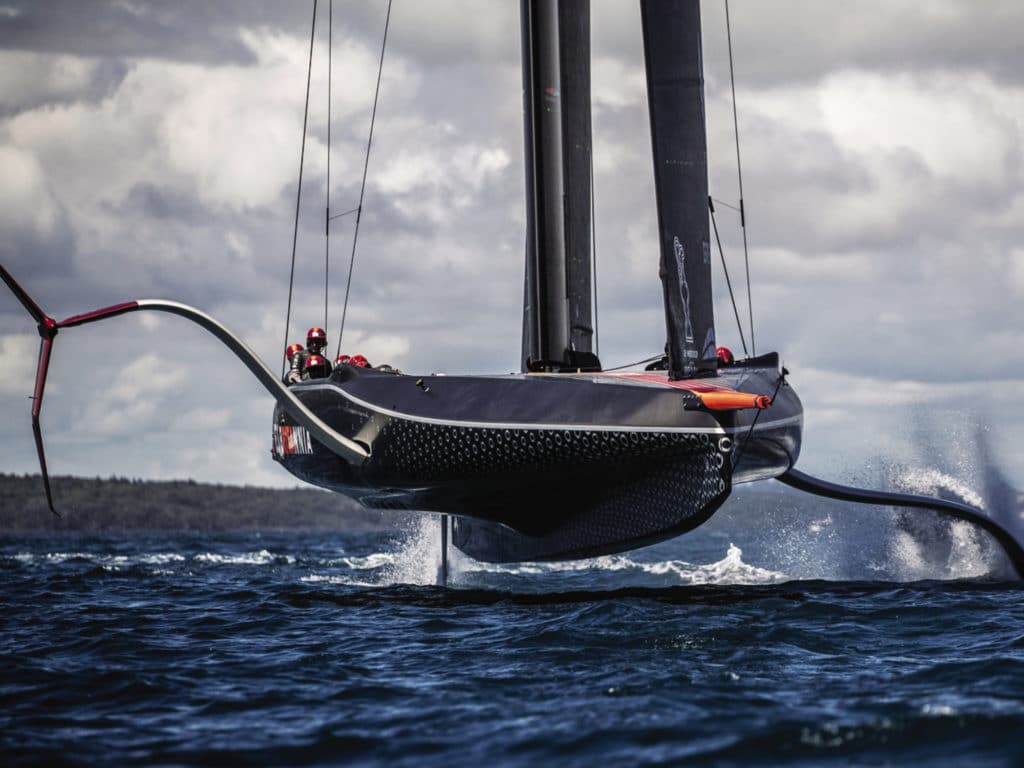
The humps also help when the boat touches down. “And that’s another reason for these humps underneath, because they allow you to fly lower, to take more risk, because if you touch a wave, the wetted surface, or the area that touches the wave, is very small, and therefore it slows you down only very little.”
Benjamin Muyl is on his second Cup with Ben Ainslie’s British challenger, having been involved in the event since 2005. Now the architect, he sums up the factors driving the performance of the AC75: “As soon as we decided that these boats are only going to race in flying (foiling) conditions, then there’s no point in having any righting moment from the hull. The whole righting moment comes from the foil, so then the hull shape is all about takeoff capabilities, so effectively [acceleration and performance at] slowish speed, in the order of 16 to 20 knots—the touchdowns. So, the ability of the hull to develop little drag when touching the water at speed or out of tacks, or out of jibe. And the other part of it, which is actually very important for these boats, is the aerial performance of the hull.”
This is the reason all four boats have skegs; they provide a benefit in all three areas that Muyl and Fischer describe. They enable better acceleration at slower speeds, and reduce the hydrodynamic drag and deceleration on touchdowns. This allows the boat to fly closer to the water, which has another important aerodynamic contribution. “On every wing, you have a high-pressure side and a low-pressure side,” Fischer explains. “And obviously, the air tries to flow from the high-pressure side to the low-pressure side, and if you let it do that, you lose lift. On a normal sailboat, this circulation that makes you lose lift is at the bottom, underneath the boom, and this loss is quite significant. To avoid that, on all the [AC75] boats, we see deck sweeper sails.”
Muyl worked with both Fischer and ETNZ’s Guillaume Verdier on Franck Cammas’ Groupama 5 , the International C-Class Catamaran Championship winner. It should be no surprise, therefore, that their thinking is aligned here. “In recent years, we’ve seen sails and wings extend to seal to the deck. It pretty much started with the Groupama C-Class boat for Cammas. And then that was also seen on the AC72, and since then all the Cup boats have the mainsail sealing on the deck. On these boats (the AC75), for the first time we have a monohull that’s flying. So, what’s happening is that now there is a gap again, so we pushed to effectively seal the hull to the water.”
It’s impossible to completely seal the hull to the water without increasing the hydrodynamic drag, and even maintaining the minimum distance is made harder by waves. “So, even if you had perfect control of the boat, it would be impossible to close that gap completely. But [the teams] make big efforts to close that gap as much as possible,” Fischer says.
“We spotted [the performance effect of sealing the gap] early in the project,” Muyl adds, “and always questioned whether it was a true phenomenon, or whether it was an artifact of the computation. We finally made the call to go there to try to achieve it. It’s interesting to see that all the boats have gone there now. So, yes, we followed the same path. It was done with different means between the various teams, but we went for this very squared bustle to try to create a vortex off the sharp edge that would effectively seal [the gap].”
When we look at the four new boats, it’s clear there is significant agreement on what makes for a fast AC75. The skegs are the most obvious element, but an aerodynamic hull shape is a close second. The speed of the boats drives this one, with apparent winds that can easily exceed 40 mph.
“If you stick your hand out of a car when you’re driving at that speed, you feel how big this drag is,” Fischer says. “This drag component is comparable to the drag we see in the water. All the teams have paid enormous attention to this; they hide the crew as much as they can, and have the shape of the hull as aerodynamic as possible, to reduce drag as much as possible.”
If looked at sideways from the beam, all the second-generation hulls reveal an aero foil section from bow to stern—don’t be fooled by the high sides of the Kiwi’s crew pods. Fischer explains: “It is hidden because [ETNZ has] these relatively high cockpits on the side to cover the crew. But in between the cockpits, the shape is pretty much like an aero foil. The American boat also has a pretty nice aero foil shape, and as well, the British boat. I think the only main difference is that on our boat, it’s a bit more obvious, but the others have more or less the same idea.”
The third consistent element is the split cockpit. “The cockpits were pretty much the same everywhere at the beginning,” Fischer says. “All the teams have cockpits on each side, with the crew well-protected from the wind to reduce drag. Also, the Americans at the beginning had the cockpit very far aft. Now they are farther forward. So overall, I think we can see quite a bit of convergence, but there’s still a wide variety.”
The variety in the boats is driven by the details, and they will decide the winner. For instance, there are significant differences in the skegs, which shouldn’t be a surprise given there are three different motives for having the skeg in the first place. “The optimal shape for these purposes is different,” Fischer says. “If you focus on aerodynamics, then you want a pretty narrow hump, because if you touch down, the wetted surface is really small, and so you can fly lower. The penalty you pay, if you touch a wave, is less than with a wider hump. But with a narrow hump, you have difficulties in takeoff because the volume in such a narrow hump is very small, and you need a lot more lift from the foil to get the flat part—the wide part of the hull—out of the water.”
The choices the teams have made reflect the capabilities they have prioritized for the upcoming racing. “The Kiwis and the British have a wider hump underneath, which is pretty flat at the bottom,” Fischer says. “So, in my opinion, they try to generate positive lift when they touch, and probably also during takeoff. Of course, if you generate lift when you touch, that comes at a price —you also generate drag.”
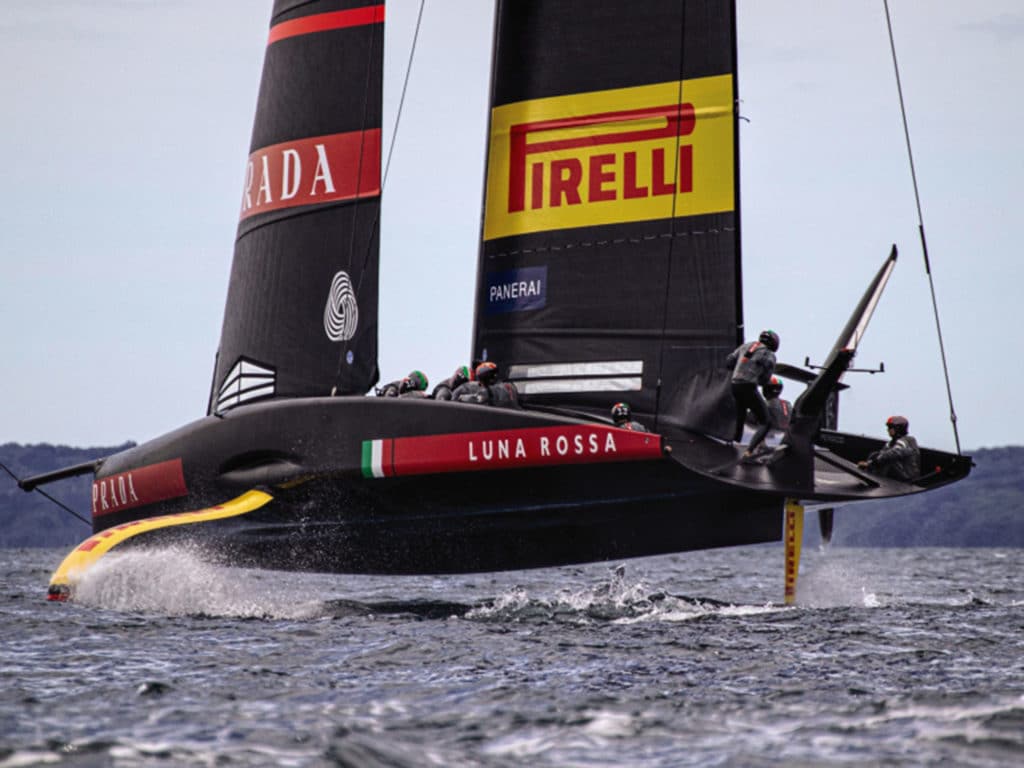
Muyl agrees, adding: “[It’s] not forgiving if we touch because there’s quite a lot of wetted surface area to start with. So, effectively, we are relying quite a lot on the ability of the sailors to control the boat and to fly it just above the free surface.”
“American Magic has a very narrow hump,” Fisher says. “So, in my opinion, they’re focused more on aerodynamics and flying low than on takeoff.”
Or maybe they want the best of both worlds. Muyl points to a different takeoff technique. “Their strategy to takeoff is to accelerate as well as they can, but then, when they are at the speed to takeoff, somewhere between 16 and 19 [knots], they force the nose up with their rudder, and effectively increase the angle of attack on the foil and takeoff like that.”
American Magic’s designer, Marcelino Botin, wasn’t giving much away at this stage. Speaking at the launch of Patriot , he said: “We’ve got a philosophy of the boat that we need, and the boat we have produced is our interpretation of the best possible boat to take forward that way of thinking.”
And the Italians? “Our hump is more rounded, and I would say ours is somewhere in between what the Americans did, and what the British and Team New Zealand did,” Fischer says. “So that’s a choice. When you design the yacht, you have to make assumptions and define conditions for which you want to optimize your shape.”
The winning design will need both the most accurate set of assumptions about the competing priorities, and efficient optimization. Easy to say, but there is nothing straightforward about this process, as Muyl explains: “I find this boat really complex, in terms of how everything is so interlinked. If you look at just the foils, we have [in the fleet] some very large bulbs and some very small bulbs—the whole scope. So, that’s interesting that four teams of competent people with comparable tools, with comparable budget and time, effectively reached some very different solutions in the end. I personally found it very hard to have a feeling for what’s the direction to go to be faster. The whole thing is incredibly intertwined. I find it very complex. And that’s at every level of the design.”
Fischer agrees, adding: “This kind of hull was new for everybody, and basically, everybody had to start from scratch and find new ways. And I can say, I don’t know what the others did, but we went for a very mathematical approach to get there. We used, right from the beginning, a dynamic simulator.
“We used systematic, automatic optimization methods to get to the hull shape that we got in the end. And I think without this mathematical approach, it would have been very, very difficult. And I guess for the other teams, it’s the same. I think it is very difficult with these boats to get to a good result with pure intuition.”
Now that they can see where they fit into the fleet, how do they feel?
“Well, I think we don’t really know,” Muyl says. “We have a feel for New Zealand. I mean, they won the last one. They gave a sailing lesson to everyone. So, they are usually strong, but so much is about reliability that I find it really hard to have a sense that I can trust about where things are.”
Fischer was more guardedly optimistic about the Challenger’s chances. “I think as usual, [ETNZ] did a good job, but I don’t think they…well, I hope they won’t be superior, and I don’t think they will be superior. I think it will be pretty tight racing.”
- More: AC75 , America's Cup , foiling , print 2021 winter , Racing
- More Racing
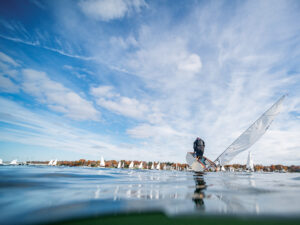
Into the Dink

Sally Helme, Marine Industry Icon Passes
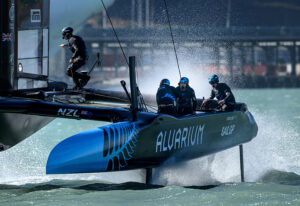
SailGP’s New Zealanders Win Destructive Event No. 9
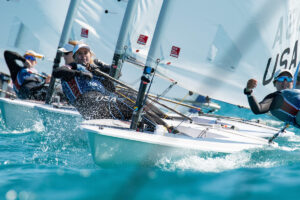
Reineke’s Battle For the Berth

One-Design Wingfoil Racing Takes Off

The Wisdom of Augie Diaz

Nautor Swan Has A New Pocket Rocket

Brauer Sails into Hearts, Minds and History

- Digital Edition
- Customer Service
- Privacy Policy
- Cruising World
- Sailing World
- Salt Water Sportsman
- Sport Fishing
- Wakeboarding
- BOAT OF THE YEAR
- Newsletters
- Sailboat Reviews
- Boating Safety
- Sailing Totem
- Charter Resources
- Destinations
- Galley Recipes
- Living Aboard
- Sails and Rigging
- Maintenance
- Best Marine Electronics & Technology
Sailboat Design Evolution
- By Dan Spurr
- Updated: June 10, 2020
You know the old saying, “The more things change, the more they stay the same”? As a judge for the 2020 Boat of the Year (BOTY) competition at this past fall’s US Sailboat Show in Annapolis, Maryland, I helped inspect and test-sail 22 brand-new current-model sailboats. And I came away thinking, Man, these aren’t the boats I grew up on. In the case of new boats, the saying is wrong: “Nothing stays the same.”
OK, sure, today’s boats still have masts and sails, and the monohulls still have keels. But comparing the Hinckley Bermuda 40, considered by many to be one of the most beautiful and seaworthy boats of the 1960s, ’70s and even ’80s, with, say, the Beneteau First Yacht 53, which debuted at the show, is pretty much apples and oranges.
To get a better sense of what has happened to yacht design, boatbuilding and equipment over the past three, four or even six decades, let’s take a closer look.
Design Dilemmas
At the risk of oversimplification, since the fiberglass era began in the late 1940s and ’50s, the design of midsize and full-size yachts has transitioned from the Cruising Club of America rules, which favored all-around boats (racers had to have comfortable interiors) with moderate beam and long overhangs, to a succession of racing rules such as the IOR, IMS and IRC. All of them dictated proportions, and each required a measurer to determine its rating.
As frustration grew with each (no handicap rule is perfect), alternatives arose, such as the Performance Handicap Racing Fleet, which essentially based one’s handicap on past performance of the same boats in the same fleet. Also, one-design racing became more popular, which spread beyond identical small boats to full-size yachts, popularized in part by builders such as J/Boats and Carroll Marine. The ethos there was: Who cares about intricate rating rules? Let’s just go out and sail fast and have fun!
And that might best sum up the design briefs for the monohulls in this year’s BOTY competition: good all-around performance with comfortable, even luxurious accommodations. Gone are interiors that noted naval architect Robert Perry called “the boy’s cabin in the woods,” deeply influenced by stodgy British designers of the past century and their now-old-fashioned (though sea-friendly, one should note) concepts of a proper yacht, drawn and spec’d by the same guy who designed the hull, deck and rig. Today, dedicated European interior designers are specially commissioned to inject modernity, home fashion colors and textures, amenities, and more light—even dubiously large port lights in the topsides.
Overhangs, bow and stern, have virtually disappeared. Why? It seems largely a matter of style. Plus, the bonus of increased usable space below, not to mention a longer waterline length for a given length overall, which translates to more speed. Former naval architect for C&C Yachts and Hunter Marine, Rob Mazza, recalls that 19th-century pilot cutters and fishing schooners operating in offshore conditions generally had plumb bows, so in a sense, bow forms have come full circle.
Today’s boats are carrying their wide beam farther aft. Gone are the days of the cod’s head and mackerel tail. Wide, flat canoe bodies are decidedly fast off the wind, and might even surf, but they pay a comfort penalty upwind.
These boats have lighter displacement/length (D/L) ratios, which means flatter bottoms and less stowage and space for tanks. The Beneteau 53 has a D/L of 118, compared with the aforementioned Bermuda 40 of 373. Among entries in this year’s BOTY, the heaviest D/L belonged to the Elan Impression 45.1, with a D/L of 195. Recall that when Perry’s extremely popular Valiant 40 was introduced in 1975, the cruising establishment howled that its D/L of 267 was unsuitable for offshore sailing. My, how times have changed!
Perhaps more important, one must ask: “Have the requirements for a good, safe bluewater cruiser actually changed? Or are the majority of today’s production sailboats really best-suited for coastal cruising?”
The ramifications of lighter displacement don’t end there; designers must consider two types of stability: form and ultimate. As weight is taken out of the boat, beam is increased to improve form stability. And with tanks and machinery sometimes raised, ballast might have to be added and/or lowered to improve ultimate stability.
What else to do? Make the boat bigger all around, which also improves stability and stowage. Certainly the average cruising boat today is longer than those of the earlier decades, both wood and fiberglass. And the necessarily shallower bilges mean pumps must be in good shape and of adequate size. That’s not as immediate an issue with a deep or full keel boat with internal ballast and a deep sump; for instance, I couldn’t reach the bottom of the sump in our 1977 Pearson 365.
And how do these wide, shallow, lighter boats handle under sail? Like a witch when cracked off the wind. We saw this trend beginning with shorthanded offshore racers like those of the BOC Challenge round-the-world race in the early 1980s. As CW executive editor Herb McCormick, who has some experience in these boats, says, “They’ll knock your teeth out upwind.” But route planning allows designers to minimize time upwind, and cruisers can too…if you have enough room and distance in front of you. Coastal sailors, on the other hand, will inevitably find even moderate displacement boats more comfortable as they punch into head seas trying to make port.
A wide beam carried aft permits a number of useful advantages: the possibility of a dinghy garage under the cockpit on larger boats; easy access to a swim platform and a launched dinghy; and twin helms, which are almost a necessity for good sightlines port and starboard. Of course, two of anything always costs twice as much as one.
Some multihulls now have reverse bows. This retro styling now looks space-age. Very cool. But not everyone is sold on them. Canadian designer Laurie McGowan wrote in a Professional BoatBuilder opinion piece, “I saw through the fog of faddishness and realized that reverse bows are designed to fail—that is, to cause vessels to plunge when lift is required.” Mazza concurs: “Modern multihulls often have reverse stems with negative reserve buoyancy, and those are boats that really can’t afford to bury their bows.”
McGowan also cites another designer critiquing reverse bows for being noticeably wet and requiring alternative ground-tackle arrangements. The latter also is problematic on plumb bows, strongly suggesting a platform or sprit to keep the anchor away from the stem.
Rigging Redux
If there was a boat in Annapolis with double lower shrouds, single uppers, and spreaders perpendicular to the boat’s centerline, I must have missed it. I believe every boat we sailed had swept-back spreaders and single lowers. An early criticism of extreme swept-back spreaders, as seen on some B&R rigs installed on Hunter sailboats, was that they prevented fully winging out the mainsail. The counter argument was that so many average sailors never go dead downwind in any case, and broad reaching might get them to their destinations faster anyway—and with their lunch sandwiches still in their stomachs.
That issue aside, the current rigging configuration may allow for better mainsail shape. But as Mazza points out, it’s not necessarily simple: “By sweeping the spreaders, the ‘transverse’ rigging starts to add fore-and-aft support to the midsection of the mast as well, reducing the need for the forward lowers. However, spreader sweep really does complicate rig tuning, especially if you are using the fixed backstay to induce headstay tension. Swept spreaders do make it easier to sheet non-overlapping headsails, and do better support the top of the forestay on fractional rigs.”
Certainly, the days of 150 percent genoas are over, replaced by 100 percent jibs that fit perfectly in the foretriangle, often as a self-tacker.
Another notable piece of rigging the judges found common was some form of lazy jacks or mainsail containment, from traditional, multiple lines secured at the mast and boom; to the Dutchman system with monofilament run through cringles sewn into the sail like a window blind; to sailmaker solutions like the Doyle StackPak. This is good news for all sailors, especially those who sail shorthanded on larger boats.
Construction Codas
Improvements in tooling—that is, the making of molds—are easily evident in today’s boats, particularly with deck details, and in fairness. That’s because many of today’s tools are designed with computer software that is extraordinarily accurate, and that accuracy is transferred flawlessly to big five-axis routers that sculpt from giant blocks of foam the desired shape to within thousandths of an inch. Gone are the days of lofting lines on a plywood floor, taken from a table of offsets, and then building a male plug with wood planks and frames. I once owned a 1960s-era sailboat, built by a reputable company, where the centerline of the cockpit was 7 degrees off the centerline of the deck—and they were one piece!
Additive processes, such as 3D printing, are quickly complementing subtractive processes like the milling described above. Already, a company in California has made a multipart mold for a 34-foot sailboat. Advantages include less waste materials.
Job training also has had an impact on the quality of fiberglass boats. There are now numerous schools across the country offering basic-skills training in composites that include spraying molds with gelcoat, lamination, and an introduction to vacuum bagging and infusion.
The patent on SCRIMP—perhaps the first widely employed infusion process—has long ago expired, but many builders have adopted it or a similar process whereby layers of fiberglass are placed in the mold dry along with a network of tubes that will carry resin under vacuum pressure to each area of the hull. After careful placement, the entire mold is covered with a bag, a vacuum is drawn by a pump, and lines to the pot of resin are opened. If done correctly, the result is a more uniform fiberglass part with a more controlled glass-to-resin ratio than is achievable with hand lay-up. And as a huge bonus, there are no volatile organic compounds released into the workplace, and no need for expensive exhaust fans and ductwork. OSHA likes that, and so do the workers.
However, sloppy processes and glasswork can still be found on some new boats. Surveyor Jonathan Klopman—who is based in Marblehead, Massachusetts, but has inspected dozens, if not hundreds, of boats damaged by hurricanes in the Caribbean—tells me that he is appalled by some of the shoddy work he sees, such as balsa cores not vacuum-bagged to the fiberglass skins, resulting in delamination. But overall, I believe workmanship has improved, which is evident when you look behind backrests, inside lockers and into bilges, where the tidiness of glasswork (or lack thereof) is often exposed. Mechanical and electrical systems also have improved, in part due to the promulgation of standards by the American Boat & Yacht Council, and informal enforcement by insurance companies and surveyors.
We all know stainless steel isn’t entirely stainless, and that penetrations in the deck are potentially troublesome; allowing moisture to enter a core material, such as end-grain balsa, can have serious consequences. The core and fiberglass skins must be properly bonded and the kerfs not filled with resin. Beginning in the mid-1990s, some builders such as TPI, which built the early Lagoon cruising catamarans, began using structural adhesives, like Plexus, to bond the hull/deck joint rather than using dozens of metal fasteners. These methacrylate resins are now commonly used for this application and others. Klopman says it basically should be considered a permanent bond, that the two parts, in effect, become one. If you think a through-bolted hull/deck joint makes more sense because one could theoretically separate them for repairs, consider how likely that would ever be: not highly.
Fit-and-Finish
Wide transoms spawned an unexpected bonus; besides the possibility of a dinghy “garage” under the cockpit on larger boats, swim platforms are also possible. In more than one BOTY yacht, the aft end of the cockpit rotated down hydraulically to form the swim platform—pretty slick.
Teak decks are still around, despite their spurning for many years by owners who didn’t want the upkeep. In the 1960s and ’70s, they were considered a sign of a classy boat but fell from favor for a variety of reasons: maintenance, weight and threat of damaging the deck core (the bung sealant wears out and water travels down the fastener through the top fiberglass skin into the core). Specialty companies that supply builders, like Teakdecking Systems in Florida, use epoxy resin to bond their product to decks rather than metal fasteners. And the BOTY judges saw several synthetic faux-teak products that are difficult to distinguish from real teak—the Esthec installed on the Bavaria C50 being one example.
LPG tanks no longer have to be strapped to a stanchion or mounted in a deck box because decks now often incorporate molded lockers specifically designed for one or two tanks of a given size. To meet ABYC standards, they drain overboard. In tandem with these lockers, some boats also have placements or mounts for barbecues that are located out of the wind, obviating the common and exposed stern-rail mount.
Low-voltage LED lights are replacing incandescent bulbs in nearly all applications; improvements in technology have increased brightness (lumens), so some even meet requirements for the range of navigation lights. Advances in battery technology translate to longer life, and depending on type, faster charging. And networked digital switching systems for DC-power distribution also are becoming more common.
Last, I was surprised at how many expensive yachts exhibited at Annapolis had nearly the least-expensive toilets one can buy. Considering the grief caused by small joker valves and poorly sealed hand pumps, one would think builders might install systems that incorporate higher-quality parts or vacuum flushing, and eliminate the minimal hosing that famously permeate odors.
Dan Spurr is an author, editor and cruising sailor who has served on the staffs of Cruising World, Practical Sailor and Professional Boatbuilder. His many books include Heart of Glass , a history of fiberglass boatbuilding and boatbuilders .
Other Design Observations
Here are a few other (surprising) items gleaned from several days of walking the docks and sailing the latest models:
- Multihulls have gained acceptance, though many production models are aimed more at the charter trade than private ownership for solitary cruising. You’d have to have been into boats back in the ’60s and ’70s to remember how skeptical and alarmist the sailing establishment was of two- and three-hull boats: “They’ll capsize and then you’ll drown.” That myth has been roundly debunked. Back then, the only fiberglass-production multihulls were from Europe, many from Prout, which exported a few to the US. There are still plenty of European builders, particularly from France, but South Africa is now a major player in the catamaran market.
- The French builders now own the world market, which of course includes the US. Other than Catalina, few US builders are making a similar impact. In terms of volume, Groupe Beneteau is the largest builder in the world, and they’ve expanded way beyond sailboats into powerboats, runabouts and trawlers.
- Prices seem to have outpaced inflation, perhaps because, like with automobiles, where everyone wants air conditioning, electric windows and automatic transmissions, today’s boats incorporate as standard equipment items that used to be optional. Think hot- and cold-pressure water, pedestal-wheel steering, and full suites of sailing instruments and autopilots.
- More: design , print may 2020 , Sailboats
- More Sailboats
Sailboat Preview: Dufour 44
New to the fleet: pegasus yachts 50, balance 442 “lasai” set to debut, sailboat review: tartan 455, one mile offshore with christian williams, winds of change, how to protect your spars from corrosion, sailing totem refit series: the forward head makeover.
- Digital Edition
- Customer Service
- Privacy Policy
- Email Newsletters
- Cruising World
- Sailing World
- Salt Water Sportsman
- Sport Fishing
- Wakeboarding
- Yachting World
- Digital Edition

43 of the best bluewater sailboat designs of all time
- January 5, 2022
How do you choose the right yacht for you? We highlight the very best bluewater sailboat designs for every type of cruising

Which yacht is the best for bluewater boating? This question generates even more debate among sailors than questions about what’s the coolest yacht , or the best for racing. Whereas racing designs are measured against each other, cruising sailors get very limited opportunities to experience different yachts in real oceangoing conditions, so what is the best bluewater sailboat?
Here, we bring you our top choices from decades of designs and launches. Over the years, the Yachting World team has sailed these boats, tested them or judged them for European Yacht of the Year awards, and we have sifted through the many to curate a selection that we believe should be on your wishlist.
Making the right choice may come down to how you foresee your yacht being used after it has crossed an ocean or completed a passage: will you be living at anchor or cruising along the coast? If so, your guiding requirements will be space, cabin size, ease of launching a tender and anchoring closer to shore, and whether it can comfortably accommodate non-expert-sailor guests.
Article continues below…

The perfect boat: what makes an ideal offshore cruising yacht?
Choosing a boat for offshore cruising is not a decision to be taken lightly. I have researched this topic on…

European Yacht of the Year 2019: Best luxury cruisers
Before the sea trials began, I would have put money on a Hallberg-Rassy or the Wauquiez winning an award. The…
All of these considerations have generated the inexorable rise of the bluewater catamaran – monohulls can’t easily compete on these points. We have a full separate feature on the best bluewater multihulls of all time and here we mostly focus on monohulls. The only exceptions to that rule are two multihulls which made it into our best bluewater sailboats of 2022 list.
As so much of making the right choice is selecting the right boat for the venture in mind, we have separated out our edit into categories: best for comfort; for families; for performance; and for expedition or high latitudes sailing .
Best bluewater sailboats of 2022
The new flagship Allures 51.9, for example, is a no-nonsense adventure cruising design built and finished to a high standard. It retains Allures’ niche of using aluminium hulls with glassfibre decks and superstructures, which, the yard maintains, gives the optimum combination of least maintenance and less weight higher up. Priorities for this design were a full beam aft cabin and a spacious, long cockpit. Both are excellent, with the latter, at 6m long, offering formidable social, sailing and aft deck zones.
It likes some breeze to come to life on the wheel, but I appreciate that it’s designed to take up to five tonnes payload. And I like the ease with which you can change gears using the furling headsails and the positioning of the powerful Andersen winches inboard. The arch is standard and comes with a textile sprayhood or hard bimini.
Below decks you’ll find abundant headroom and natural light, a deep U-shape galley and cavernous stowage. For those who like the layout of the Amel 50 but would prefer aluminium or shoal draught, look no further.
Allures 51.9 price: €766,000
The Ovni 370 is another cunning new aluminum centreboard offering, a true deck saloon cruiser for two. The designers say the biggest challenge was to create a Category A ocean going yacht at this size with a lifting keel, hence the hull had to be very stable.
Enjoyable to helm, it has a practical, deep cockpit behind a large sprayhood, which can link to the bimini on the arch. Many of its most appealing features lie in the bright, light, contemporary, clever, voluminous interior, which has good stowage and tankage allocation. There’s also a practical navstation, a large workroom and a vast separate shower. I particularly like the convertible saloom, which can double as a large secure daybed or pilot berth.
Potentially the least expensive Category A lift keel boat available, the Ovni will get you dreaming of remote places again.
Ovni 370 price: €282,080

There’s no shortage of spirit in the Windelo 50. We gave this a sustainability award after it’s founders spent two years researching environmentally-friendly composite materials, developing an eco-composite of basalt fibre and recycled PET foam so it could build boats that halve the environmental impact of standard glassfibre yachts.
The Windelo 50 is an intriguing package – from the styling, modular interior and novel layout to the solar field on the roof and the standard electric propulsion, it is completely fresh.
Windelo 50 price: €795,000
Best bluewater sailboat of 2022 – Outremer 55
I would argue that this is the most successful new production yacht on the market. Well over 50 have already sold (an equipped model typically costs €1.6m) – and I can understand why. After all, were money no object, I had this design earmarked as the new yacht I would most likely choose for a world trip.
Indeed 55 number one Sanya, was fully equipped for a family’s world cruise, and left during our stay for the Grand Large Odyssey tour. Whereas we sailed Magic Kili, which was tricked up with performance options, including foam-cored deckheads and supports, carbon crossbeam and bulkheads, and synthetic rigging.
At rest, these are enticing space ships. Taking one out to sea is another matter though. These are speed machines with the size, scale and loads to be rightly weary of. Last month Nikki Henderson wrote a feature for us about how to manage a new breed of performance cruising cats just like this and how she coaches new owners. I could not think of wiser money spent for those who do not have ample multihull sailing experience.
Under sail, the most fun was obviously reserved for the reaching leg under asymmetric, where we clocked between 11-16 knots in 15-16 knots wind. But it was the stability and of those sustained low teen speeds which really hit home – passagemaking where you really cover miles.
Key features include the swing helms, which give you views from outboard, over the coachroof or from a protected position in the cockpit through the coachroof windows, and the vast island in the galley, which is key to an open plan main living area. It helps provide cavernous stowage and acts as the heart of the entertaining space as it would in a modern home. As Danish judge Morten Brandt-Rasmussen comments: “Apart from being the TGV of ocean passages the boat offers the most spacious, open and best integration of the cockpit and salon areas in the market.”
Outremer has done a top job in packing in the creature comforts, stowage space and payload capacity, while keeping it light enough to eat miles. Although a lot to absorb and handle, the 55 offers a formidable blend of speed and luxury cruising.
Outremer 55 price: €1.35m
Best bluewater sailboats for comfort
This is the successor to the legendary Super Maramu, a ketch design that for several decades defined easy downwind handling and fostered a cult following for the French yard. Nearly a decade old, the Amel 55 is the bridge between those world-girdling stalwarts and Amel’s more recent and totally re-imagined sloop designs, the Amel 50 and 60.
The 55 boasts all the serious features Amel aficionados loved and valued: a skeg-hung rudder, solidly built hull, watertight bulkheads, solid guardrails and rampart bulwarks. And, most noticeable, the solid doghouse in which the helmsman sits in perfect shelter at the wheel.
This is a design to live on comfortably for long periods and the list of standard features just goes on and on: passarelle; proper sea berths with lee cloths; electric furling main and genoa; and a multitude of practical items that go right down to a dishwasher and crockery.
There’s no getting around the fact these designs do look rather dated now, and through the development of easier sail handling systems the ketch rig has fallen out of fashion, but the Amel is nothing short of a phenomenon, and if you’ve never even peeked on board one, you really have missed a treat.

Photo: Sander van der Borch
Contest 50CS
A centre cockpit cruiser with true longevity, the Contest 50CS was launched by Conyplex back in 2003 and is still being built by the family-owned Dutch company, now in updated and restyled form.
With a fully balanced rudder, large wheel and modern underwater sections, the Contest 50CS is a surprisingly good performer for a boat that has a dry weight of 17.5 tonnes. Many were fitted with in-mast furling, which clearly curtails that performance, but even without, this boat is set up for a small crew.
Electric winches and mainsheet traveller are all easy to reach from the helm. On our test of the Contest 50CS, we saw for ourselves how two people can gybe downwind under spinnaker without undue drama. Upwind, a 105% genoa is so easy to tack it flatters even the weediest crewmember.
Down below, the finish level of the joinery work is up there among the best and the interior is full of clever touches, again updated and modernised since the early models. Never the cheapest bluewater sailing yacht around, the Contest 50CS has remained in demand as a brokerage buy. She is a reassuringly sure-footed, easily handled, very well built yacht that for all those reasons has stood the test of time.
This is a yacht that would be well capable of helping you extend your cruising grounds, almost without realising it.
Read more about the Contest 50CS and the new Contest 49CS

Photo: Rick Tomlinson
Hallberg-Rassy 48 Mk II
For many, the Swedish Hallberg-Rassy yard makes the quintessential bluewater cruiser for couples. With their distinctive blue cove line, these designs are famous for their seakindly behaviour, solid-as-a-rock build and beautifully finished, traditional interiors.
To some eyes, Hallberg-Rassys aren’t quite cool enough, but it’s been company owner Magnus Rassy’s confidence in the formula and belief in incremental ‘step-by-step’ evolution that has been such an exceptional guarantor of reliable quality, reputation and resale value.
The centre cockpit Hallberg-Rassy 48 epitomises the concept of comfort at sea and, like all the Frers-designed Hallberg-Rassys since the 1990s, is surprisingly fleet upwind as well as steady downwind. The 48 is perfectly able to be handled by a couple (as we found a few years back in the Pacific), and could with no great effort crack out 200-mile days.
The Hallberg-Rassy 48 was launched nearly a decade ago, but the Mk II from 2014 is our pick, updated with a more modern profile, larger windows and hull portlights that flood the saloon and aft cabin with light. With a large chart table, secure linear galley, heaps of stowage and space for bluewater extras such as machinery and gear, this yacht pretty much ticks all the boxes.

Discovery 55
First launched in 2000, the Discovery 55 has stood the test of time. Designed by Ron Holland, it hit a sweet spot in size that appealed to couples and families with world girdling plans.
Elegantly styled and well balanced, the 55 is also a practical design, with a deep and secure cockpit, comfortable seating, a self-tacking jib, dedicated stowage for the liferaft , a decent sugar scoop transom that’s useful for swimming or dinghy access, and very comfortable accommodation below. In short, it is a design that has been well thought out by those who’ve been there, got the bruises, stubbed their toes and vowed to change things in the future if they ever got the chance.
Throughout the accommodation there are plenty of examples of good detailing, from the proliferation of handholds and grabrails, to deep sinks in the galley offering immediate stowage when under way and the stand up/sit down showers. Stowage is good, too, with plenty of sensibly sized lockers in easily accessible positions.
The Discovery 55 has practical ideas and nifty details aplenty. She’s not, and never was, a breakthrough in modern luxury cruising but she is pretty, comfortable to sail and live on, and well mannered.

Photo: Latitudes Picture Library
You can’t get much more Cornish than a Rustler. The hulls of this Stephen Jones design are hand-moulded and fitted out in Falmouth – and few are more ruggedly built than this traditional, up-for-anything offshore cruiser.
She boasts an encapsulated lead keel, eliminating keel bolts and creating a sump for generous fuel and water tankage, while a chunky skeg protects the rudder. She is designed for good directional stability and load carrying ability. These are all features that lend this yacht confidence as it shoulders aside the rough stuff.
Most of those built have had a cutter rig, a flexible arrangement that makes sense for long passages in all sea and weather conditions. Down below, the galley and saloon berths are comfortable and sensible for living in port and at sea, with joinery that Rustler’s builders are rightly proud of.
As modern yachts have got wider, higher and fatter, the Rustler 42 is an exception. This is an exceptionally well-mannered seagoing yacht in the traditional vein, with elegant lines and pleasing overhangs, yet also surprisingly powerful. And although now over 20 years old, timeless looks and qualities mean this design makes her look ever more like a perennial, a modern classic.
The definitive crossover size, the point at which a yacht can be handled by a couple but is just large enough to have a professional skipper and be chartered, sits at around the 60ft mark. At 58ft 8in, the Oyster 575 fitted perfectly into this growing market when launched in 2010. It went on to be one of the most popular models from the yard, and is only now being superseded by the newer Rob Humphreys-designed Oyster 565 (just launched this spring).
Built in various configurations with either a deep keel, shoal draught keel or centreboard with twin rudders, owners could trade off better performance against easy access to shallower coves and anchorages. The deep-bodied hull, also by Rob Humphreys, is known for its easy motion at sea.
Some of the Oyster 575’s best features include its hallmark coachroof windows style and centre cockpit – almost everyone will know at first glance this is an Oyster – and superb interior finish. If she has a flaw, it is arguably the high cockpit, but the flip side is the galley headroom and passageway berth to the large aft stateroom.
This design also has a host of practical features for long-distance cruising, such as high guardrails, dedicated liferaft stowage, a vast lazarette for swallowing sails, tender, fenders etc, and a penthouse engine room.

Privilege Serie 5
A true luxury catamaran which, fully fitted out, will top €1m, this deserves to be seen alongside the likes of the Oyster 575, Gunfleet 58 and Hallberg-Rassy 55. It boasts a large cockpit and living area, and a light and spacious saloon with an emphasis on indoor-outdoor living, masses of refrigeration and a big galley.
Standout features are finish quality and solid build in a yacht designed to take a high payload, a secure walkaround deck and all-round views from the helm station. The new Privilege 510 that will replace this launches in February 2020.
Gunfleet 43
It was with this Tony Castro design that Richard Matthews, founder of Oyster Yachts, launched a brand new rival brand in 2012, the smallest of a range stretching to the flagship Gunfleet 74. The combination of short overhangs and centre cockpit at this size do make the Gunfleet 43 look modern if a little boxy, but time and subsequent design trends have been kind to her lines, and the build quality is excellent. The saloon, galley and aft cabin space is exceptional on a yacht of this size.

Photo: David Harding
Conceived as a belt-and-braces cruiser, the Kraken 50 launched last year. Its unique points lie underwater in the guise of a full skeg-hung rudder and so-called ‘Zero Keel’, an encapsulated long keel with lead ballast.
Kraken Yachts is the brainchild of British businessman and highly experienced cruiser Dick Beaumont, who is adamant that safety should be foremost in cruising yacht design and build. “There is no such thing as ‘one yacht for all purposes’… You cannot have the best of all worlds, whatever the salesman tells you,” he says.
Read our full review of the Kraken 50 .

Wauquiez Centurion 57
Few yachts can claim to be both an exciting Med-style design and a serious and practical northern European offshore cruiser, but the Wauquiez Centurion 57 tries to blend both. She slightly misses if you judge solely by either criterion, but is pretty and practical enough to suit her purpose.
A very pleasant, well-considered yacht, she is impressively built and finished with a warm and comfortable interior. More versatile than radical, she could be used for sailing across the Atlantic in comfort and raced with equal enjoyment at Antigua Sailing Week .

A modern classic if ever there was one. A medium to heavy displacement yacht, stiff and easily capable of standing up to her canvas. Pretty, traditional lines and layout below.

Photo: Voyage of Swell
Well-proven US legacy design dating back to the mid-1960s that once conquered the Transpac Race . Still admired as pretty, with slight spoon bow and overhanging transom.

Capable medium displacement cruiser, ideal size and good accommodation for couples or family cruising, and much less costly than similar luxury brands.

Photo: Peter Szamer
Swedish-built aft cockpit cruiser, smaller than many here, but a well-built and finished, super-durable pocket ocean cruiser.

Tartan 3700
Designed as a performance cruiser there are nimbler alternatives now, but this is still an extremely pretty yacht.
Broker ’ s choice

Discovery 55 Brizo
This yacht has already circumnavigated the globe and is ‘prepared for her next adventure,’ says broker Berthon. Price: £535,000 + VAT

Oyster 575 Ayesha
‘Stunning, and perfectly equipped for bluewater cruising,’ says broker Ancasta International. Price: £845,000 (tax not paid)

Oyster 575 Pearls of Nautilus
Nearly new and with a high spec, this Oyster Brokerage yacht features American white oak joinery and white leather upholstery and has a shoal draught keel. Price: $1.49m
Best bluewater yachts for performance
The Frers-designed Swan 54 may not be the newest hull shape but heralded Swan’s latest generation of displacement bluewater cruisers when launched four years ago. With raked stem, deep V hull form, lower freeboard and slight curve to the topsides she has a more timeless aesthetic than many modern slab-sided high volume yachts, and with that a seakindly motion in waves. If you plan to cover many miles to weather, this is probably the yacht you want to be on.

Photo: Carlo Borlenghi
Besides Swan’s superlative build quality, the 54 brings many true bluewater features, including a dedicated sail locker. There’s also a cockpit locker that functions as a utility cabin, with potential to hold your generator and washing machine, or be a workshop space.
The sloping transom opens out to reveal a 2.5m bathing platform, and although the cabins are not huge there is copious stowage space. Down below the top-notch oak joinery is well thought through with deep fiddles, and there is a substantial nav station. But the Swan 54 wins for handling above all, with well laid-out sail controls that can be easily managed between a couple, while offering real sailing enjoyment to the helmsman.

Photo: Graham Snook
The Performance Cruiser winner at the 2019 European Yacht of the Year awards, the Arcona 435 is all about the sailing experience. She has genuine potential as a cruiser-racer, but her strengths are as an enjoyable cruiser rather than a full-blown liveaboard bluewater boat.
Build quality is excellent, there is the option of a carbon hull and deck, and elegant lines and a plumb bow give the Arcona 435 good looks as well as excellent performance in light airs. Besides slick sail handling systems, there are well thought-out features for cruising, such as ample built-in rope bins and an optional semi-closed stern with stowage and swim platform.

Outremer 51
If you want the space and stability of a cat but still prioritise sailing performance, Outremer has built a reputation on building catamarans with true bluewater characteristics that have cruised the planet for the past 30 years.
Lighter and slimmer-hulled than most cruising cats, the Outremer 51 is all about sailing at faster speeds, more easily. The lower volume hulls and higher bridgedeck make for a better motion in waves, while owners report that being able to maintain a decent pace even under reduced canvas makes for stress-free passages. Deep daggerboards also give good upwind performance.
With bucket seats and tiller steering options, the Outremer 51 rewards sailors who want to spend time steering, while they’re famously well set up for handling with one person on deck. The compromise comes with the interior space – even with a relatively minimalist style, there is less cabin space and stowage volume than on the bulkier cats, but the Outremer 51 still packs in plenty of practical features.

The Xc45 was the first cruising yacht X-Yachts ever built, and designed to give the same X-Yachts sailing experience for sailors who’d spent years racing 30/40-footer X- and IMX designs, but in a cruising package.
Launched over 10 years ago, the Xc45 has been revisited a few times to increase the stowage and modernise some of the styling, but the key features remain the same, including substantial tanks set low for a low centre of gravity, and X-Yachts’ trademark steel keel grid structure. She has fairly traditional styling and layout, matched with solid build quality.
A soft bilge and V-shaped hull gives a kindly motion in waves, and the cockpit is secure, if narrow by modern standards.

A three or four cabin catamaran that’s fleet of foot with high bridgedeck clearance for comfortable motion at sea. With tall daggerboards and carbon construction in some high load areas, Catana cats are light and quick to accelerate.

Sweden Yachts 45
An established bluewater design that also features in plenty of offshore races. Some examples are specced with carbon rig and retractable bowsprits. All have a self-tacking jib for ease. Expect sweeping areas of teak above decks and a traditionally wooded interior with hanging wet locker.

A vintage performer, first launched in 1981, the 51 was the first Frers-designed Swan and marked a new era of iconic cruiser-racers. Some 36 of the Swan 51 were built, many still actively racing and cruising nearly 40 years on. Classic lines and a split cockpit make this a boat for helming, not sunbathing.

Photo: Julien Girardot / EYOTY
The JPK 45 comes from a French racing stable, combining race-winning design heritage with cruising amenities. What you see is what you get – there are no superfluous headliners or floorboards, but there are plenty of ocean sailing details, like inboard winches for safe trimming. The JPK 45 also has a brilliantly designed cockpit with an optional doghouse creating all-weather shelter, twin wheels and superb clutch and rope bin arrangement.

Photo: Andreas Lindlahr
For sailors who don’t mind exchanging a few creature comforts for downwind planing performance, the Pogo 50 offers double-digit surfing speeds for exhilarating tradewind sailing. There’s an open transom, tiller steering and no backstay or runners. The Pogo 50 also has a swing keel, to nose into shallow anchorages.

Seawind 1600
Seawinds are relatively unknown in Europe, but these bluewater cats are very popular in Australia. As would be expected from a Reichel-Pugh design, this 52-footer combines striking good looks and high performance, with fine entry bows and comparatively low freeboard. Rudders are foam cored lifting designs in cassettes, which offer straightforward access in case of repairs, while daggerboards are housed under the deck.
Best bluewater sailboats for families
It’s unsurprising that, for many families, it’s a catamaran that meets their requirements best of increased space – both living space and separate cabins for privacy-seeking teenagers, additional crew or visiting family – as well as stable and predictable handling.

Photo: Nicholas Claris
Undoubtedly one of the biggest success stories has been the Lagoon 450, which, together with boats like the Fountaine Pajot 44, helped drive up the popularity of catamaran cruising by making it affordable and accessible. They have sold in huge numbers – over 1,000 Lagoon 450s have been built since its launch in 2010.
The VPLP-designed 450 was originally launched with a flybridge with a near central helming position and upper level lounging areas (450F). The later ‘sport top’ option (450S) offered a starboard helm station and lower boom (and hence lower centre of gravity for reduced pitching). The 450S also gained a hull chine to create additional volume above the waterline. The Lagoon features forward lounging and aft cockpit areas for additional outdoor living space.
Besides being a big hit among charter operators, Lagoons have proven themselves over thousands of bluewater miles – there were seven Lagoon 450s in last year’s ARC alone. In what remains a competitive sector of the market, Lagoon has recently launched a new 46, with a larger self-tacking jib and mast moved aft, and more lounging areas.

Photo: Gilles Martin-Raget
Fountaine Pajot Helia 44
The FP Helia 44 is lighter, lower volume, and has a lower freeboard than the Lagoon, weighing in at 10.8 tonnes unloaded (compared to 15 for the 450). The helm station is on a mezzanine level two steps up from the bridgedeck, with a bench seat behind. A later ‘Evolution’ version was designed for liveaboard cruisers, featuring beefed up dinghy davits and an improved saloon space.
Available in three or four cabin layouts, the Helia 44 was also popular with charter owners as well as families. The new 45 promises additional volume, and an optional hydraulically lowered ‘beach club’ swim platform.

Photo: Arnaud De Buyzer / graphikup.com
The French RM 1370 might be less well known than the big brand names, but offers something a little bit different for anyone who wants a relatively voluminous cruising yacht. Designed by Marc Lombard, and beautifully built from plywood/epoxy, the RM is stiff and responsive, and sails superbly.
The RM yachts have a more individual look – in part down to the painted finish, which encourages many owners to personalise their yachts, but also thanks to their distinctive lines with reverse sheer and dreadnought bow. The cockpit is well laid out with the primary winches inboard for a secure trimming position. The interior is light, airy and modern, although the open transom won’t appeal to everyone.
For those wanting a monohull, the Hanse 575 hits a similar sweet spot to the popular multis, maximising accommodation for a realistic price, yet with responsive performance.
The Hanse offers a vast amount of living space thanks to the ‘loft design’ concept of having all the living areas on a single level, which gives a real feeling of spaciousness with no raised saloon or steps to accommodation. The trade-off for such lofty head height is a substantial freeboard – it towers above the pontoon, while, below, a stepladder is provided to reach some hatches.
Galley options include drawer fridge-freezers, microwave and coffee machine, and the full size nav station can double up as an office or study space.
But while the Hanse 575 is a seriously large boat, its popularity is also down to the fact that it is genuinely able to be handled by a couple. It was innovative in its deck layout: with a self-tacking jib and mainsheet winches immediately to hand next to the helm, one person could both steer and trim.
Direct steering gives a feeling of control and some tangible sailing fun, while the waterline length makes for rapid passage times. In 2016 the German yard launched the newer Hanse 588 model, having already sold 175 of the 575s in just four years.

Photo: Bertel Kolthof
Jeanneau 54
Jeanneau leads the way among production builders for versatile all-rounder yachts that balance sail performance and handling, ergonomics, liveaboard functionality and good looks. The Jeanneau 54 , part of the range designed by Philippe Briand with interior by Andrew Winch, melds the best of the larger and smaller models and is available in a vast array of layout options from two cabins/two heads right up to five cabins and three heads.
We’ve tested the Jeanneau 54 in a gale and very light winds, and it acquitted itself handsomely in both extremes. The primary and mainsheet winches are to hand next to the wheel, and the cockpit is spacious, protected and child-friendly. An electric folding swim and sun deck makes for quick fun in the water.

Nautitech Open 46
This was the first Nautitech catamaran to be built under the ownership of Bavaria, designed with an open-plan bridgedeck and cockpit for free-flowing living space. But with good pace for eating up bluewater miles, and aft twin helms rather than a flybridge, the Nautitech Open 46 also appeals to monohull sailors who prefer a more direct sailing experience.

Made by Robertson and Caine, who produce catamarans under a dual identity as both Leopard and the Sunsail/Moorings charter cats, the Leopard 45 is set to be another big seller. Reflecting its charter DNA, the Leopard 45 is voluminous, with stepped hulls for reduced waterline, and a separate forward cockpit.
Built in South Africa, they are robustly tested off the Cape and constructed ruggedly enough to handle heavy weather sailing as well as the demands of chartering.

Photo: Olivier Blanchet
If space is king then three hulls might be even better than two. The Neel 51 is rare as a cruising trimaran with enough space for proper liveaboard sailing. The galley and saloon are in the large central hull, together with an owner’s cabin on one level for a unique sensation of living above the water. Guest or family cabins lie in the outer hulls for privacy and there is a cavernous full height engine room under the cabin sole.
Performance is notably higher than an equivalent cruising cat, particularly in light winds, with a single rudder giving a truly direct feel in the helm, although manoeuvring a 50ft trimaran may daunt many sailors.

Beneteau Oceanis 46.1
A brilliant new model from Beneteau, this Finot Conq design has a modern stepped hull, which offers exhilarating and confidence-inspiring handling in big breezes, and slippery performance in lighter winds.
The Beneteau Oceanis 46.1 was the standout performer at this year’s European Yacht of the Year awards, and, in replacing the popular Oceanis 45, looks set to be another bestseller. Interior space is well used with a double island berth in the forepeak. An additional inboard unit creates a secure galley area, but tank capacity is moderate for long periods aboard.

Beneteau Oceanis 473
A popular model that offers beam and height in a functional layout, although, as with many boats of this age (she was launched in 2002), the mainsheet is not within reach of the helmsman.

Jeanneau Sun Odyssey 49
The Philippe Briand-designed Sun Odyssey range has a solid reputation as family production cruisers. Like the 473, the Sun Odyssey 49 was popular for charter so there are plenty of four-cabin models on the market.

Nautitech 441
The hull design dates back to 1995, but was relaunched in 2012. Though the saloon interior has dated, the 441 has solid practical features, such as a rainwater run-off collection gutter around the coachroof.

Atlantic 42
Chris White-designed cats feature a pilothouse and forward waist-high working cockpit with helm position, as well as an inside wheel at the nav station. The Atlantic 42 offers limited accommodation by modern cat standards but a very different sailing experience.
Best bluewater sailing yachts for expeditions
Bestevaer 56.
All of the yachts in our ‘expedition’ category are aluminium-hulled designs suitable for high latitude sailing, and all are exceptional yachts. But the Bestevaer 56 is a spectacular amount of boat to take on a true adventure. Each Bestevaer is a near-custom build with plenty of bespoke options for owners to customise the layout and where they fall on the scale of rugged off-grid adventurer to 4×4-style luxury fit out.

The Bestevaer range began when renowned naval architect Gerard Dijkstra chose to design his own personal yacht for liveaboard adventure cruising, a 53-footer. The concept drew plenty of interest from bluewater sailors wanting to make longer expeditions and Bestevaers are now available in a range of sizes, with the 56-footer proving a popular mid-range length.
The well-known Bestevaer 56 Tranquilo (pictured above) has a deep, secure cockpit, voluminous tanks (700lt water and over 1,100lt fuel) and a lifting keel plus water ballast, with classically styled teak clad decks and pilot house. Other owners have opted for functional bare aluminium hull and deck, some choose a doghouse and others a pilothouse.

Photo: Jean-Marie Liot
The Boreal 52 also offers Land Rover-esque practicality, with utilitarian bare aluminium hulls and a distinctive double-level doghouse/coachroof arrangement for added protection in all weathers. The cockpit is clean and uncluttered, thanks to the mainsheet position on top of the doghouse, although for visibility in close manoeuvring the helmsman will want to step up onto the aft deck.
Twin daggerboards, a lifting centreboard and long skeg on which she can settle make this a true go-anywhere expedition yacht. The metres of chain required for adventurous anchoring is stowed in a special locker by the mast to keep the weight central. Down below has been thought through with equally practical touches, including plenty of bracing points and lighting that switches on to red light first to protect your night vision.

Photo: Morris Adant / Garcia Yachts
Garcia Exploration 45
The Garcia Exploration 45 comes with real experience behind her – she was created in association with Jimmy Cornell, based on his many hundreds of thousands of miles of bluewater cruising, to go anywhere from high latitudes to the tropics.
Arguably less of a looker than the Bestevaer, the Garcia Exploration 45 features a rounded aluminium hull, centreboard with deep skeg and twin daggerboards. The considerable anchor chain weight has again been brought aft, this time via a special conduit to a watertight locker in front of the centreboard.
This is a yacht designed to be lived on for extended periods with ample storage, and panoramic portlights to give a near 360° view of whichever extraordinary landscape you are exploring. Safety features include a watertight companionway door to keep extreme weather out and through-hull fittings placed above the waterline. When former Vendée Globe skipper Pete Goss went cruising , this was the boat he chose to do it in.

Photo: svnaima.com
A truly well-proven expedition design, some 1,500 Ovnis have been built and many sailed to some of the most far-flung corners of the world. (Jimmy Cornell sailed his Aventura some 30,000 miles, including two Drake Passage crossings, one in 50 knots of wind).

Futuna Exploration 54
Another aluminium design with a swinging centreboard and a solid enclosed pilothouse with protected cockpit area. There’s a chunky bowsprit and substantial transom arch to house all manner of electronics and power generation.
Previous boats have been spec’d for North West Passage crossings with additional heating and engine power, although there’s a carbon rig option for those that want a touch of the black stuff. The tanks are capacious, with 1,000lt capability for both fresh water and fuel.
If you enjoyed this….
Yachting World is the world’s leading magazine for bluewater cruisers and offshore sailors. Every month we have inspirational adventures and practical features to help you realise your sailing dreams. Build your knowledge with a subscription delivered to your door. See our latest offers and save at least 30% off the cover price.

- My Cheoy Lee
- Tradition Series
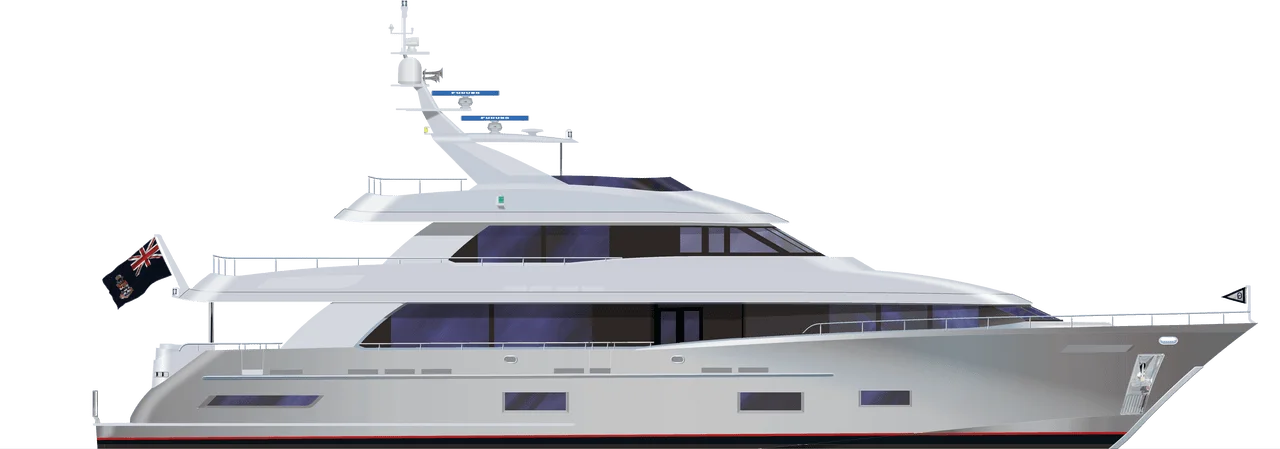
- Explorer Series
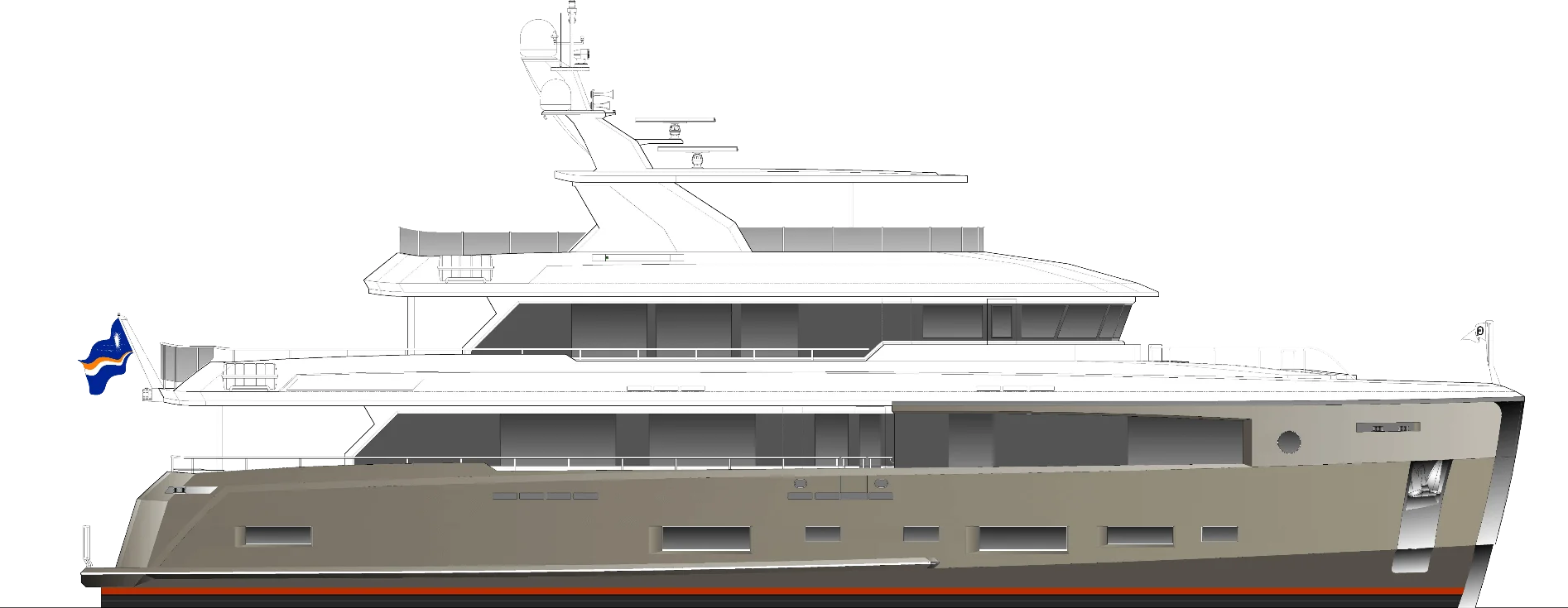
- The Shipyard
- Engineering & Construction
- Service & Warranty

Built for Adventure: Everything You Need to Know About Today’s Explorer Yachts
What is an expedition or explorer yacht .
Most yachts are designed to cruise inland and coastal waterways but in reality, very few are built to voyage the world’s oceans. It is only these bluewater vessels, known as explorer or expedition yachts, that can take you on adventures to the most remote, spectacular, and pristine corners of the globe.
A few decades back, these long-range motoryachts were called “ trawlers ” after the commercial fishing trawlers they often resembled, topped by enclosed pilothouses that frequently featured reverse-slanted, “ North Sea ” windshields. But over the years, the trawler yacht category became crowded with “wannabe” boats that only looked like their rugged offshore counterparts. In reality, many of them were unable to venture very far from the coast.
Enter the true explorer yacht – a vessel that is purpose-built to be seaworthy and self-sufficient enough to serve as a luxury platform for oceangoing expeditions that are virtually without limits.

“ The whole idea of an expedition yacht is how the owner intends to use his or her boat. We are working on the first Cheoy Lee 107 Explorer project now. It’s a boat capable of going practically anywhere in the world ,” said Jon Overing of Overing Yacht Design , the naval architect who collaborated with Cheoy Lee Yachts on its new Explorer Series .
“ The whole idea of an expedition yacht is how the owner intends to use his or her boat. We are working on the first Cheoy Lee 107 Explorer project now. It’s a boat capable of going practically anywhere in the world ”
What gives an expedition yacht “go-anywhere” capability?
It’s not just one single aspect of the vessel’s design, construction, or outfitting. With the world’s best explorer yachts, it’s the entire package.
“ I think any viable explorer yacht has be based on a full-displacement hull. That type of hull makes a better sea boat than a semi-displacement or planing hull … Full displacement hulls also inherently have more volume, and you need more volume to fit the mission profile for an expedition yacht. ”
Rugged and reliable:
What to look for in explorer yacht design and construction, full-displacement hull.

Sufficient speed
Historically, full-displacement vessels tended to be slow through the water, making up in seaworthiness what they lacked in speed. “ The image in everyone’s mind was a 10-knot boat, but it doesn’t have to be that way ,” Overing said. Today’s full-displacement hull designs, notably our fast-displacement hullform that Overing has developed for the Cheoy Lee Explorer Series . Overing’s fast-displacement hull combines superior seakeeping, optimum range and efficiency at 9 to 10 knots with the capability of running over 14 knots if needed to avoid a storm or make up time in a tight itinerary. With a speed/length ratio of 1.6 – 1.7, the Overing fast-displacement hulls are capable of well exceeding theoretical hull speed allowing higher speeds if the owner chooses the higher horsepower options.
Bulbous bow
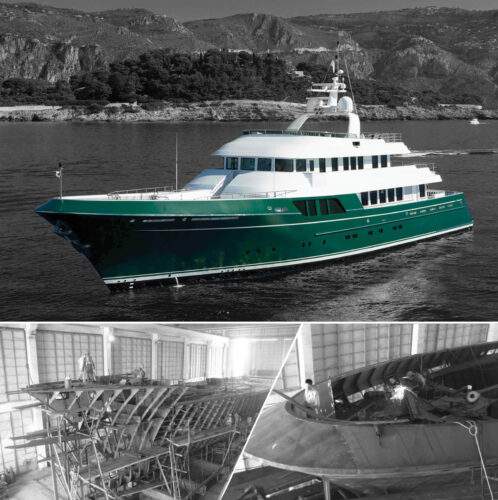
Seaworthiness
Practical profile.
Take the Cheoy Lee Explorer Series , for example. These multi-deck yachts sport graceful superstructures that are skillfully wrought in aluminum by Cheoy Lee Shipyard artisans . They feature spacious on-deck gathering areas, including flybridge, bridge and lower aft deck lounges, designed for sunbathing, dining and entertaining. They even boast aft beach clubs that are ideal for launching myriad watersports adventures.
“The exterior styling of an explorer yacht doesn’t have to look like a tugboat. It can be modern, classic, traditional – however you want,”
At the same time, however, expedition yacht design should address the long, rough passages the yacht will frequently face. Typically, these yachts have high bulwarks, full pilothouses and Portuguese bridges designed to protect the yacht from seas breaking on deck. The new Cheoy Lee Explorer 132 , which features an aft-pilothouse design is an excellent example of form following function while still displaying an eye-catching profile.
High-tech construction.
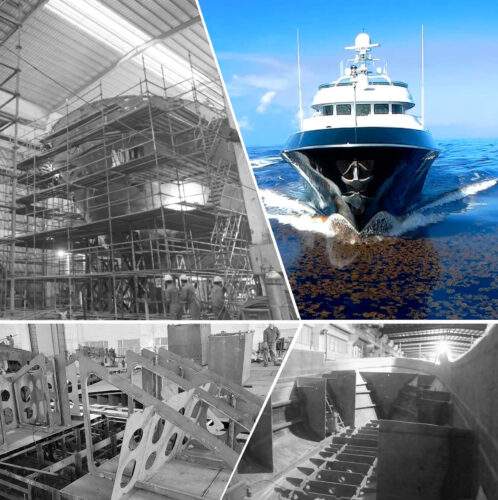
Classification.
“ It’s another system of checks and balances you are bringing into the project. I view it as an insurance policy for the owner ,” Overing said, adding, “ If you are building a good boat to begin with, there’s not a lot of cost difference in building it to class. ” Cheoy Lee Explorer Yachts are available built to Lloyd’s ✠ 100A1 SSC Yacht Mono G6 classification.
Fuel tankage.
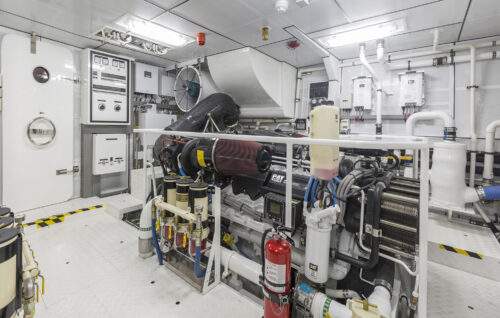
Commercial-grade equipment.
Maximized storage..

Well-laid-out crew areas.
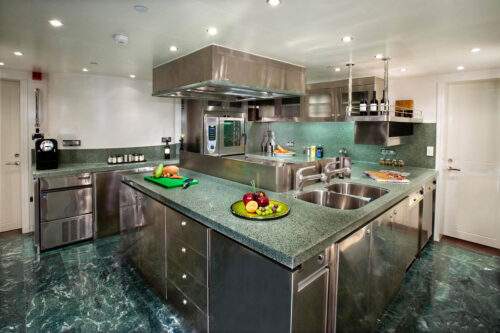
Bespoke owner/guest accommodations.

Satellite communications.
Tenders & toys., have it your way:, building a new explorer yacht.
There are pre-owned expedition yachts on the market today that come in all makes, models, sizes, vintages, and levels of bluewater capability. An owner who elects to purchase a brokerage boat is best advised to develop a mission profile for his or her desired vessel in advance and then choose the boat that ticks off the most boxes on that list. How far do you want to go? How many guests do you want to bring with you? It’s important to determine all your desires and needs before you start shopping for a yacht.
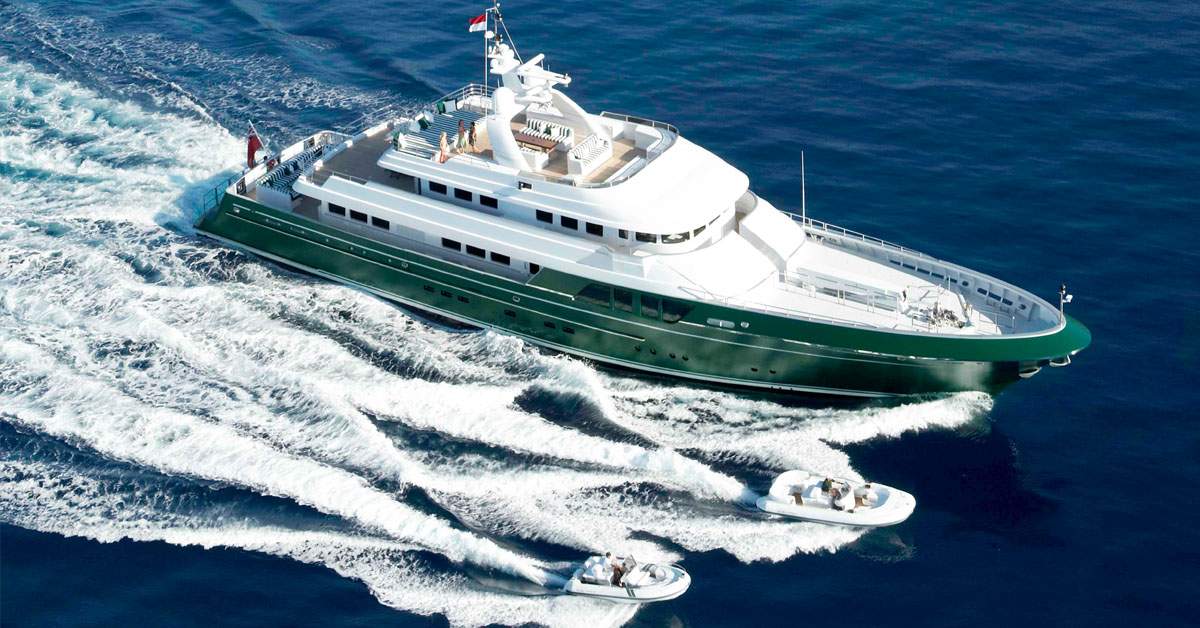
“ It’s always a compromise with a pre-owned explorer yacht. It’s someone else’s design for another owner ,” said Panu Virtanen, vice president – sales, Cheoy Lee Shipyard North America. He added, “ Who built it and how was it built? Does it have maintenance issues? It’s important to find out. ”
Use a surveyor with a proven track record to determine whether there are any hidden problems with the pre-owned yacht. And if you decide to go ahead with the purchase, many brokers recommend keeping a budget in reserve to refit the vessel. You may need to update the electronics and stabilizers, and you probably will want to change at least some of the furnishings and the soft goods. The yacht also may need its classification certificate renewed. “ That can be an expensive process ,” Virtanen cautioned.
Building a new explorer yacht with a reputable shipyard, on the other hand, will ensure you get the vessel that fulfills your individual dreams for global exploration. “ You can get exactly what you want ,” he said.
The shipyard can help you to put together a team dedicated to designing the best expedition boat for your mission profile, including members of the shipyard’s management, design and engineering teams, the yacht’s naval architect and interior designer, along with your captain, yacht broker, and yacht management company, if you so desire. This “ dream team ” will be dedicated to creating an explorer yacht that is unique to you.
“There is no ‘perfect boat’, but when you build one, you can come extremely close to getting the explorer yacht that is perfect for you”
Do you want a main-deck master suite with panoramic views so you can see spectacular scenery you when you wake up each morning? Do you want to be able to cook breakfast for your family yourself in an eat-in galley on a sunny Sunday morning? Would you like to be able to soak in a Jacuzzi on the flybridge, watch a film on the foredeck, or fish from the aft deck? Or do you fancy a beach club where you can lounge virtually at eye level with the sea, hop onto a Jet Ski whenever the mood strikes you, and enjoy a cocktail while your yacht’s underwater lights attract an “ aquarium ” full of exotic fish? “ There is no ‘perfect boat ’, but when you build one, you can come extremely close to getting the explorer yacht that is perfect for you ,” Virtanen said.
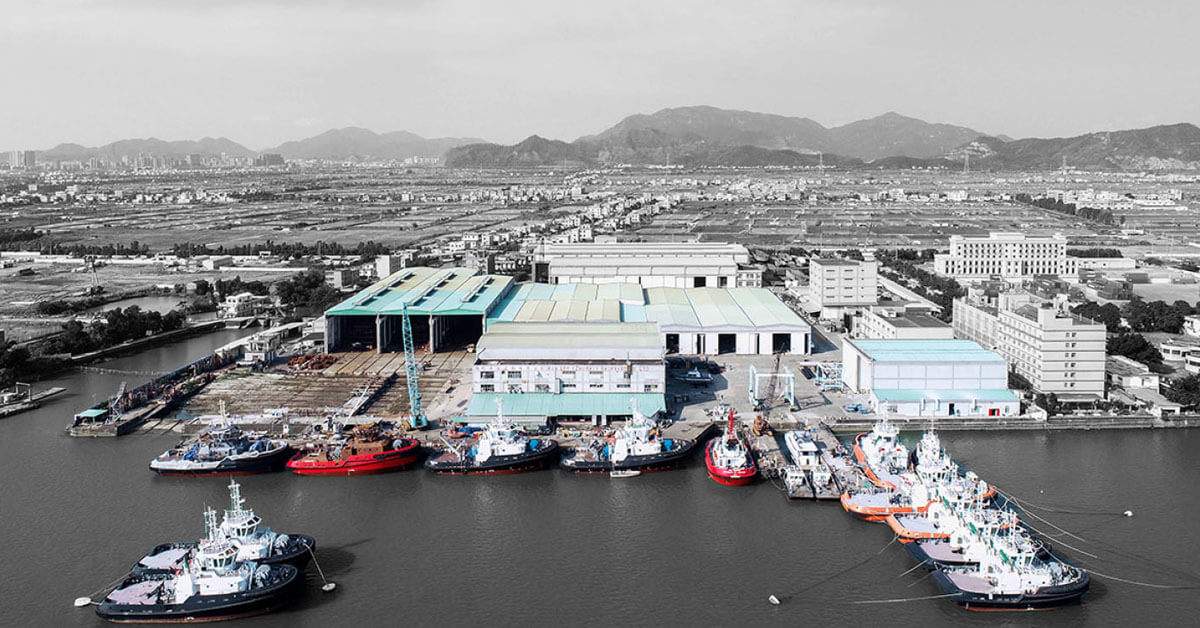
Who builds the best explorer yachts?
If you plan to build a new explorer yacht, it’s important to consider working with a shipyard that has a commercial shipbuilding pedigree in addition to a proven reputation for launching high-quality luxury yachts. Longevity, integrity, and family are key factors behind a successful shipyard. Few shipyards around the globe can boast more than 150 years of experience under continuous operation by the same family, like Cheoy Lee.
“ Cheoy Lee Shipyard has 150 years of experience in building commercial vessels that operate 24/7 in demanding conditions. That is the philosophy of the commercial side of the company, and it carries over to all the explorer yachts that we build as well. ”
It’s also important to research other expedition yachts the shipyard has launched in the past. Have they won awards and voyaged 200,000 nautical miles through most of the world’s oceans in a decade, like the 146’7” Cheoy Lee expedition yacht Dorothea III ?
“If you plan to voyage far, you need to be able to rely on your yacht in any conditions anywhere in the world. That experience is what you look for in a shipyard when you are building a true expedition yacht.”
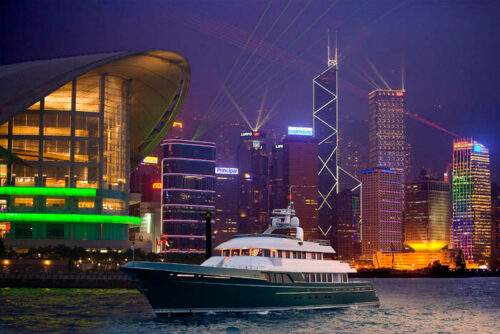
“ Cheoy Lee Shipyard has 150 years of experience in building commercial vessels that operate 24/7 in demanding conditions. That is the philosophy of the commercial side of the company, and it carries over to all the explorer yachts that we build as well ,” Virtanen said. “ If you plan to voyage far, you need to be able to rely on your yacht in any conditions anywhere in the world. That experience is what you look for in a shipyard when you are building a true expedition yacht .”

- Privacy Overview
- Strictly Necessary Cookies
- 3rd Party Cookies
This website uses cookies so that we can provide you with the best user experience possible. Cookie information is stored in your browser and performs functions such as recognising you when you return to our website and helping our team to understand which sections of the website you find most interesting and useful.
Strictly Necessary Cookie should be enabled at all times so that we can save your preferences for cookie settings.
If you disable this cookie, we will not be able to save your preferences. This means that every time you visit this website you will need to enable or disable cookies again.
This website uses Google Analytics to collect anonymous information such as the number of visitors to the site, and the most popular pages.
Keeping this cookie enabled helps us to improve our website.
Please enable Strictly Necessary Cookies first so that we can save your preferences!
Blog posts by SHM

Safe seas, safe shores
Our Mission is to become the leader in creating safe and secure working environments that enable businesses’ freedom at sea and on shore
You are using an outdated browser. Please upgrade your browser to improve your experience.
Exploring the Hull Material Used in Modern Boat Design
India has grown by leaps and bounds as a maritime power in the world. Global trade is one of our chief sources of revenue, facilitated by ships plying across international waters. The increase in demand for faster, better, and safer travel across the seas has inspired engineers and boat designers to try numerous developments in ship design to increase overall efficiency.
The common process of boat manufacturing involves fixed steps, such as, design, procurement of material, fabrication, surface preparation, assembly, painting, outfitting, safety compliance checks, testing, and delivery.
Of these, the design process is the first and the most important step of the cycle.
We have previously seen how ship design has evolved over the centuries, thanks to global events and environmental regulations. The sustainability requirements are especially significant today, given the severe levies for rulebreakers and more importantly, because of the individual sense of responsibility towards environmental conservation. In such a scenario, the chief concern is to design and manufacture boats with a high sustainability value.
They say change starts small. In case of boats, this is true, quite literally!
Some of the principal ways of increasing sustainability are by using eco-friendly boat material and improving the quality of fuels used. Today, we address the different kinds of materials used in boat building and their relative advantages and disadvantages in terms of sustainability.
Materials used in Boat Design
In today’s world, the four main materials used for building boats, when we talk at the level of mass manufacturers, are steel, aluminium, fibre-reinforced plastic (FRP), and polyethylene. Let us speak about each of these in greater detail.
Steel is one of the most popular materials used for boats and has consistently been the material of choice for the past century. Its high strength, durability, resistance to abrasion, and relatively low cost are some of the main reasons why steel is widely used in the industry. However, in the wake of the development of new composite materials, better and cheaper alternatives are being used for manufacturing boats of equal size and strength but considerably lesser weight. This has reduced the importance of steel in boat building to an extent, although it is still used extensively for larger ships.
From the point of view of sustainability, steel has a practically airtight production process that produces minimal constructional waste. In addition, it is completely recyclable at the end of its life cycle and hence is a sustainable material for boats.
Aluminium is preferred by a lot of boat manufacturers on account of its being lightweight, especially when compared to steel. Aluminium boats are more stable and seaworthy and can travel faster due to reduced weight. This means that you get better mileage for the same quantity of fuel from an aluminium boat. Easy workability and its properties like chemical and corrosion resistance, imperviousness to magnetism, and tendency for plastic deformation make aluminium a strong option for boat building.
On the downside, aluminium is expensive. Also, aluminium is a soft metal and hence more susceptible to abrasion. Coming to sustainability, aluminium is recyclable, so that is a point in its favour. Application of eco-friendly paint instead of lead-based paint can be a helpful addition to making an aluminium boat more sustainable.
Fibre-reinforced plastic (FRP)
Fibre-Reinforced Plastic has come to heavily dominate the boat material sector over the past few decades, primarily because it is one of the best options available in the market. A single structure that is light, speedy, strong, watertight, durable, and corrosion-free makes for a great solution. Although initially adopted for military use, FRP has permeated all the levels of maritime applications and is increasingly used as a substitute for wood and steel today.
Economical viability is not one of FRP boats strengths, because though the material required for manufacturing these boats is moderately cheap, the process itself requires skilled labour and a knowledge of boat making principles. However, when you consider the return on investment, FRP boats have a much better ROI on account of their longer life and are hence by far the best building material for boats.
When it comes to sustainability, FRP composites are completely recyclable and have no adverse effects on the marine ecosystem. As a matter of fact, according to this statistic by Boat Digest, 95% of 7 million pleasure boats were built from fibre-reinforced plastic. This high rate of adoption can be attributed to the durability and marine-friendliness of the FRP composite material. Several renowned boat manufacturers in India incorporate FRP into boat manufacturing across all marine verticals.
Polyethylene
Polyethylene is an extremely versatile material that serves boat building well across all marine applications like surveillance, amateur and professional fishing, security, etc. The principal quality of high-density polyethylene is that it has a high strength-to-density ratio. Advanced chemical and impact resistance, low maintenance, and greater buoyancy also make it highly suitable for boat construction. Aesthetically, polyethylene boats are moulded (like FRP) as opposed to fabricated (like aluminium). This implies that complex designs are possible, though tolerances for moulding parts are smaller than those for fitting. The processes used to manufacture polyethylene boats include rotational moulding and thermoforming.
There are some minor disadvantages of polyethylene boat material as well. First, it is not as structurally stiff as aluminium or fibreglass, which limits the number of boats that can be manufactured. Secondly, polyethylene becomes brittle over time, and cannot withstand high temperature without deforming. The biggest drawback is that bonding agents like epoxy resins, adhesives, and vinyl cement do not adhere to polyethylene boats.
From the sustainability perspective, polyethylene is a good choice as it is recyclable. Fuel consumption is reduced due to the lighter weight and lack of hull paint.
Modern boat and ship design incorporates a variety of hull materials, depending on the size, application, and expected life of the vessel. For smaller, recreational or shallow-sea activities, polyethylene boats are a good choice, both environmentally and economically. FRP boats are preferred for activities like coastal patrol, rescue and security operations, and fishing. Wood, steel, and aluminium remain continuing favourites for larger ships transporting cargo.
The choice of material directly impacts the performance and efficiency of the boat, and hence, the environment. It is important that all these factors for improving sustainability be taken into consideration by boat designers and manufacturers to select the best possible alternative for building the boat.
What is your opinion on the materials used for boat building? Any other insight you would like to add? Let us know in the comments section below!
Leave a Reply Cancel reply
Your email address will not be published. Required fields are marked *
Save my name, email, and website in this browser for the next time I comment.

My Cruiser Life Magazine
Basics of Sailboat Hull Design – EXPLAINED For Owners
There are a lot of different sailboats in the world. In fact, they’ve been making sailboats for thousands of years. And over that time, mankind and naval architects (okay, mostly the naval architects!) have learned a thing or two.
If you’re wondering what makes one sailboat different from another, consider this article a primer. It certainly doesn’t contain everything you’d need to know to build a sailboat, but it gives the novice boater some ideas of what goes on behind the curtain. It will also provide some tips to help you compare different boats on the water, and hopefully, it will guide you towards the sort of boat you could call home one day.
Table of Contents
Displacement hulls, semi displacement hulls, planing hulls, history of sailboat hull design, greater waterline length, distinctive hull shape and fin keel designs, ratios in hull design, the hull truth and nothing but the truth, sail boat hull design faqs.

Basics of Hull Design
When you think about a sailboat hull and how it is built, you might start thinking about the shape of a keel. This has certainly spurred a lot of different designs over the years, but the hull of a sailboat today is designed almost independently of the keel.
In fact, if you look at a particular make and model of sailboat, you’ll notice that the makers often offer it with a variety of keel options. For example, this new Jeanneau Sun Odyssey comes with either a full fin bulb keel, shallow draft bulb fin, or very shallow draft swing keel. Where older long keel designs had the keel included in the hull mold, today’s bolt-on fin keel designs allow the manufacturers more leeway in customizing a yacht to your specifications.
What you’re left with is a hull, and boat hulls take three basic forms.
- Displacement hull
- Semi-displacement hulls
- Planing hulls
Most times, the hull of a sailboat will be a displacement hull. To float, a boat must displace a volume of water equal in weight to that of the yacht. This is Archimedes Principle , and it’s how displacement hulled boats get their name.
The displacement hull sailboat has dominated the Maritimes for thousands of years. It has only been in the last century that other designs have caught on, thanks to advances in engine technologies. In short, sailboats and sail-powered ships are nearly always displacement cruisers because they lack the power to do anything else.
A displacement hull rides low in the water and continuously displaces its weight in water. That means that all of that water must be pushed out of the vessel’s way, and this creates some operating limitations. As it pushes the water, water is built up ahead of the boat in a bow wave. This wave creates a trough along the side of the boat, and the wave goes up again at the stern. The distance between the two waves is a limiting factor because the wave trough between them creates a suction.
This suction pulls the boat down and creates drag as the vessel moves through the water. So in effect, no matter how much power is applied to a displacement hulled vessel, it cannot go faster than a certain speed. That speed is referred to as the hull speed, and it’s a factor of a boat’s length and width.
For an average 38 foot sailboat, the hull speed is around 8.3 knots. This is why shipping companies competed to have the fastest ship for many years by building larger and larger ships.
While they might sound old-school and boring, displacement hulls are very efficient because they require very little power—and therefore very little fuel—to get them up to hull speed. This is one reason enormous container ships operate so efficiently.
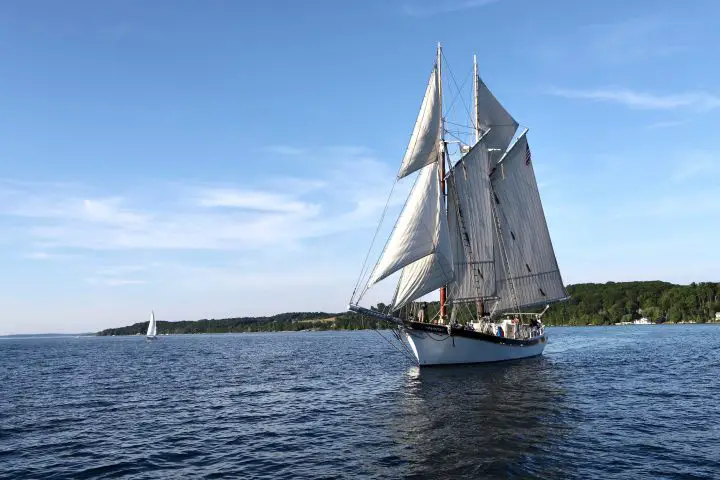
Of course, living in the 21st century, you undoubtedly have seen boats go faster than their hull speed. Going faster is simply a matter of defeating the bow wave in one way or another.
One way is to build the boat so that it can step up onto and ride the bow wave like a surfer. This is basically what a semi-displacement hull does. With enough power, this type of boat can surf its bow wave, break the suction it creates and beat its displacement hull speed.
With even more power, a boat can leave its bow wave in the dust and zoom past it. This requires the boat’s bottom to channel water away and sit on the surface. Once it is out of the water, any speed is achievable with enough power.
But it takes enormous amounts of power to get a boat on plane, so planing hulls are hardly efficient. But they are fast. Speedboats are planing hulls, so if you require speed, go ahead and research the cost of a speedboat .
The most stable and forgiving planing hull designs have a deep v hull. A very shallow draft, flat bottomed boat can plane too, but it provides an unforgiving and rough ride in any sort of chop.
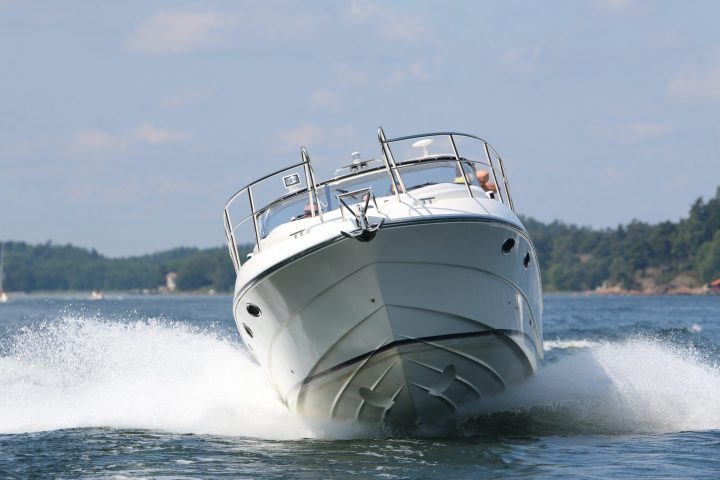
If you compare the shapes of the sailboats of today with the cruising boat designs of the 1960s and 70s, you’ll notice that quite a lot has changed in the last 50-plus years. Of course, the old designs are still popular among sailors, but it’s not easy to find a boat like that being built today.
Today’s boats are sleeker. They have wide transoms and flat bottoms. They’re more likely to support fin keels and spade rudders. Rigs have also changed, with the fractional sloop being the preferred setup for most modern production boats.
Why have boats changed so much? And why did boats look so different back then?
One reason was the racing standards of the day. Boats in the 1960s were built to the IOR (International Offshore Rule). Since many owners raced their boats, the IOR handicaps standardized things to make fair play between different makes and models on the racecourse.
The IOR rule book was dense and complicated. But as manufacturers started building yachts, or as they looked at the competition and tried to do better, they all took a basic form. The IOR rule wasn’t the only one around . There were also the Universal Rule, International Rule, Yacht Racing Association Rul, Bermuda Rule, and a slew of others.
Part of this similarity was the rule, and part of it was simply the collective knowledge and tradition of yacht building. But at that time, there was much less distance between the yachts you could buy from the manufacturers and those setting off on long-distance races.
Today, those wishing to compete in serious racing a building boat’s purpose-built for the task. As a result, one-design racing is now more popular. And similarly, pleasure boats designed for leisurely coastal and offshore hops are likewise built for the task at hand. No longer are the lines blurred between the two, and no longer are one set of sailors “making do” with the requirements set by the other set.
Modern Features of Sailboat Hull Design
So, what exactly sets today’s cruising and liveaboard boats apart from those built-in decades past?
Today’s designs usually feature plumb bows and the maximum beam carried to the aft end. The broad transom allows for a walk-through swim platform and sometimes even storage for the dinghy in a “garage.”
The other significant advantage of this layout is that it maximizes waterline length, which makes a faster boat. Unfortunately, while the boats of yesteryear might have had lovely graceful overhangs, their waterline lengths are generally no match for newer boats.
The wide beam carried aft also provides an enormous amount of living space. The surface area of modern cockpits is nothing short of astounding when it comes to living and entertaining.
If you look at the hull lines or can catch a glimpse of these boats out of the water, you’ll notice their underwater profiles are radically different too. It’s hard to find a full keel design boat today. Instead, fin keels dominate, along with high aspect ratio spade rudders.
The flat bottom boats of today mean a more stable boat that rides flatter. These boats can really move without heeling over like past designs. Additionally, their designs make it possible in some cases for these boats to surf their bow waves, meaning that with enough power, they can easily achieve and sometimes exceed—at least for short bursts—their hull speeds. Many of these features have been found on race boats for decades.
There are downsides to these designs, of course. The flat bottom boats often tend to pound when sailing upwind , but most sailors like the extra speed when heading downwind.
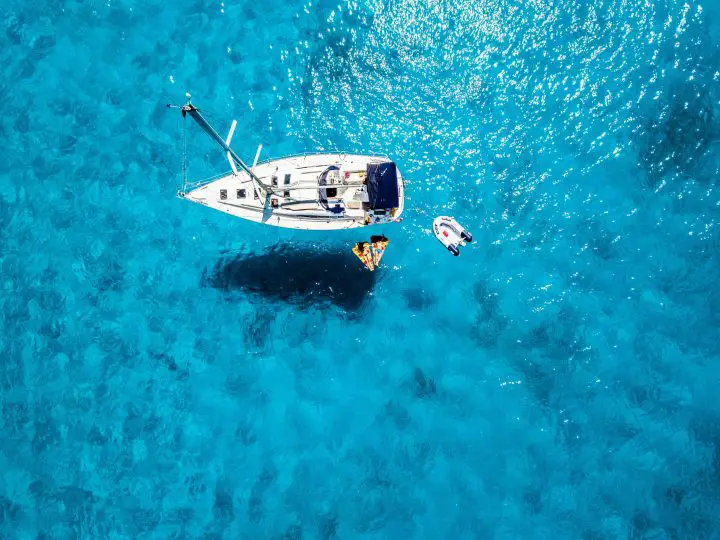
How Do You Make a Stable Hull
Ultimately, the job of a sailboat hull is to keep the boat afloat and create stability. These are the fundamentals of a seaworthy vessel.
There are two types of stability that a design addresses . The first is the initial stability, which is how resistant to heeling the design is. For example, compare a classic, narrow-beamed monohull and a wide catamaran for a moment. The monohull has very little initial stability because it heels over in even light winds. That doesn’t mean it tips over, but it is relatively easy to make heel.
A catamaran, on the other hand, has very high initial stability. It resists the heel and remains level. Designers call this type of stability form stability.
There is also secondary stability, or ultimate stability. This is how resistant the boat is to a total capsize. Monohull sailboats have an immense amount of ballast low in their keels, which means they have very high ultimate stability. A narrow monohull has low form stability but very high ultimate stability. A sailor would likely describe this boat as “tender,” but they would never doubt its ability to right itself after a knock-down or capsize.
On the other hand, the catamaran has extremely high form stability, but once the boat heels, it has little ultimate stability. In other words, beyond a certain point, there is nothing to prevent it from capsizing.
Both catamarans and modern monohulls’ hull shapes use their beams to reduce the amount of ballast and weight . A lighter boat can sail fast, but to make it more stable, naval architects increase the beam to increase the form stability.
If you’d like to know more about how stable a hull is, you’ll want to learn about the Gz Curve , which is the mathematical calculation you can make based on a hull’s form and ultimate stabilities.
How does a lowly sailor make heads or tails out of this? You don’t have to be a naval architect when comparing different designs to understand the basics. Two ratios can help you predict how stable a design will be .
The first is the displacement to length ratio . The formula to calculate it is D / (0.01L)^3 , where D is displacement in tons and L is waterline length in feet. But most sailboat specifications, like those found on sailboatdata.com , list the D/L Ratio.
This ratio helps understand how heavy a boat is for its length. Heavier boats must move more water to make way, so a heavy boat is more likely to be slower. But, for the ocean-going cruiser, a heavy boat means a stable boat that requires much force to jostle or toss about. A light displacement boat might pound in a seaway, and a heavy one is likely to provide a softer ride.
The second ratio of interest is the sail area to displacement ratio. To calculate, take SA / (D)^0.67 , where SA is the sail area in square feet and D is displacement in cubic feet. Again, many online sites provide the ratio calculated for specific makes and models.
This ratio tells you how much power a boat has. A lower ratio means that the boat doesn’t have much power to move its weight, while a bigger number means it has more “get up and go.” Of course, if you really want to sail fast, you’d want the boat to have a low displacement/length and a high sail area/displacement.
Multihull Sailboat Hulls
Multihull sailboats are more popular than ever before. While many people quote catamaran speed as their primary interest, the fact is that multihulls have a lot to offer cruising and traveling boaters. These vessels are not limited to coastal cruising, as was once believed. Most sizable cats and trimarans are ocean certified.
Both catamarans and trimaran hull designs allow for fast sailing. Their wide beam allows them to sail flat while having extreme form stability.
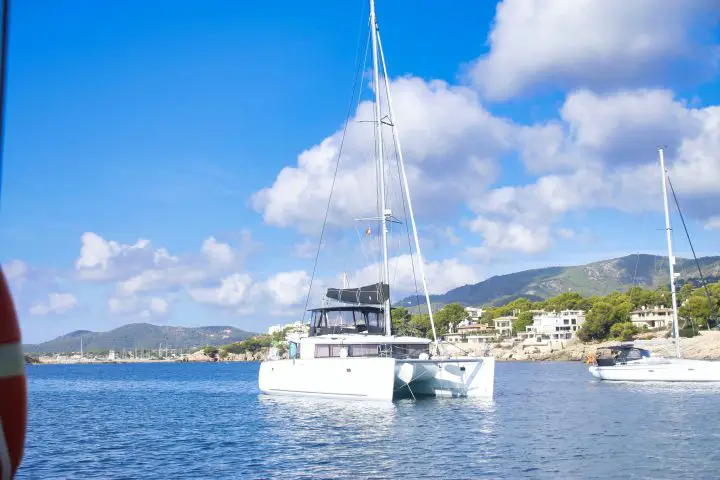
Catamarans have two hulls connected by a large bridge deck. The best part for cruisers is that their big surface area is full of living space. The bridge deck usually features large, open cockpits with connecting salons. Wrap around windows let in tons of light and fresh air.
Trimarans are basically monohulls with an outrigger hull on each side. Their designs are generally less spacious than catamarans, but they sail even faster. In addition, the outer hulls eliminate the need for heavy ballast, significantly reducing the wetted area of the hulls.
Boaters and cruising sailors don’t need to be experts in yacht design, but having a rough understanding of the basics can help you pick the right boat. Boat design is a series of compromises, and knowing the ones that designers and builders take will help you understand what the boat is for and how it should be used.
What is the most efficient boat hull design?
The most efficient hull design is the displacement hull. This type of boat sits low in the water and pushes the water out of its way. It is limited to its designed hull speed, a factor of its length. But cruising at hull speed or less requires very little energy and can be done very efficiently.
By way of example, most sailboats have very small engines. A typical 40-foot sailboat has a 50 horsepower motor that burns around one gallon of diesel every hour. In contrast, a 40-foot planing speedboat may have 1,000 horsepower (or more). Its multiple motors would likely be consuming more than 100 gallons per hour (or more). Using these rough numbers, the sailboat achieves about 8 miles per gallon, while the speedboat gets around 2 mpg.
What are sail boat hulls made of?
Nearly all modern sailboats are made of fiberglass.
Traditionally, boats were made of wood, and many traditional vessels still are today. There are also metal boats made of steel or aluminum, but these designs are less common. Metal boats are more common in expedition yachts or those used in high-latitude sailing.
Matt has been boating around Florida for over 25 years in everything from small powerboats to large cruising catamarans. He currently lives aboard a 38-foot Cabo Rico sailboat with his wife Lucy and adventure dog Chelsea. Together, they cruise between winters in The Bahamas and summers in the Chesapeake Bay.
- 2024 BOAT BUYERS GUIDE
- Email Newsletters
- Boat of the Year
- 2024 Freshwater Boat and Gear Buyers Guide
- 2024 Boat Buyers Guide
- 2024 Water Sports Boat Buyers Guide
- 2023 Pontoon Boat Buyers Guide
- Cruising Boats
- Pontoon Boats
- Fishing Boats
- Personal Watercraft
- Water Sports
- Boat Walkthroughs
- What To Look For
- Best Marine Electronics & Technology
- Watersports Favorites Spring 2022
- Boating Lab
- Boating Safety

Six Amazing Boat Hull Designs
- By Dean Travis Clarke
- Updated: October 25, 2016
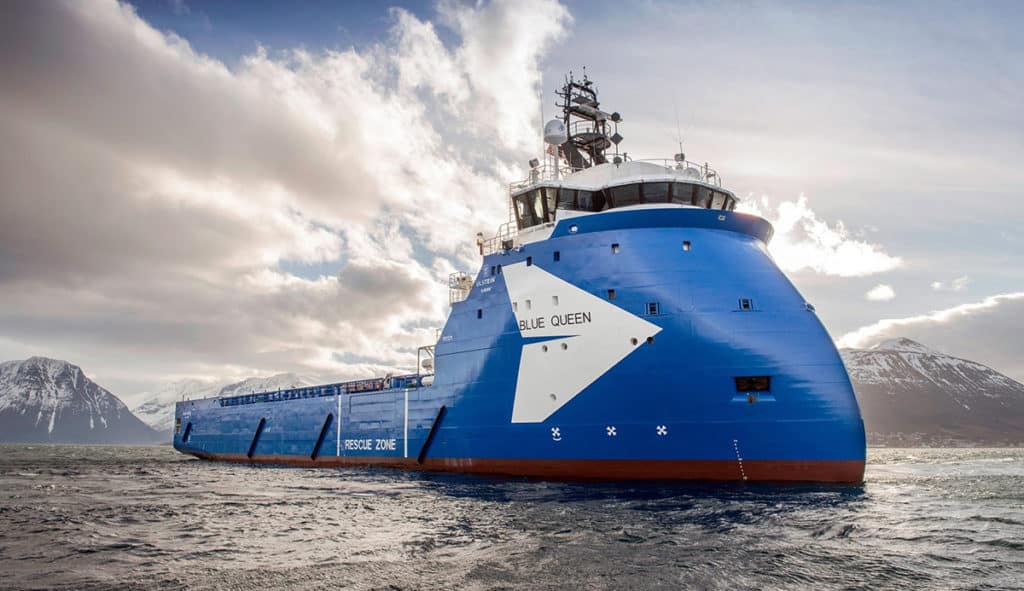
The American boating consumer bears a remarkable psychological profile when it comes to wants and needs.
A cursory glance at the lines of most boats proves that profiles haven’t changed dramatically over the past 60 or so years. Certainly, construction methods such as resin infusion and injection molding have altered business as usual, and ingredients have also changed to include all manner of space-age composites, epoxies, paints, computer mapping for engines that produces vastly greater horsepower from smaller blocks, and so on. Even propulsion has changed with the advent of pod drives and big outboards. But here’s the weird part: Any time a designer or builder introduces a model that looks significantly different, whether it is Euro-styled or functionally clunky, it fails. It doesn’t matter how well the boat performs, the typical boater rejects it because it doesn’t look like what he knows. We, as an enthusiast niche involving boats, are horribly set in our aesthetic ways.
Look at how well multihulls handle heavy seas. When it comes to seakeeping ability, efficiency and performance, the catamaran has a lot going for it, as anyone who happened to catch some of the most recent America’s Cup racing can attest. And yet, to date, production multihulls have enjoyed only moderate acceptance by boaters.
Here are six of the latest hull-design innovations and technologies being used elsewhere in the maritime world that we will likely never accept for our recreational boats — even though they all work well.
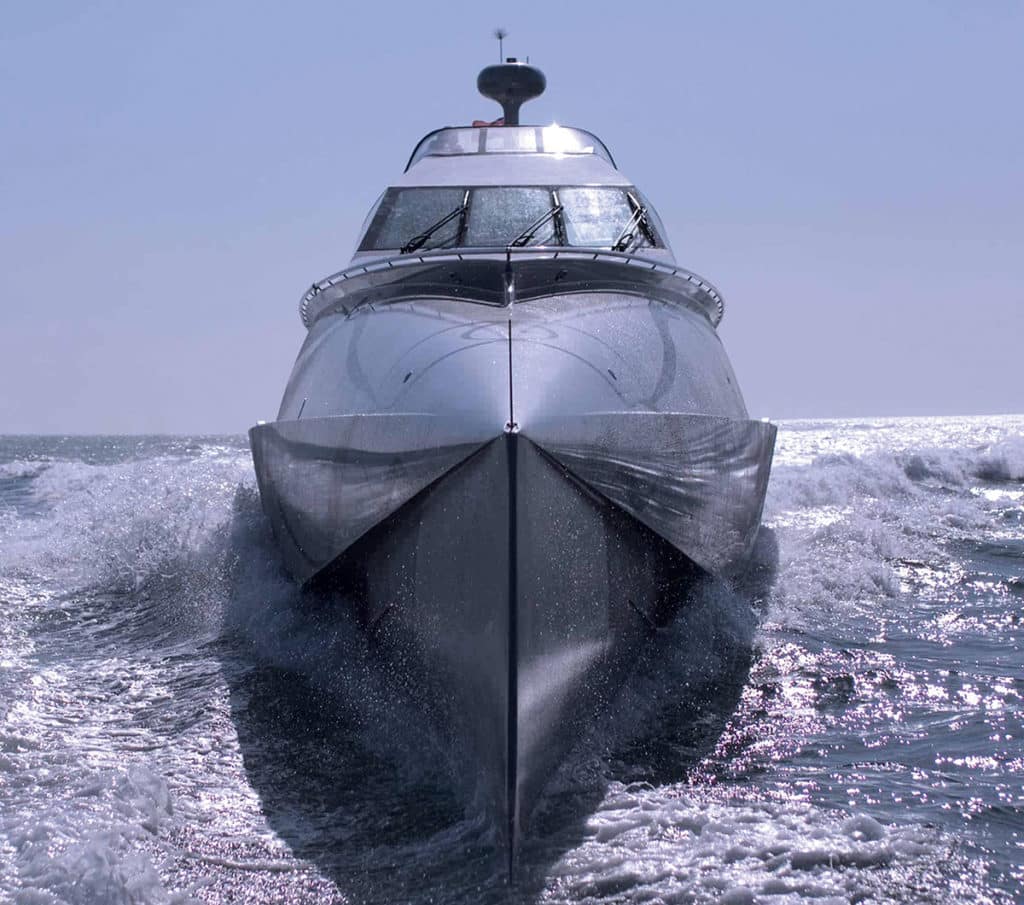
Wave-Piercing Hulls Most accounts cite wave-piercing technology as coming on the scene around the start of the 20th century. However, it has been employed as far back as the times of the Phoenicians and ancient Romans. The design concept consists of a bow with little buoyancy, a hull that slopes inward from the waterline and, ergo, a large reduction in wave-making resistance. While it works well in heavy seas, the drawbacks include reduced interior volume forward and a very wet ride because the waves come up and over the bow as a matter of course. Wave piercers fell out of favor for a period of time due to these same drawbacks but have recently enjoyed a resurgence of popularity because of their dramatic fuel-efficiency gains.
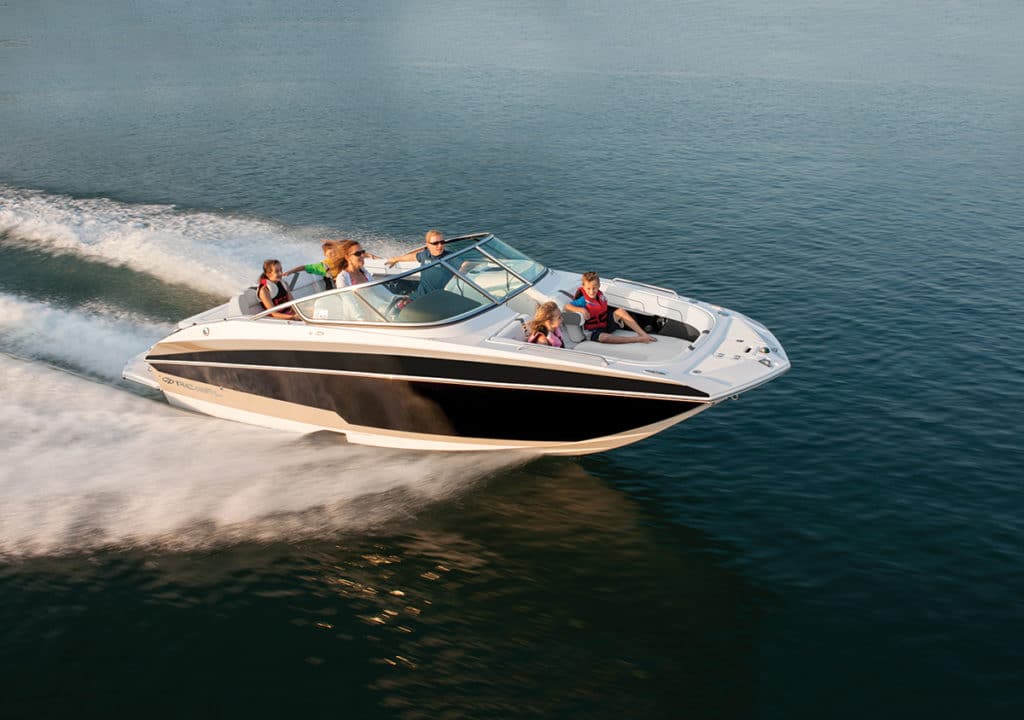
Stepped Hulls OK, this hull form has achieved a certain level of acceptance in our recreational boats, mostly in performance boats or offshore center consoles. But why isn’t it more popular? The stepped bottom has been around as a V-bottom refinement since at least 1912. Steps are grooves in the hull stretching outward from the keel to the chines. Most hulls sport one or two steps per side. And a vessel should really be capable of cruising in excess of about 30 knots for a stepped hull to be worthwhile. Steps work by allowing air to be “injected” against the running surface, breaking contact between part of the hull and the water, which in effect turns the running surface into numerous short, wide planes, rather than one long, narrow one.
How much the hull surface contacts the water directly determines the amount of drag a hull suffers. Steps (also called vents) decrease the amount of hull contacting the water (called the wetted surface), thereby decreasing drag, increasing speed for the same horsepower, and increasing fuel efficiency. It all sounds good. But steps also come with potential drawbacks. Though modern deep-V designs have enough deadrise to counteract the problem in most cases, stepped hulls have been known to suffer from transom slide in sharp turns at speed. They also require attention to loading and trim because the steps need the proper angle of attack to function correctly; they don’t offer an advantage in flat, calm water; and they require a special trailer.
Most owners of stepped-hull vessels are experienced and want to travel at high speeds in moderate to heavy seas, and/or achieve good economy and range. Yet to date, performance and center console builders aside, only Regal Boats, with its FasTrac hulls, and Formula have committed to using steps in production cruisers and sport boats.
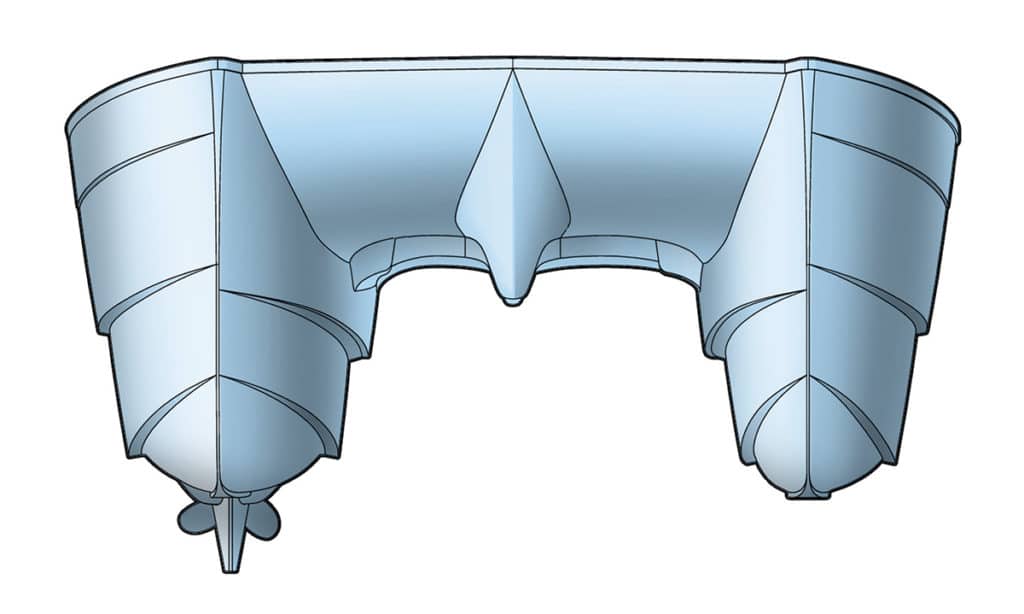
Asymmetrical Twin Hulls This unique design concept comes from the drawing board of Larry Graf, the pioneer who put power catamarans on the map here in the U.S. when he founded Glacier Bay Boats in 1987. His new company, Aspen Powerboats, employs a cat design where one hull is narrower (35 percent) than the other. His patent calls it a Power Proa, and it relies on a single engine in only the wider of the two hulls. The hull shapes, alignment and placement compensate for the offset propulsion thrust, allowing the vessel to run straight and true. With only one set of running gear in the water, inherent appendage drag is reduced by 20 percent. Combined with the efficiency of the hull designs, overall fuel efficiency of the Aspen rises to an impressive 70 percent over monohulls of comparable size. Aspen won an award for the best 30- to 39-foot catamaran in the world in 2014.
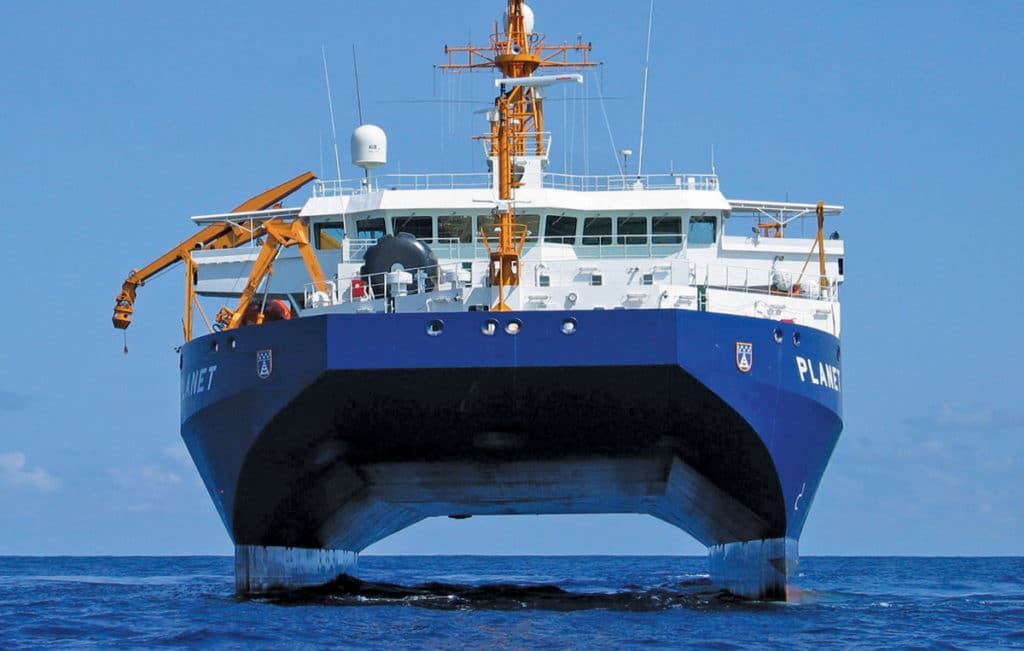
SWATH A quick glance might lead you to believe that a SWATH (small waterplane area twin hull) vessel is a catamaran. And it is but only to the extent that it has two hulls in the water with a bridge across the top. But that’s where the hulls’ similarities end.
Consider a submarine. Once under the surface, it runs stable, with no roll or pitching from wave action. All that wave energy remains on the sea surface. That basically explains how a SWATH design functions.
If you’ve ever dived under a wave at the beach to avoid being smacked by it, you know that the water beneath the wave is calmer. SWATH minimizes a vessel’s volume where the water meets the air (which is where all the wave energy is at its peak). The bulk of the vessel’s displacement and buoyancy runs beneath the waves, affording amazing stability, even in big seas and at high speeds. Please think of high speeds as a relative term here, as this is not a planing hull. What SWATH does provide, however, are a wide, stable deck and unsurpassed ride quality, especially in rough seas.
Drawbacks to SWATH designs include the fact that each hull must be custom designed. Draft runs deeper than standard hulls (especially planing hulls). The underwater “torpedoes” providing buoyancy must run parallel to the water’s surface, which requires a fairly complex trim-control system. And the underside of the deck must be far enough above the sea surface to avoid waves slamming up into it. Finally, SWATH vessels cost more to design and build than conventional hulls.
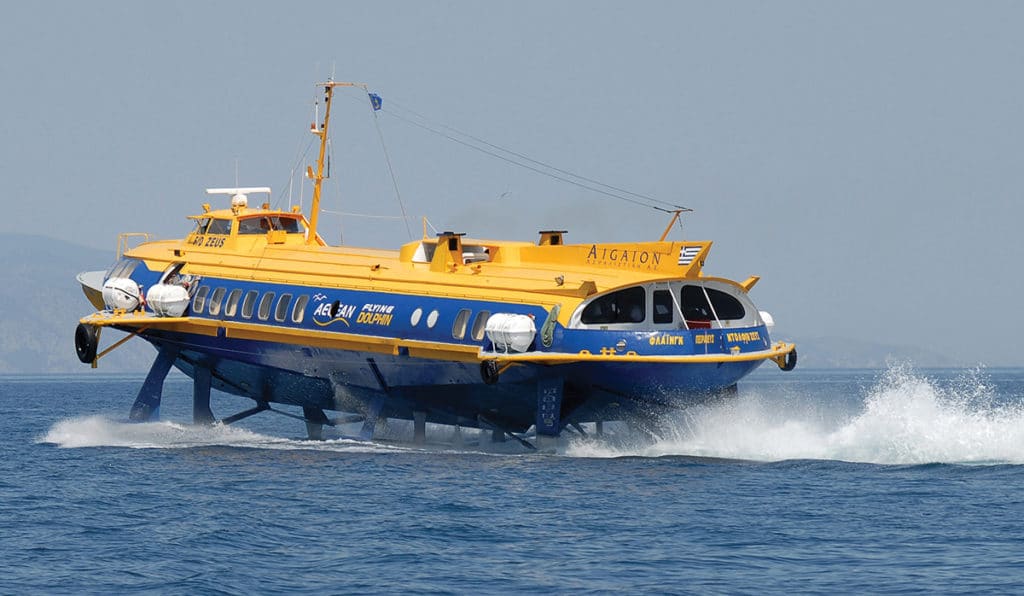
Hydrofoils Once the strict province of commercial ferries and a few high-speed military vessels, the most recent America’s Cup has spurred hydrofoil acceptance to new heights. Will it catch on with powerboats?
The hydrofoil design acts exactly like an airplane wing, providing more lift than the drag coefficient the vessel produces, thereby lifting the entire hull out of the water. Only the hydrofoils remain in the water, unaffected by surface wave action. In fact, hydrofoils cut inherent resistance to zero while the hull is out of the water. In the case of power-driven boats, you still suffer drag from the propulsion system (prop, shaft or the like).
The most significant disadvantage to this system on recreational boats is definitely the deployment of the foils. Unless you want the added draft of these struts sticking down below your hull all the time, you must be able to extend and withdraw them — a complex engineering feat. There is at least one recreational powerboat employing hydrofoils: Twin Vee builds a catamaran with foils that don’t actually lift the hulls completely out of the water. It does improve fuel economy and ride stability nonetheless. Still, boats ride more smoothly in a sea and go much faster with hydrofoils. With the dramatic acceptance of this technology in sailing, is it only a matter of time before recreational powerboats incorporate foils into their designs?
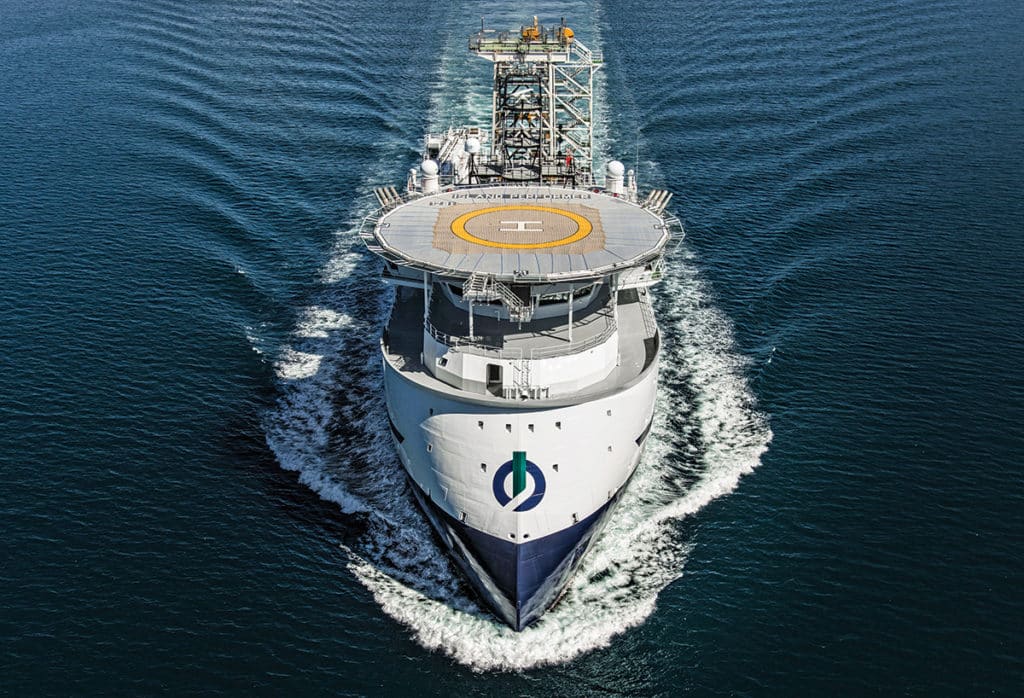
Ulstein X-Bow The Norwegian Ulstein Group has been designing offshore vessels since 1917. Presently, it has the notoriety of creating the most advanced bow design in history. The Ulstein X-Bow looks like it might be upside down, but it’s proven itself in more than 100 offshore support vessels to date. The X-Bow allows higher speeds and smoother rides in even the worst seas. Gone are the slamming and vibration that occur when the bow of a ship drops off a wave. It functions better on all points of sea, and its lower hydrodynamic drag substantially decreases fuel consumption. The X-Bow has proven so successful that Ulstein is in the process of creating an X-Stern design now.
You won’t ever see this on small recreational boats, but you can nod knowingly when someone points one out on a mega-yacht in the near future.
- More: Boats

Catching a Swordfish on a PWC
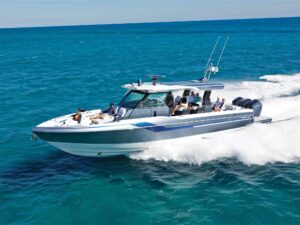
Boat Test: 2024 Formula 457 CCS
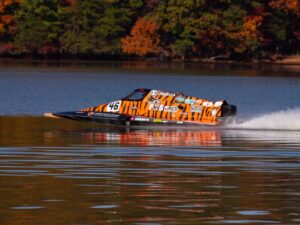
A New Electric-Powered-Boat Speed Record
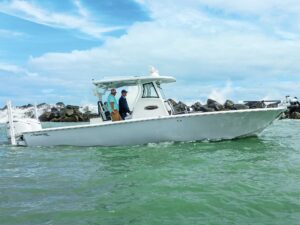
Boat Test: 2024 Tidewater 3100 Carolina Bay
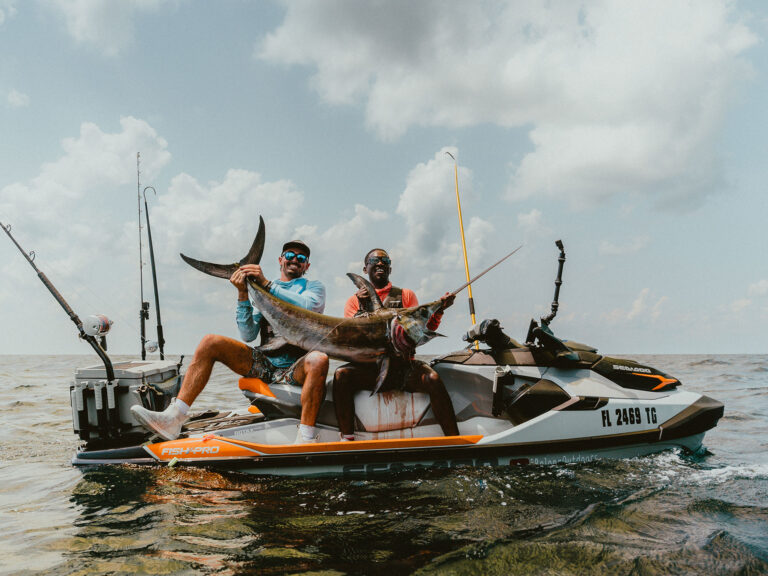
Installing an Electric Motor on a Kayak
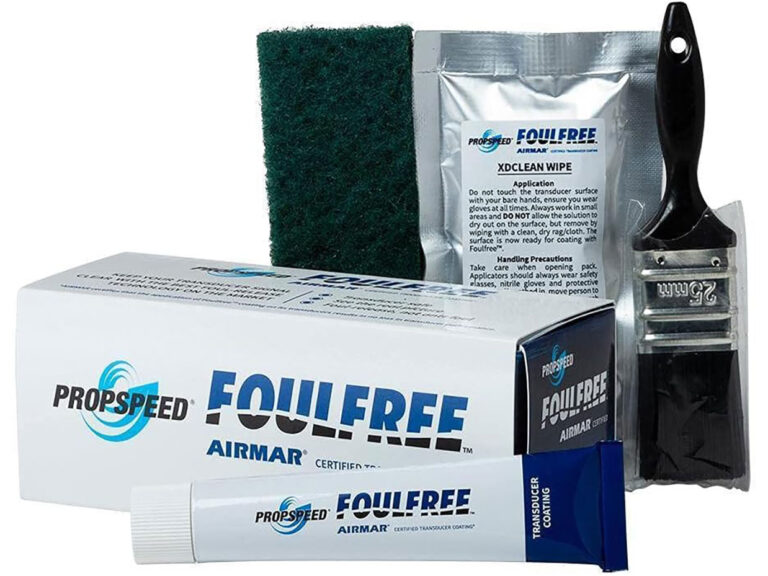
We Test: Foulfree by Propspeed
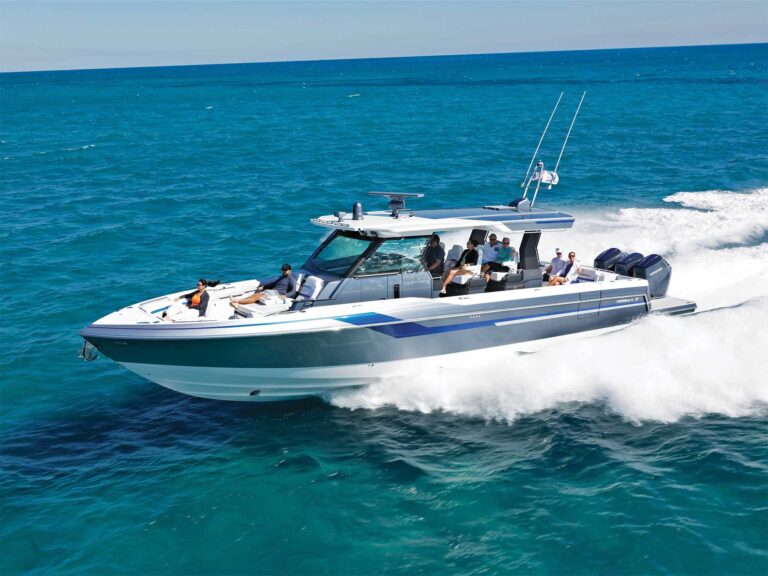
- Digital Edition
- Customer Service
- Privacy Policy
- Cruising World
- Sailing World
- Salt Water Sportsman
- Sport Fishing
- Wakeboarding
Many products featured on this site were editorially chosen. Boating may receive financial compensation for products purchased through this site.
Copyright © 2024 Boating Firecrown . All rights reserved. Reproduction in whole or in part without permission is prohibited.

Materials and Construction: The Key Elements in Yacht Design
Sail design in yacht designers: performance optimization, exterior design in yacht designers: a comprehensive exploration, weight optimization: yacht designers performance optimization, financing options for yacht customization: nautical financing for yacht designers, keel design in yacht designers: performance optimization, color schemes: yacht designers interior design insights, loans for yacht building: yacht designers guide to nautical financing, materials for yacht designers: hull design.

The design of a yacht’s hull plays a crucial role in determining its performance and efficiency on the water. Yacht designers must carefully consider the materials used for constructing the hull to ensure optimal results. This article explores various materials commonly employed by yacht designers for hull construction, highlighting their unique properties and advantages.
For instance, let us imagine a hypothetical scenario where a yacht designer is tasked with developing a high-performance racing yacht. In this case, the choice of material for the hull becomes paramount as it directly impacts speed and maneuverability. The designer may opt for carbon fiber composites due to their exceptional strength-to-weight ratio, enabling them to create an ultra-lightweight yet robust structure. Carbon fiber also possesses excellent stiffness characteristics, making it ideal for creating streamlined shapes that minimize drag and enhance sailing performance.
Factors to consider in yacht hull design
Factors to Consider in Yacht Hull Design
When designing a yacht hull, there are several key factors that yacht designers must take into account. These factors determine the performance, safety, and overall functionality of the vessel. Understanding these considerations is essential for creating a successful design.
One important factor to consider is the hydrodynamics of the hull. The shape and form of the hull greatly influence how it interacts with water, affecting speed, stability, and maneuverability. For instance, a flatter bottom hull may provide better stability at slower speeds but could decrease efficiency at higher speeds due to increased drag. On the other hand, a V-shaped hull can enhance speed by reducing resistance from waves. Therefore, finding the right balance between stability and speed is crucial in achieving optimal performance.
Another critical aspect to address is structural strength. A strong hull ensures durability and longevity while also providing protection against harsh marine environments. This involves selecting suitable materials and construction techniques that offer sufficient strength-to-weight ratio without compromising on other essential properties such as flexibility or corrosion resistance.
Furthermore, weight distribution plays a significant role in determining stability and seaworthiness. Distributing weight evenly throughout the yacht prevents excessive leaning or listing when underway or during adverse weather conditions. By carefully considering factors like fuel capacity placement or equipment layout early in the design process, designers can optimize weight distribution for improved handling and comfort.
To summarize, when designing a yacht hull, various aspects need careful consideration: hydrodynamics for enhanced performance; structural strength to ensure durability; and proper weight distribution for stability at sea. Achieving an optimal balance among these factors will result in a well-designed yacht capable of delivering excellent performance under diverse sailing conditions.
Moving forward into discussing common materials used in yacht hull construction…
Common materials used in yacht hull construction
Factors to Consider in Yacht Hull Design (Continued)
In the previous section, we explored some of the key factors that yacht designers must consider when designing a hull. To further enhance our understanding, let us delve into the common materials used in yacht hull construction.
To illustrate the importance of material selection, let’s consider a hypothetical case study of two yachts built using different materials. Yacht A is constructed from aluminum, known for its strength and durability, while Yacht B is made from fiberglass, renowned for its versatility and lighter weight. Comparing these two vessels highlights how material choices can significantly impact various aspects of yacht design and performance.
When selecting materials for yacht hulls, designers must take into account several considerations:
- Strength: The chosen material should have sufficient structural integrity to withstand stressors encountered at sea.
- Weight: An ideal material strikes a balance between strength and weight to optimize performance without compromising stability.
- Corrosion Resistance: Since yachts are often exposed to saltwater environments, it is crucial to select materials resistant to corrosion.
- Cost-effectiveness: Material expenses play a significant role in overall project budgets; hence, finding cost-effective options is essential.
Now let’s examine a table comparing popular materials used in yacht hull construction:
From this comparison table alone, it becomes evident that each material has distinct advantages and disadvantages that need careful consideration during the design process.
As we move forward with our exploration of yacht hull design, the subsequent section will focus on analyzing the advantages and disadvantages of fiberglass hulls. Understanding these specific attributes is crucial for designers seeking to create vessels that excel in both performance and durability.
Advantages and Disadvantages of Fiberglass Hulls (Continued)
Advantages and disadvantages of fiberglass hulls
Having discussed the common materials used in yacht hull construction, let us now explore the advantages and disadvantages of fiberglass hulls. To illustrate these points, we will consider a hypothetical case study where a yacht designer is deciding on the material for their latest project.
Advantages of Fiberglass Hulls:
- Lightweight: Fiberglass offers excellent strength-to-weight ratio, making it an attractive choice for yacht designers. This characteristic allows for faster speeds, improved fuel efficiency, and better maneuverability.
- Durability: Fiberglass hulls are known for their resistance to corrosion, rotting, and degradation from UV rays. They require minimal maintenance compared to other materials such as wood or metal.
- Design Flexibility: The moldable nature of fiberglass enables designers to create sleek and complex shapes that optimize hydrodynamics and improve overall performance.
- Sound Dampening: Yachts with fiberglass hulls often provide superior noise insulation due to the material’s ability to absorb sound waves.
Disadvantages of Fiberglass Hulls:
- Repair Complexity: While fiberglass is durable, damage can occur through collisions or impact. Repairs may involve specialized skills and equipment since proper techniques must be employed to maintain structural integrity.
- Environmental Concerns: The production process of fiberglass involves the use of resins containing volatile organic compounds (VOCs) which are potentially harmful if not handled properly. Additionally, disposing of damaged fiberglass components can pose challenges from an environmental standpoint.
- Cost Considerations: Building a yacht with a fiberglass hull typically requires more upfront investment than alternative options like aluminum or steel. However, long-term maintenance costs tend to be lower due to its durability.
In summary, fiberglass hulls offer numerous advantages such as being lightweight, durable, and flexible in design. However, they also present challenges related to repair complexity, environmental concerns during production and disposal, as well as higher initial costs.
Moving forward, let us now explore the benefits of aluminum hulls for yacht design.
Exploring the benefits of aluminum hulls
While fiberglass has long been a popular choice for yacht designers due to its advantages, aluminum hulls offer their own unique set of benefits. To illustrate this point, let’s consider a hypothetical scenario where two yachts are subjected to rough sea conditions during a race. The first yacht features a fiberglass hull, while the second one boasts an aluminum hull.
One significant advantage of aluminum hulls is their exceptional strength-to-weight ratio. This characteristic allows designers to create lightweight yet robust structures that can withstand extreme forces encountered at sea. In comparison to fiberglass, which may crack or delaminate under excessive stress, aluminum provides superior durability and resistance against impact. Moreover, the rigidity offered by aluminum contributes to enhanced stability and maneuverability in challenging marine environments.
In addition to strength, another key benefit of aluminum hulls is their excellent corrosion resistance. Saltwater poses a constant threat to any vessel’s structural integrity; however, with proper protective coatings and regular maintenance, aluminum hulls can better resist the corrosive effects caused by prolonged exposure to seawater. This advantage ensures longevity and reduces the need for frequent repairs or replacements.
To further emphasize the advantages of aluminum hulls over other materials used in yacht construction, we present a bullet-point list showcasing some notable aspects:
- Enhanced structural integrity
- Superior impact resistance
- Excellent heat dissipation properties
- Reduced risk of osmotic blistering compared to fiberglass
Furthermore, it is important to acknowledge that each material possesses its own distinct characteristics and considerations when it comes to design choices. To provide readers with a comprehensive overview of available options for yacht construction materials, understanding the properties of carbon fiber will be explored in detail in the subsequent section.
Table: Comparing Fiberglass and Aluminum Hull Characteristics
Understanding the properties of carbon fiber in yacht design, we delve into a material that offers its own set of advantages and considerations for designers seeking optimal performance.
Understanding the properties of carbon fiber in yacht design
Exploring the benefits of aluminum hulls has provided valuable insights into the world of yacht design. Now, let us turn our attention towards understanding the properties of carbon fiber in this field.
Carbon fiber is a material that has gained significant popularity among yacht designers due to its exceptional strength-to-weight ratio and versatility. One example that showcases the advantages of carbon fiber in yacht construction is the case study of “Yacht X.” This luxury vessel was designed with a carbon fiber hull, resulting in reduced weight and enhanced performance on the water. By utilizing carbon fiber, Yacht X achieved greater speed and fuel efficiency compared to traditional materials like steel or fiberglass.
When considering carbon fiber for yacht hull design, there are key factors to take into account:
- Strength: Carbon fibers have higher tensile strength than many other materials used in yacht construction.
- Weight reduction: The lightweight nature of carbon fiber allows for improved maneuverability and increased payload capacity.
- Corrosion resistance: Unlike metals such as steel or aluminum, carbon fiber does not corrode when exposed to saltwater environments.
- Design flexibility: Carbon fiber can be molded into various shapes and structures, offering endless possibilities for innovative yacht designs.
To further highlight the attributes of carbon fiber in comparison to other materials commonly used in yacht hulls, consider the following table:
As we delve deeper into innovations in composite materials for modern yacht hulls, it becomes evident that advancements in carbon fiber technology have revolutionized the industry. The utilization of this material allows for improved performance, durability, and aesthetics in yacht design.
Innovations in composite materials for modern yacht hulls offer exciting possibilities to further enhance vessel performance. By exploring these advancements, we can gain valuable insights into how new technologies are shaping the future of yacht design. So let us move forward and delve into the world of innovative composites that continue to push the boundaries of what is possible in the construction of yacht hulls.
Innovations in composite materials for modern yacht hulls
Understanding the properties of carbon fiber in yacht design has been crucial for modern yacht designers. However, the advancements in composite materials have led to innovations in hull design that are worth exploring further.
One notable example is the use of Kevlar fibers in combination with carbon fiber composites. This hybrid material offers a unique blend of strength and flexibility, making it ideal for high-performance yacht hulls. A case study conducted by a leading yacht manufacturer demonstrated how incorporating Kevlar into the construction of their racing yachts improved both speed and durability. The result was a significant reduction in weight without compromising structural integrity, allowing for enhanced maneuverability on the water.
To better understand these innovative materials and their impact on yacht hull design, it is important to examine their key characteristics:
- Strength: Carbon fiber composites possess exceptional tensile strength, enabling them to withstand high levels of stress without deformation or failure.
- Lightweight: Compared to traditional materials like steel or aluminum, carbon fiber composites offer superior strength-to-weight ratios, resulting in lighter vessels that can achieve greater speeds.
- Corrosion resistance: Unlike metals that may deteriorate over time when exposed to saltwater environments, composite materials are highly resistant to corrosion, ensuring longer-lasting hulls.
- Design flexibility: Composite materials can be molded into various shapes and sizes, providing designers with more freedom to create streamlined hull forms that optimize hydrodynamics and improve performance.
By harnessing the advantages offered by advanced composite materials such as carbon fiber-Kevlar hybrids, yacht designers have been able to push the boundaries of what is achievable in terms of speed, efficiency, and overall vessel performance.
This table highlights the significant differences between traditional materials and advanced composites. It is evident that carbon fiber-Kevlar hybrids offer exceptional strength at a significantly lower weight compared to steel or aluminum, making them an attractive choice for yacht designers seeking optimal performance.
Incorporating innovative composite materials into yacht hull design allows for enhanced speed, durability, and overall vessel efficiency. As technology advances and new materials emerge, it will be interesting to see how these developments continue to shape the future of yacht design. The utilization of high-performance composites not only revolutionizes the present state but also paves the way for further advancements in this field of engineering excellence.
Related posts:
Form stability in yacht designers: hull design, hull design: insights for yacht designers.
- Hydrodynamics and Yacht Designers: Hull Design
Performance: The Intricacies of Yacht Designers Hull Design
Previous materials and construction: the key elements in yacht design, this is the most recent story., victoria j. manzo, related posts.

Weight Distribution and Hull Design: Insights for Yacht Designers
Suggested posts.

Window Treatments: Enhancing Yacht Interiors with Elegant Designs

Yacht Financing for First-Time Buyers: Nautical Financing

Insurance Coverage for Yacht Design: Nautical Financing

Composite Materials in Yacht Designers: Materials and Construction

Textile Choices in Yacht Designers Interior Design: The Essentials
More stories.

Interior Design in Yacht Designers: A Guide to Elegant and Functional Spaces
lady lara yacht ibiza
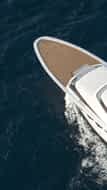
- Impressions

At 91 meters in length, Lady Lara is an ultramodern superyacht with sweeping curves and an elegantly balanced profile. Dynamic, sculpted features carry through her exterior and interior design, by Reymond Langton Design. Exceptional features include a large waterside beach club, VIP guest suites with fold down balconies and extensive spa and treatment facilities. Her on-board atmosphere is bright, with inviting interior spaces and a subtle selection of light complementary finishes enhancing the open areas. Generous exterior decks offer range of options for guests to enjoy, from sun-drenched, open entertainment areas to more sheltered, intimate formal spaces.
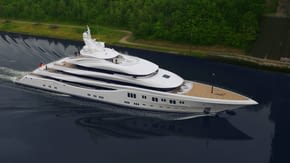
Do you wish to talk about yacht design?
We would love to hear from you

Try now - Live tracking map for yachts and other vessels
Real time world map for tracking yachts and all other vessels like speed boats, cargo or tankers! Tracking yachts and other vessels was never so easy!
Lady Lara Mega Yacht
LADY LARA – Lurssen – 91 m – 2015 TOP SPEED 18 kn GUESTS 14 CREW 19 CRUISE SPEED 12 kn BEAM 14.35 m GUEST CABIN 7
Lady Lara Accommodation
Lady Lara’s interior configuration has been designed to comfortably accommodate up to 14 guests overnight in 7 cabins. She is also capable of carrying up to 19 crew onboard to ensure a relaxed luxury yacht experience.
Lady Lara Mega Super Yacht, is a motor yacht built in 2015 by Lürssen in Schacht-Audorf. She is owned by Israeli/Kazakh billionaire Alexander Mashkevitch. With an overall length of 91.00 m (298.56 ft) and a beam of 14.82 m (48.6 ft).
An ultra modern super yacht
Built under codename Orchid, Lady Lara has a full displacement hull, aluminium superstructure and a 14.35 metre beam. Exterior and interior design comes from the boards of Reymond Langton Design, a decision influenced by the desire to create a harmonious balance between spaces inside and out.
Zero speed stabilizers, elevator, beach club, helicopter landing pad on the bow, spa, swimming platform, tender garage with tender, air conditioning, on deck jacuzzi, gym, BBQ, underwater lights.
Her on-board atmosphere is bright, with inviting interior spaces and a subtle selection of light complementary finishes enhancing the open areas. Generous exterior decks offer range of options for guests to enjoy, from sun-drenched, open entertainment areas to more sheltered, intimate formal spaces.
Information about Lady Lara
Sweeping, sculpted curves give Lady Lara a feminine elegance and the interior reportedly flows just as sinuously. Lady Lara is a private yacht and following her maiden voyage to Norway, she headed to Florida, the Bahamas and the Eastern Caribbean islands for the winter season.
Lady Lara features a displacement steel hull and aluminium superstructure, with teak decks. She was built to Lloyds Register classification society rules.
This luxury yacht is also fitted with ‘zero speed stabilizers’ which work at anchor, increasing on-board comfort when the yacht is stationary, particularly in rough waters.
Lady Lara owner information
Who is alexander mashkevitch.
Mashkevich was born in Frunze, Kyrgyz SSR, Soviet Union, in 1954. His father Anton, a doctor born in Lithuania, and his mother, Rakhel Yoffe, a lawyer born in Vitebsk, were evacuated to Kyrgyzstan in 1941. His family background is Lithuanian Jewish.
He is a graduate of Kyrgyz State University where he studied philology. Mashkevich started out an academic career but became a businessman during perestroika. Mashkevich, Patokh Chodiev, and Alijan Ibragimov form “the Trio,” a group of Kazakh businessmen who became billionaires. The Trio gained control of the recently privatized chromium, alumina, and gas operations in Kazakhstan (some of the largest ones in the world).
Mashkevich is one of the owners of Alferon Management. Based in London, Alferon Management has acquired mining operations in different places: Zambia, the Democratic Republic of Congo, Indonesia, Kosovo, Russia, and other countries.
In 2010 he was on the Forbes list of billionaires at #287. In 2017, he was on the list at #1098, with a worth of $1.9 billions. Now his worth is 3 billion dollars.
Superyacht Tracker: Real-Time Insights into Biggest Yacht Locations
Serenity yacht: your gateway to unparalleled ocean elegance, octopus super yacht is like a small island in the ocean, sunseekeer 116 super yacht, mega yacht ocean victory made by fincantieri, mega yacht al lusail, beautiful watercraft from lürssen shipyard, flying fox super yacht -the best luxury yacht experience, dubai yacht – sheikh mohammed transatlantic vessel, mega yacht black pearl – beauty of the seas, titania super yacht – former apoise, aurora super yacht – candy for the eyes, sustainable superyacht design: pioneering innovation in lürssen think tank, superyacht lana: luxury redefined, tis yacht (ona) – owner alexei fedorychev, khalifa bin zayed al nahyan super yacht azzam, luxury yachting world: a glimpse into the azzam superyacht, madame kate location – real time superyacht locator, related images:, share this with your friends:.
- Yacht Tracking Map Find mega yacht
- Fun Map Map The World
- Privacy Policy

More About LADY LARA
LADY LARA Yacht
Motoryacht lady lara.
The LADY LARA yacht is a 298.6ft / 91m luxury yacht for sale, built and launched by yacht builder Lurssen . Delivered to a proud yacht owner in 2015 and refit in 2023, this luxury yacht sleeps up to 16 guests in 8 staterooms and has accommodations for 29 crew. She has a beam of 47.1ft / 14.4m, a draft of 13.1ft / 4m, and she measures in at 2,945 gross tons. Her hull is steel and her decks are teak. Her max speed is 17 knots and cruising speed is 14 knots. She is propelled by MTU engines. Her interior design is by Reymond Langton Design with exterior styling by Reymond Langton Design .
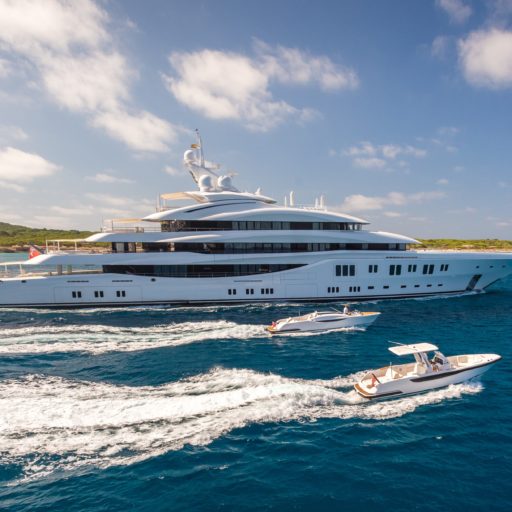
Download PDF Brochure

Download PDF Brochure ,
Specifications
Page contents.
- LADY LARA yacht location
- Yachts for sale
Contact: Merle A. Wood | mwood(Contact us at)merlewood.com | +1-954-525-5111
* - Exclusions include all of Owner's personal effects and artwork - Not offered for sale or charter to U.S. residents while in U.S. waters unless under a boat show bond or in an FTZ.
Related Yacht Ownership | Why Buy A Yacht | How To Buy A Yacht | Build Your Own Yacht
LADY LARA Yacht Photos
View the photo gallery page to browse all the LADY LARA yacht photos , including interior and exterior images.
LADY LARA Yacht Video
View the LADY LARA yacht video . ,
LADY LARA Yacht Price & Rate
Eur usd gbp sar cny brl chf rub aud.
select a currency

ASKING PRICE
Send Enquiry
CHARTER RATE
When it comes to purchasing a luxury yacht, like the yachts themselves, pricing may vary greatly. When evaluating the LADY LARA yacht price and similar yachts for sale, the industry knowledge of Merle Wood & Associates will help you with everything you need to know in order to make the right decisions when buying a luxury yacht. If you’d like to know the availability of the LADY LARA yacht for charter and the weekly rate, view the LADY LARA yacht charter price and summary .
LADY LARA Amenities & Features
Water Sports & Tenders
Features & Entertainment
For a complete list of amenities available or for a first-hand review of the LADY LARA, simply request assistance from our qualified luxury yacht brokers. Our team of yacht specialists travel the world visiting and experiencing yachts for sale. Because of this, they have expert knowledge about every yacht for sale, and can provide further details about the features and amenities aboard LADY LARA.
LADY LARA Yacht Specifications
More details.
We provide accurate specifications, details and current information on yachts for sale around the world. Read the detailed LADY LARA yacht specs and analysis.
LADY LARA Yacht Location
In Caribbean
Read more about the cruising grounds, winter or summer itinerary and the last known LADY LARA yacht location .
LADY LARA Yacht For Sale Enquiry
For more information and expert knowledge about the LADY LARA luxury yacht for sale, from a qualified yacht broker , simply contact the luxury yacht brokerage firm of Merle Wood & Associates for assistance.
- 1-954-525-5111
- web(Contact us at)merlewood.com
- About us
I'm interested in:
Chartering a yacht Buying a yacht Selling a yacht Charter marketing Building a yacht Other
Please leave this field empty.
More Yachts For Sale & For Charter
Luxury Yachts For Sale
The LADY LARA has been displayed to provide our visitors the most current and accurate data for this luxury yacht. If you would like to report an error or have additional information, including photos and video, related to the LADY LARA, please contact our luxury yacht intelligence team .
At Merle Wood & Associates, we focus on providing the best user experience throughout our website for our visitors. We achieve this by using cookies, which store a little information from your browser. If you would like to learn more, please see our privacy and cookies policy .
Share this page

- Yacht Search
- Charter a Yacht
- Buy A Yacht
- Build a Yacht
- Sell a Yacht

Your Name (required)
Your Message
Please call me Please email me
Your Phone (required)
CANCEL Please leave this field empty.
Please use a modern browser to view this website. Some elements might not work as expected when using Internet Explorer.
- Landing Page
- Luxury Yacht Vacation Types
- Corporate Yacht Charter
- Tailor Made Vacations
- Luxury Exploration Vacations
- View All 3565
- Motor Yachts
- Sailing Yachts
- Classic Yachts
- Catamaran Yachts
- Filter By Destination
- More Filters
- Latest Reviews
- Charter Special Offers
- Destination Guides
- Inspiration & Features
- Mediterranean Charter Yachts
- France Charter Yachts
- Italy Charter Yachts
- Croatia Charter Yachts
- Greece Charter Yachts
- Turkey Charter Yachts
- Bahamas Charter Yachts
- Caribbean Charter Yachts
- Australia Charter Yachts
- Thailand Charter Yachts
- Dubai Charter Yachts
- Destination News
- New To Fleet
- Charter Fleet Updates
- Special Offers
- Industry News
- Yacht Shows
- Corporate Charter
- Finding a Yacht Broker
- Charter Preferences
- Questions & Answers
- Add my yacht
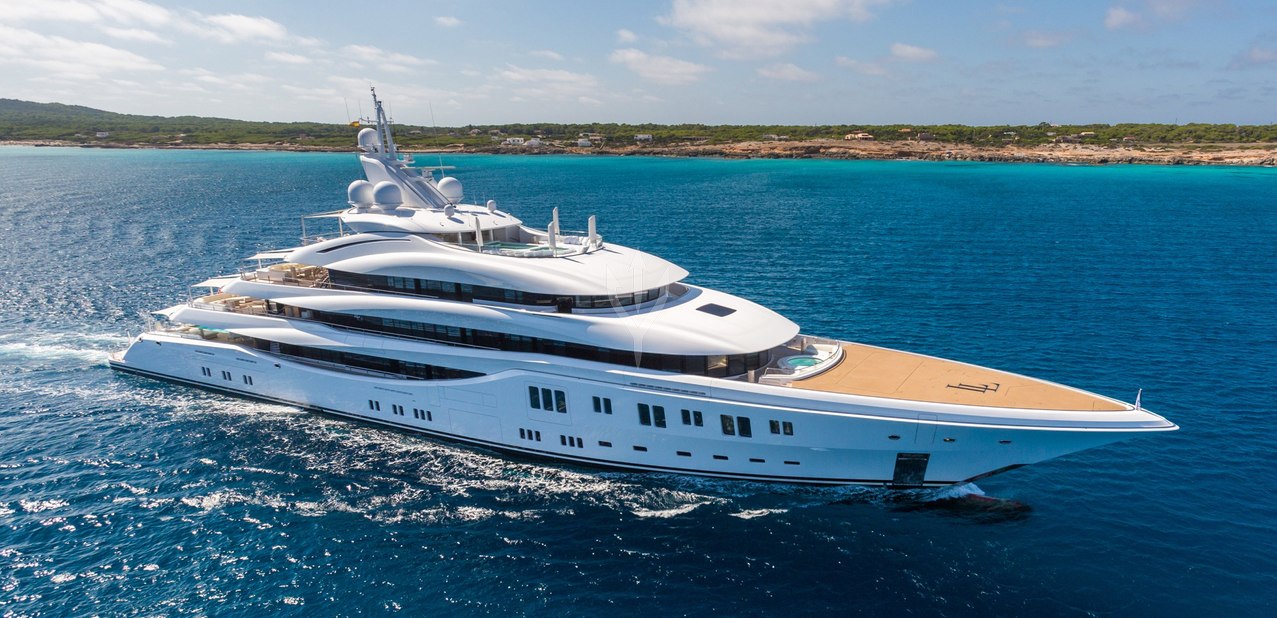
View More Photos
- Luxury Charter Yachts
- Motor Yachts for Charter
- Amenities & Toys
- Rates & Regions
- + Shortlist
LADY LARA YACHT CHARTER
91m / 298'7 lurssen 2015 / 2023.
- Previous Yacht
Special Features:
- Guest elevator
- Master cabin with dressing room, his/her en suite and study
- Impressive 6,000nm range
- Cutting-edge toy selection
- Recent refit in 2023
With plenty of onboard entertainment, motor yacht Lady Lara is an exceptional yacht charter choice
The award winning 91m/298'7" motor yacht 'Lady Lara' by the German shipyard Lurssen offers flexible accommodation for up to 12 guests in 8 cabins and features interior styling by British designer Reymond Langton Design.
Built in 2015, Lady Lara is designed for exquisite indoor/outdoor living and boasts voluminous interior and exterior spaces across several decks: ideal for bronzing, lounging or entertaining. She has sensational features such as a dancefloor, beauty salon, movie theatre, spa, elevator, underwater lights, beach club and gym.
Guest Accommodation
Lady Lara offers guest accommodation for up to 12 guests in 8 suites. The master suite incorporates its own study and dressing room as well as a his and her bathroom. There are up to twenty-seven crew members on board to provide outstanding service on your charter.
Onboard Comfort & Entertainment
On your charter, you'll find plenty to keep you busy and entertained including a dancefloor where you and your guests can celebrate in style. A piano is also present to create a fantastic atmosphere or you can recreate the full cinema experience while at sea with the included movie theatre. Meanwhile the latest beauty and hair treatments are available in the luxurious beauty room and in addition take a break from a busy itinerary in the steam room. Soothe tired limbs and reinvigorate yourself in the sauna and kick back and relax in the well-appointed spa. Take a plunge in the pool under the sun plus head to the beach club and take advantage of indoor-outdoor living and entertaining. Maintain your fitness routine and work out in the well-equipped gym or elsewhere, retreat to the deck jacuzzi and soak up the scenery.
Whatever your activities on your charter, you'll find some impressive features are seamlessly integrated to help you including an elevator, making any part of the yacht quickly and easily accessible. Make your evenings more memorable with stunning underwater lights or whether you want to work, use social media or stream movies on board this yacht, you can with Wi-Fi connectivity. Guests will experience complete comfort while chartering thanks to air conditioning.
Performance & Range
Built with a steel hull and aluminium superstructure, she offers greater on-board space and is more stable when at anchor thanks to her full-displacement hull. Powered by twin MTU engines, she comfortably cruises at 12 knots, reaches a maximum speed of 17 knots with a range of up to 6,000 nautical miles from her 220,000 litre fuel tanks at cruising speed. Lady Lara features at-anchor stabilizers providing exceptional comfort levels.
Lady Lara knows a thing or two about fun on the water, with an extensive selection of action packed water toys and accessories for you and your guests to enjoy whilst on charter. Take to the sea on the Jet Skis offering you power and control on the water. Also there are towable toys offering fun and adventure. Additionally, there are waterskis that are hugely entertaining whether you are a beginner or a seasoned pro. If that isn't enough Lady Lara also features a seabob, wakeboards, kayaks, wakesurf boards, fishing equipment and much more. Lady Lara features three tenders, but leading the pack is a 9.1m/29'10" Compass Tenders Limo Tender to transport you in style.
Book your next the Caribbean luxury yacht charter aboard Lady Lara this winter. She is already accepting bookings this summer.
Luxury motor yacht Lady Lara is one of a kind, offering world-class onboard amenities coupled with an overflowing toy box full of the latest water sports gear for unforgettable yacht charters wherever you are.
TESTIMONIALS
There are currently no testimonials for Lady Lara, please provide .
Lady Lara Photos
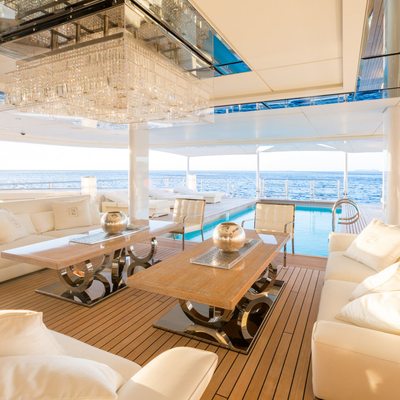
Amenities & Entertainment
For your relaxation and entertainment Lady Lara has the following facilities, for more details please speak to your yacht charter broker.
Lady Lara is reported to be available to Charter with the following recreation facilities:
- 1 x Lift E-foil
- 1 x 9.1m / 29'10 Compass Tenders 9.1M Limo Tender
- 1 x 9.1m / 29'10 Compass Tenders Open Tender
- 1 x 11.6m / 38'1 Compass Tenders 11.6M Limo Tender
For a full list of all available amenities & entertainment facilities, or price to hire additional equipment please contact your broker.
Lady Lara Awards & Nominations
- Asia Boating Award 2016 Best Yacht Design Winner
- + shortlist
For a full list of all available amenities & entertainment facilities, or price to hire additional equipment please contact your broker.
'Lady Lara' Charter Rates & Destinations
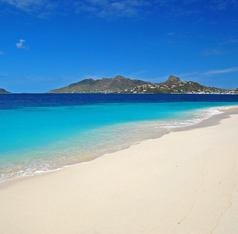
Winter Season
October - April
$1,400,000 p/week + expenses
High Season
Cruising Regions
Caribbean Antigua, Bahamas, Saint Martin, St Barts
HOT SPOTS: Virgin Islands
Charter Lady Lara
To charter this luxury yacht contact your charter broker , or we can help you.
To charter this luxury yacht contact your charter broker or
Update your yacht
Yacht Owner, Captain or Central Agents - Send us latest Photos, Charter Rates or Corrections Contact Us
SIMILAR YACHTS FOR CHARTER
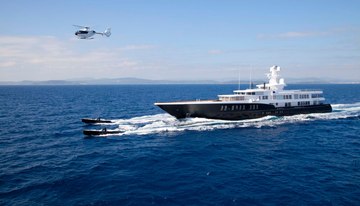
81m | Feadship
from $1,007,000 p/week ♦︎

78m | Abeking & Rasmussen
from $770,000 p/week
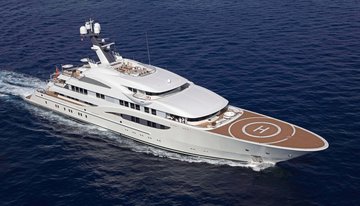
85m | Lurssen
from $0 p/week ♦︎
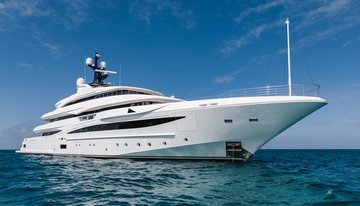
from $991,000 p/week ♦︎
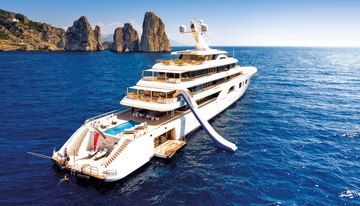
92m | Feadship
from $1,500,000 p/week
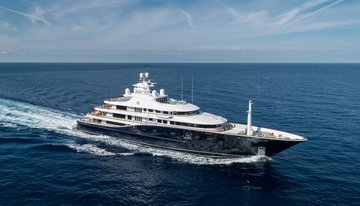
86m | Derecktor Shipyards
from $945,000 p/week
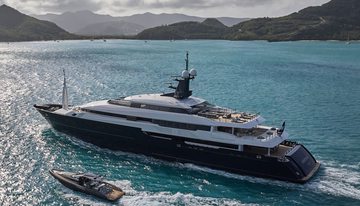
from $600,000 p/week
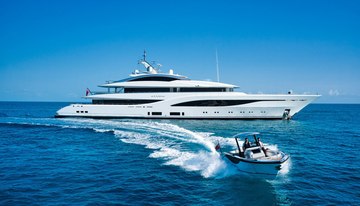
75m | Feadship
from $900,000 p/week *
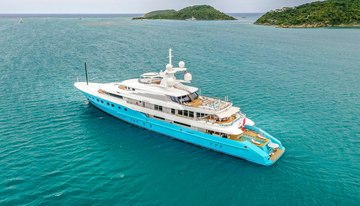
72m | Dunya Yachts
from $660,000 p/week
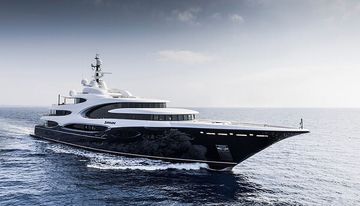
89m | Oceanco
from $1,100,000 p/week
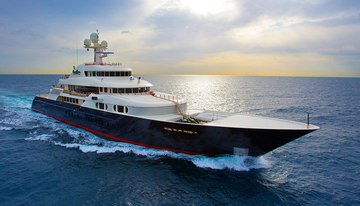
74m | Trinity Yachts
from $599,000 p/week ♦︎

90m | Oceanco
from $1,307,000 p/week ♦︎
NOTE to U.S. Customs & Border Protection
Specification
SEASONAL CHARTER RATES
- Share on Facebook
- Share Yacht
SIMILAR LUXURY CHARTER YACHTS
Here are a selection of yachts which are similar to the current charter yacht. To view all similar luxury charter yachts click on the button below.

As Featured In
The YachtCharterFleet Difference
YachtCharterFleet makes it easy to find the yacht charter vacation that is right for you. We combine thousands of yacht listings with local destination information, sample itineraries and experiences to deliver the world's most comprehensive yacht charter website.
San Francisco
- Like us on Facebook
- Follow us on Twitter
- Follow us on Instagram
- Find us on LinkedIn
- Add My Yacht
- Affiliates & Partners
Popular Destinations & Events
- St Tropez Yacht Charter
- Monaco Yacht Charter
- St Barts Yacht Charter
- Greece Yacht Charter
- Mykonos Yacht Charter
- Caribbean Yacht Charter
Featured Charter Yachts
- Maltese Falcon Yacht Charter
- Wheels Yacht Charter
- Victorious Yacht Charter
- Andrea Yacht Charter
- Titania Yacht Charter
- Ahpo Yacht Charter
Receive our latest offers, trends and stories direct to your inbox.
Please enter a valid e-mail.
Thanks for subscribing.
Search for Yachts, Destinations, Events, News... everything related to Luxury Yachts for Charter.
Yachts in your shortlist

The Stunning Ritz Carlton EVRIMA Yacht
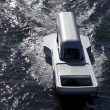
Gliding Across Tokyo’s Sumida River: The Mesmerizing Zipper Boat
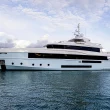
CROCUS Yacht: An 48 Meter Beauty by Admiral
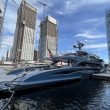
PHI Yacht – Royal Huisman’s $45 Million Superyacht
- Zuretti Interior Design
- Zuretti Interior
- Zuccon International Project
- Ziyad al Manaseer
- Zaniz Interiors. Kutayba Alghanim
- Yuriy Kosiuk
- Yuri Milner
- Yersin Yacht
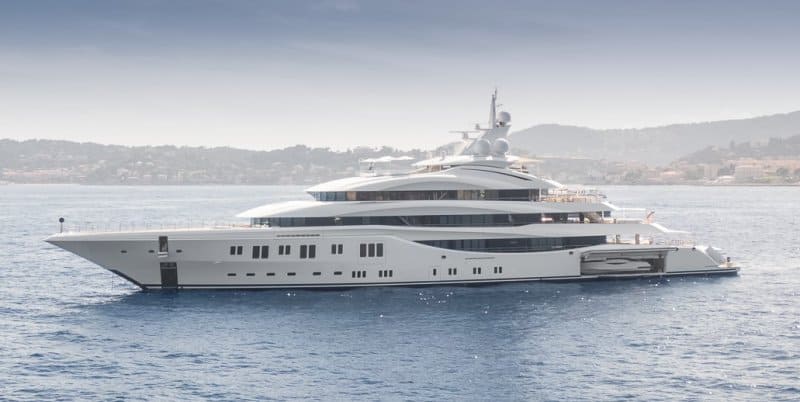
- Superyachts
LADY LARA Yacht – Surreal $180M Superyacht
The incredible 91m yacht features interior and exterior design from Reymond Langton Design with sumptuous designs inside and out.
Lürssen delivered her from their Rendsburg shipyard in 2015. The fantastic vessel offers incredible spaces for guests to enjoy the superyacht lifestyle on board.
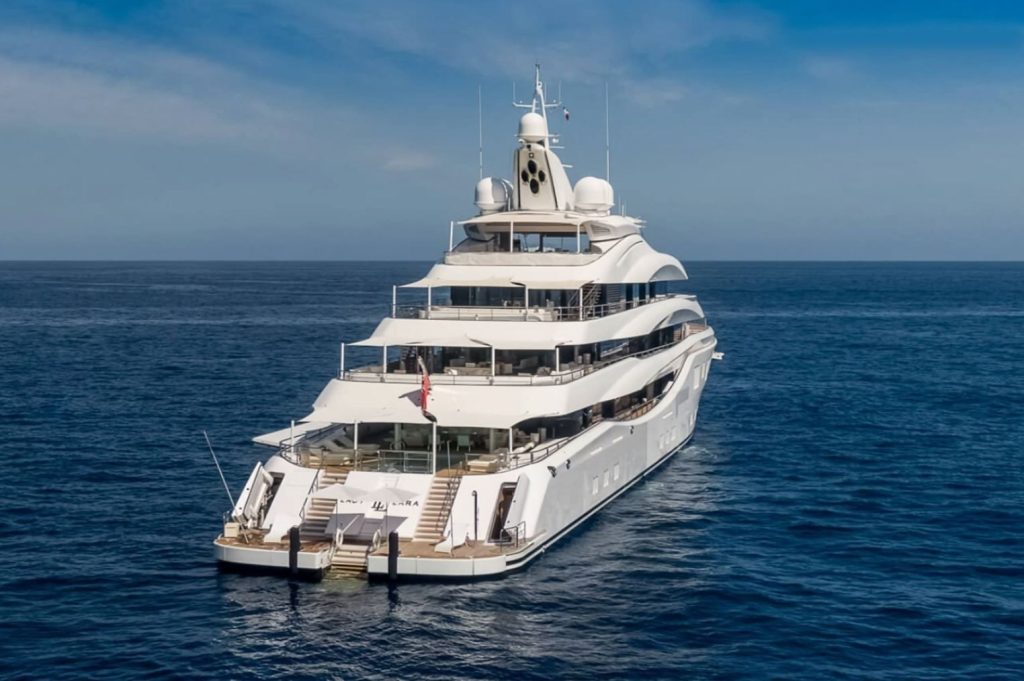
LADY LARA yacht interior
The incredibly designed LADY LARA yacht features an interior style from Reymond Langton Design .
She has accommodations for 18 guests and 19 crew members on board. The VIP suites have fold-down balconies that add to the grandeur.
The onboard atmosphere is bright and inviting with subtle finishes. The entertainment areas are open to provide more sheltered and intimate formal spaces.
The yacht has an extensive health and beauty center with a spa and an expansive beach club.
The beach club creates the perfect area for guests to enjoy indoor/outdoor living. There is also a swimming platform where guests can leap into the water below.
She has an on-deck jacuzzi to soak up the bubbles and the views. The yacht also has an elevator for convenient access to her different decks and a comprehensive gym onboard. The tender garage is brimming with towable toys and tenders.
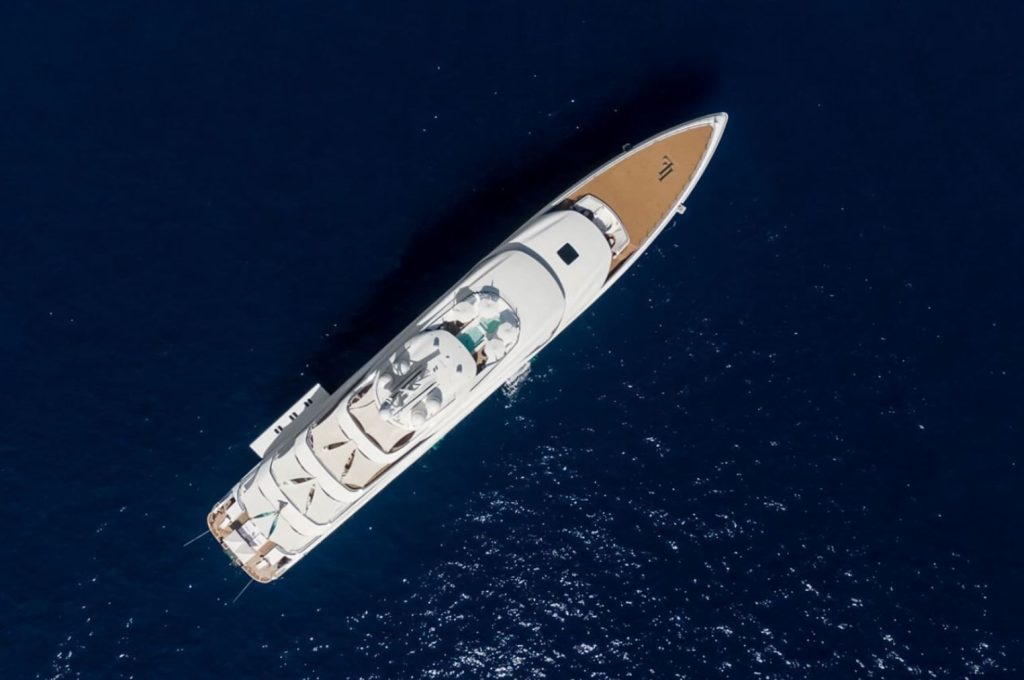
Reymond Langton Design also contributed to the exterior design of the LADY LARA yacht. She was built by Lürssen and delivered from their Rendsburg shipyard in 2015. The exterior has sweeping curves and elegant but masculine features.
LADY LARA was code-named project Orchid when she was launched from the Lürssen Shipyard in 2015 and later renamed. She has a full displacement hull which gives her exceptional speeds in the water.
She has a white aluminum superstructure and teak decks throughout. The exterior is accented by underwater lights, which illuminate her at the night.
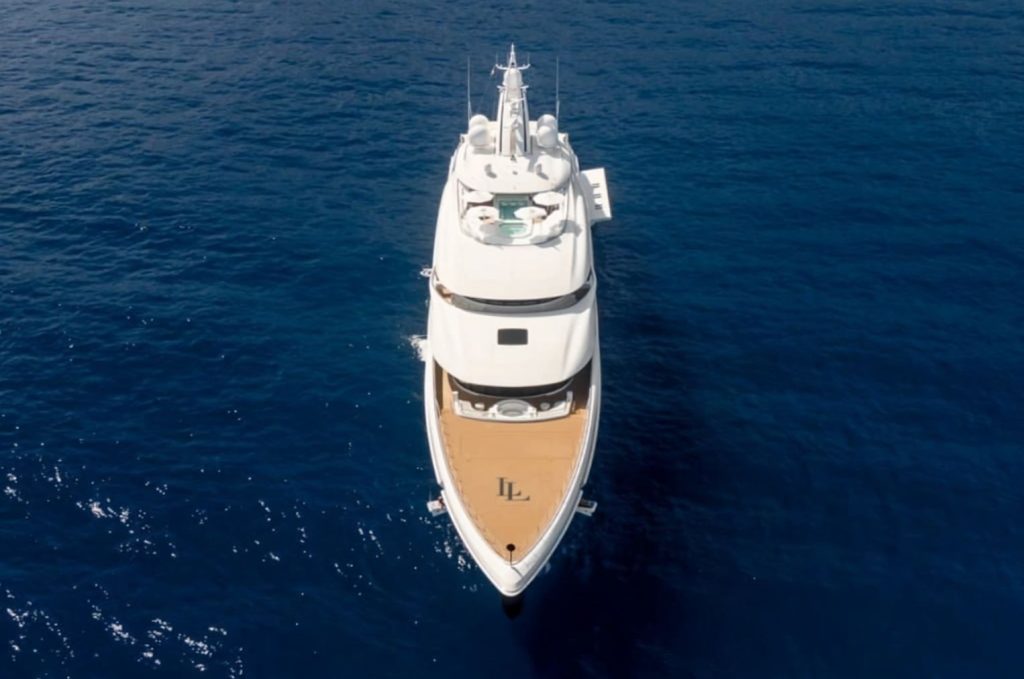
The LADY LARA yacht is a 91m superyacht with a beam of 14.82m and a draft of 4m. The vessel reaches a maximum speed of 18 knots and a cruising speed of 14 knots.
She is powered by 2 MTU engines and has a displacement of 2,945 gross tons.
She features an advanced stabilization system that provides guests with the best comfort levels on board by minimizing the rolling motion of the vessel. The $180 million yacht has a $14 – $15 million annual running cost.
She is an award-winning yacht that holds an award from the Asia Boating competition in 2016. LADY LARA has a Lloyd’s Register classification.
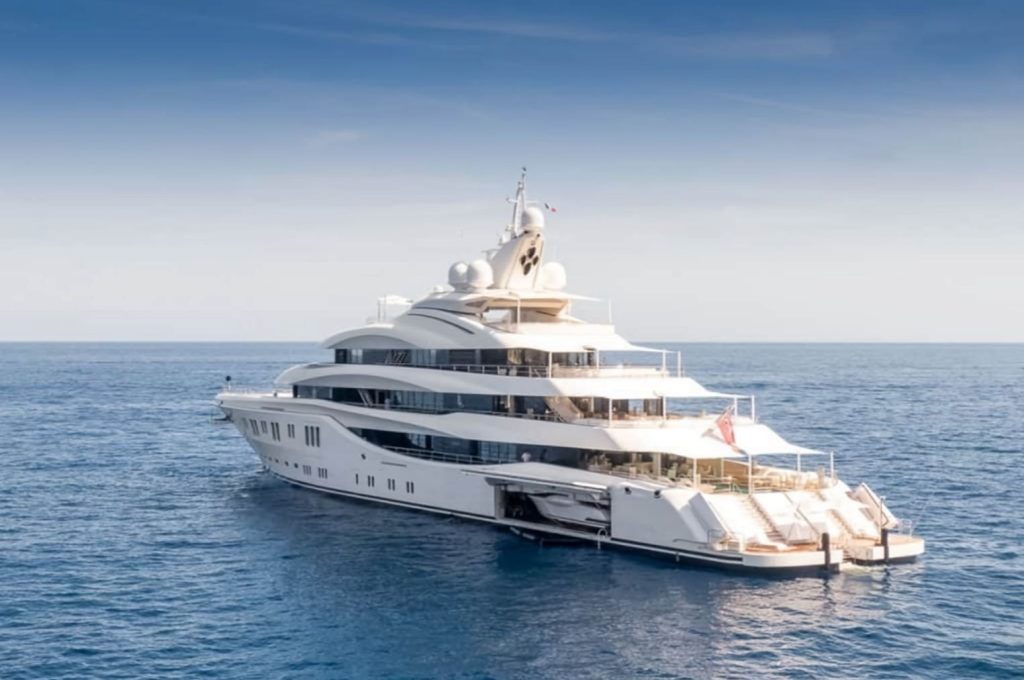
LARA yacht departing Gibraltar
Do you have anything to add to this listing?
- Reymond Langton Design
Love Yachts? Join us.
Related posts.
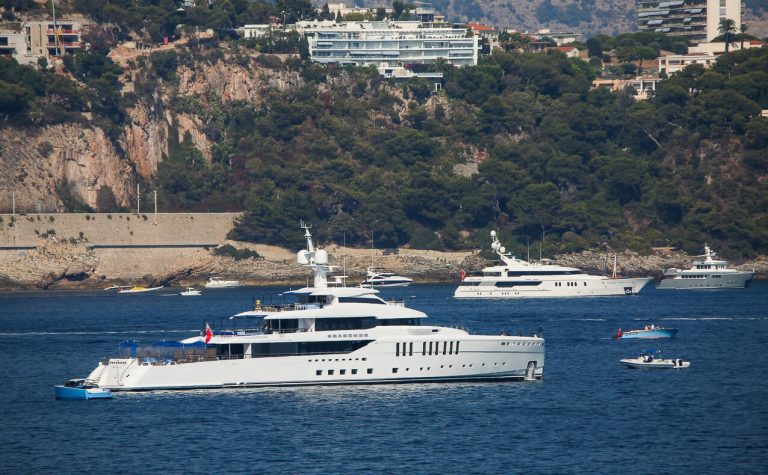
SEASENSE Yacht – Fantastic $65 M Superyacht
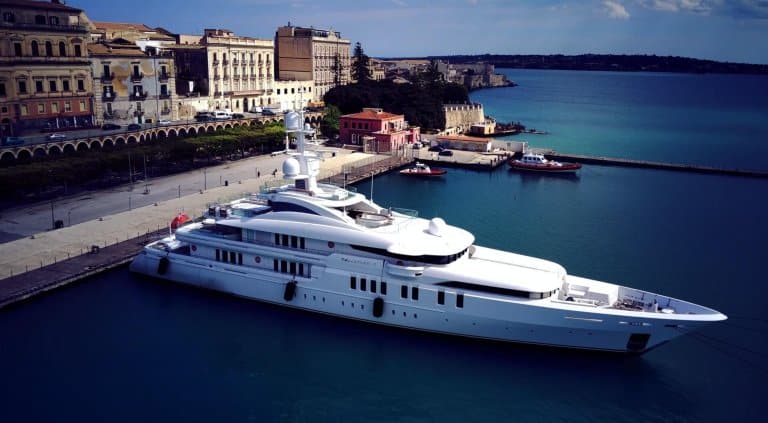
TALISMAN C Yacht – Unimaginable $60M Superyacht
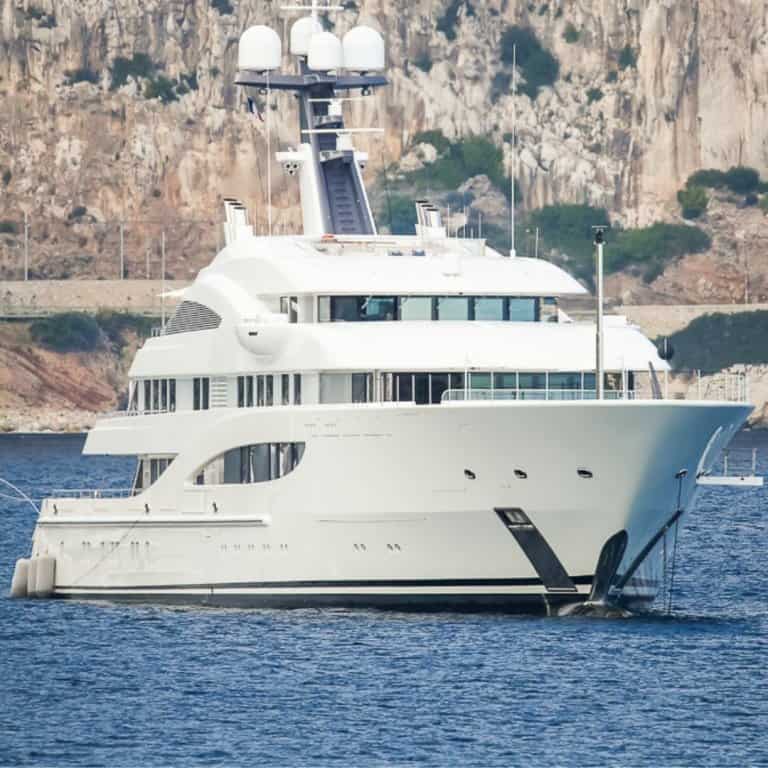
AMATASIA Yacht – Gorgeous $200M Superyacht
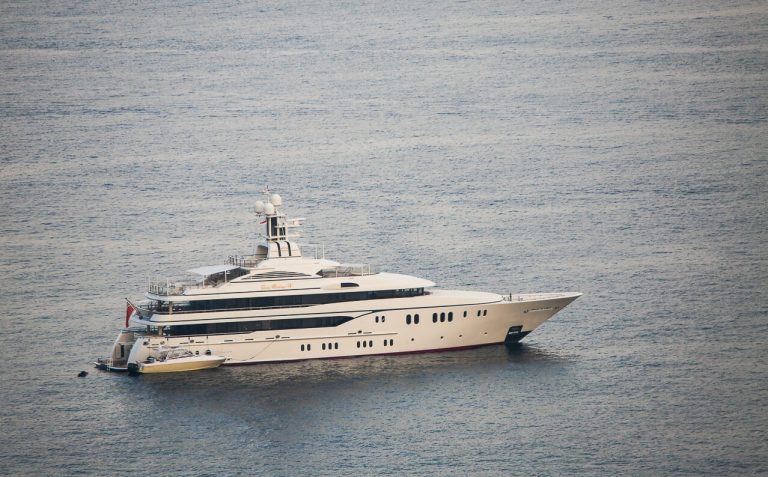
LADY KATHRYN V Yacht – Elegant $60 M Superyacht
- Driven & Reviewed Cars/Moto
- Cars Database
- Moto Database
- Game reviews
- Compare Cars
- BAC Calculator
- Testdrives archive
- Photo of the Day
- Glossary of automotive terms
First Look Ever Inside 'Lady Lara' Megayacht Comes As Billionaire Owner Is Looking To Sell
Download: Lady Lara brochure (PDF)

Elena has been writing for a living since 2006 and, as a journalist, she has put her double major in English and Spanish to good use. She covers automotive and mobility topics like cars and bicycles, and she always knows the shows worth watching on Netflix and friends. Full profile
Would you like AUTOEVOLUTION to send you notifications?
You will only receive our top stories
Yacht, IMO 1012311
- VesselFinder
- Miscellaneous
The current position of LADY LARA is at Caribbean Sea reported 2 min ago by AIS. The vessel LADY LARA (IMO 1012311, MMSI 319082300) is a Yacht built in 2015 (9 years old) and currently sailing under the flag of Cayman Islands .
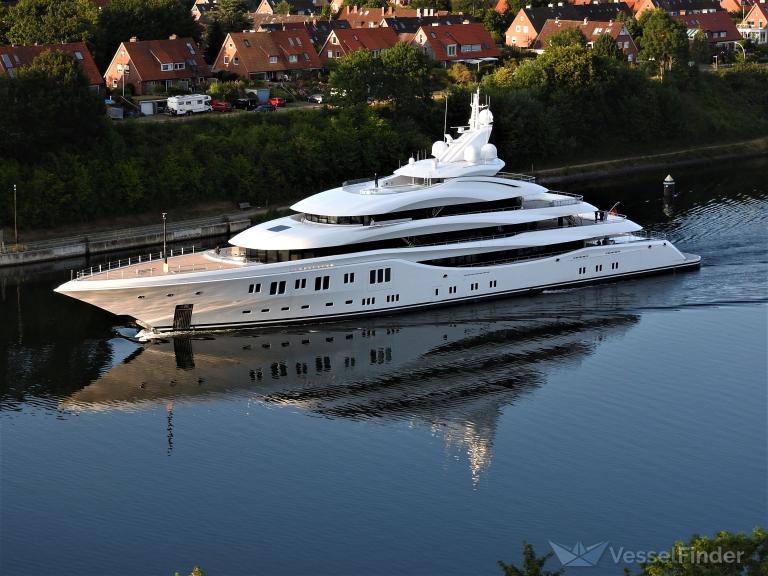
Position & Voyage Data
Map position & weather, recent port calls, vessel particulars.
LADY LARA current position and history of port calls are received by AIS. Technical specifications, tonnages and management details are derived from VesselFinder database. The data is for informational purposes only and VesselFinder is not responsible for the accuracy and reliability of LADY LARA data.
- THE PRINCESS PASSPORT
- Email Newsletter
- Yacht Walkthroughs
- Destinations
- Electronics
- Best Marine Electronics & Technology
- Boating Safety

- Cruising and Chartering
A $1.4 Million-Per-Week Yacht Charter Experience
- By Yachting Staff
- January 9, 2024
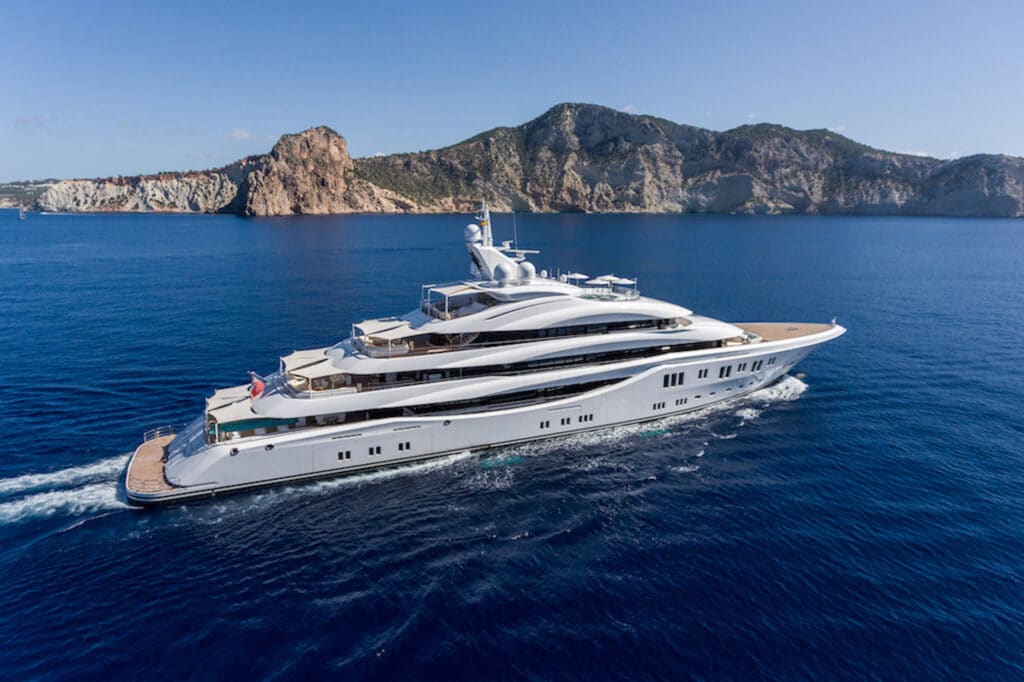
Y.CO has just welcomed the 298-foot Lürssen Lady Lara to the charter fleet. The lowest weekly base rate is $1.4 million for bookings this winter in the Caribbean and Bahamas.
The yacht is also listed for sale—at more than $254 million—for the first time since the German shipyard delivered it in 2015. Y.CO’s Max Bulley and Gary Wright, along with Merle Wood of Merle Wood & Associates, represented the yacht at the recent Monaco Yacht Show.
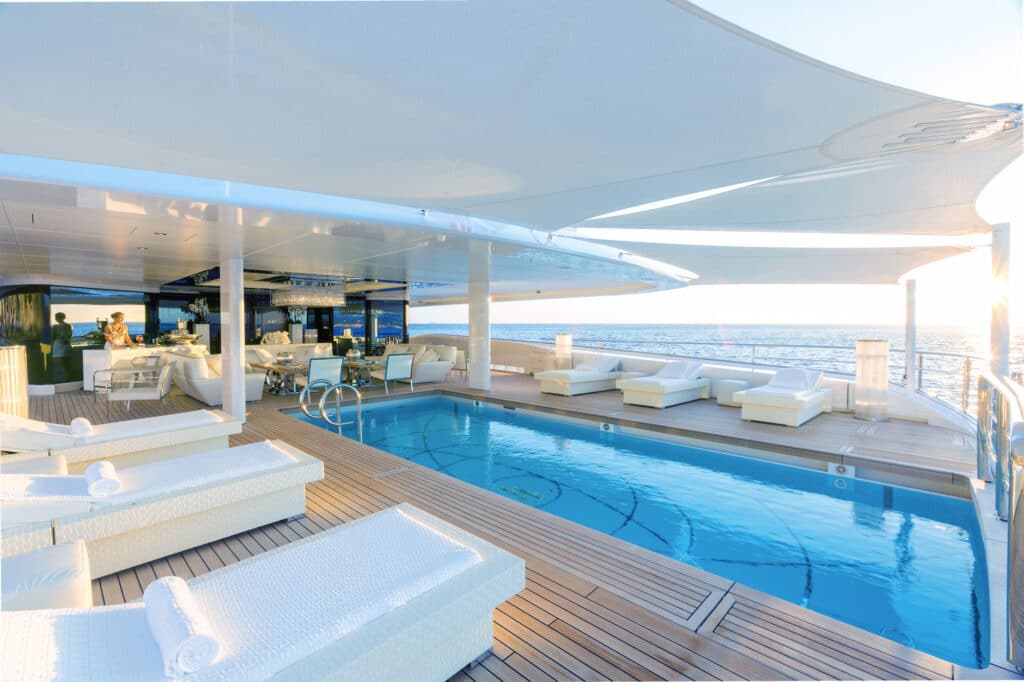
“With Lürssen quality and stunning Reymond Langton design, Lady Lara is an exceptional yacht that was conceived with family living in mind,” Wright stated in a press release. “Her adaptable spaces, variety and flexibility, in addition to all the amazing features like the breathtaking spa area, the beach club and two pools, are ideal for multigenerational groups and put Lady Lara into a league of her own.”
Accommodations are for 12 guests in their choice of eight staterooms (for private use, the yacht is built to accommodate 16 guests). Six of the guest staterooms are on the main deck, with one on the lower deck. The master suite has its own private deck with an exterior terrace, outdoor hot tub, and indoor library. The aft-deck space in the owner’s area is called a “winter garden,” with sliding glass panels that can be closed to shelter diners from the elements.
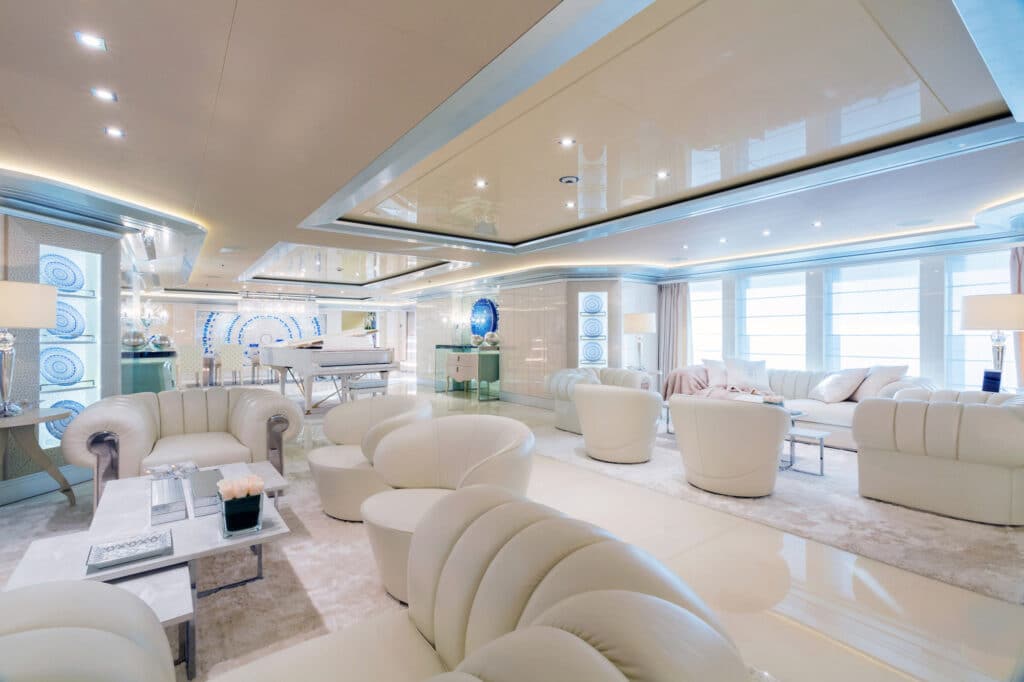
There also are two cabins for owner’s staff or supernumeraries, in addition to the yacht’s quarters for 27 crew.
Onboard amenities include an aft-deck pool whose floor can be raised to create a dance floor. A sound system on this deck helps to create a discotheque-style environment for parties. There’s another pool up on the sundeck, this one with a swim-up bar.
On the bridge deck, guests have access to the spa, which includes a hammam, massage room, treatment room, beauty salon and gymnasium. Guests who prefer to get their exercise outdoors can do so from the beach club at water level, which has a steam room and a sauna along with a sunbathing area.
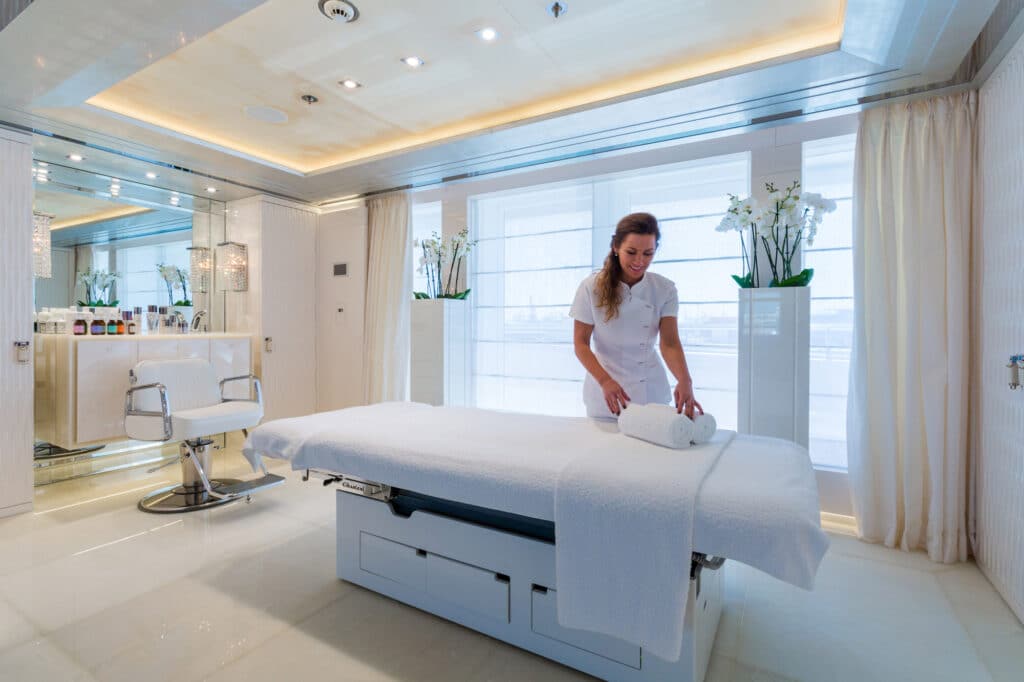
For rainy days and relaxing nights, the lower deck aboard Lady Lara includes a cinema. There’s also a touch-and-go helipad on board, if guests want to escape to a different spot up the coast.
How fast can Lady Lara cruise? According to Y.CO, the yacht has a top speed of 17 knots and a cruising speed of 14 knots, which is plenty fast for exploring the islands.
How to book a week on board: contact a charter broker at y.co
- More: Bahamas , Caribbean , Charter , Cruising & Chartering , Lurssen , Superyachts , Y.CO , Yachts for Sale
- More Cruising and Chartering
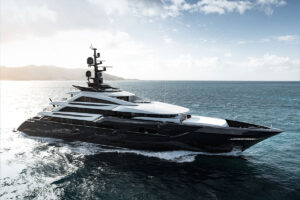
Charter Clients, Start Your Engines
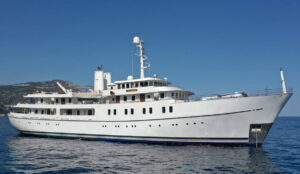
Exotic Yacht Charter Opportunities

Cruising to Key Largo
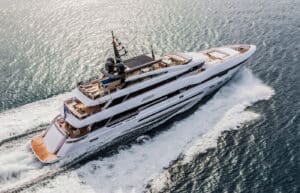
It’s Incentive Season for Charter Yachts
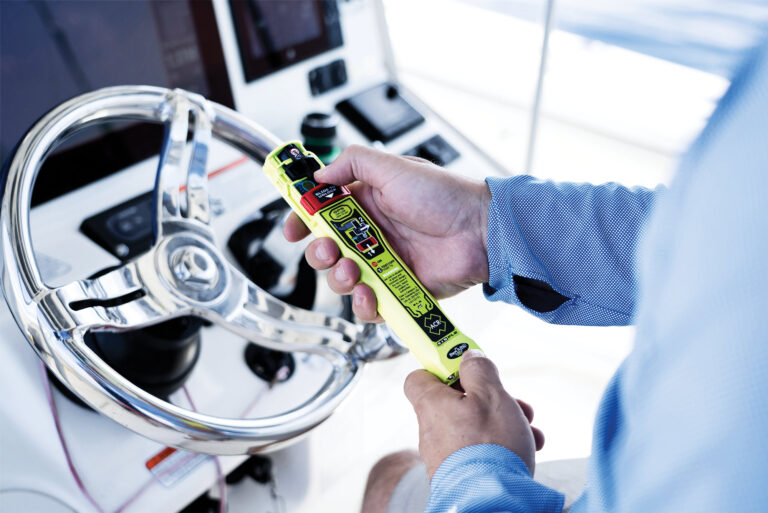
Saving Yourself With ACR’s PLB
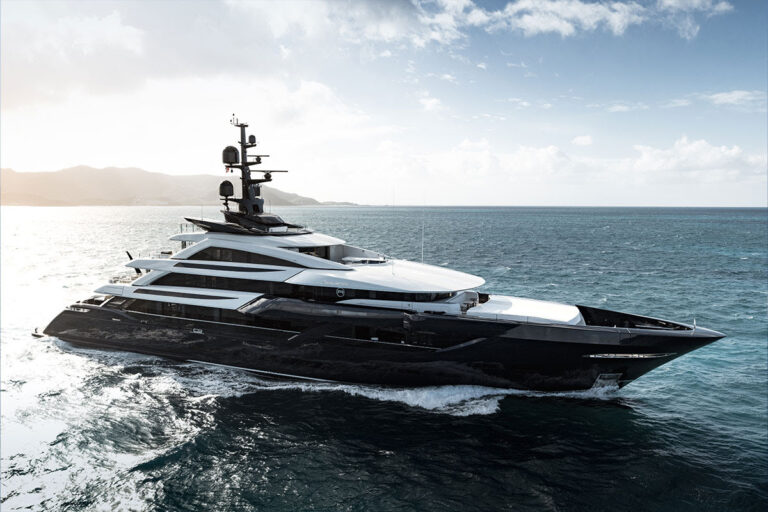
For Sale: 2008 Leopard 47 Powercat
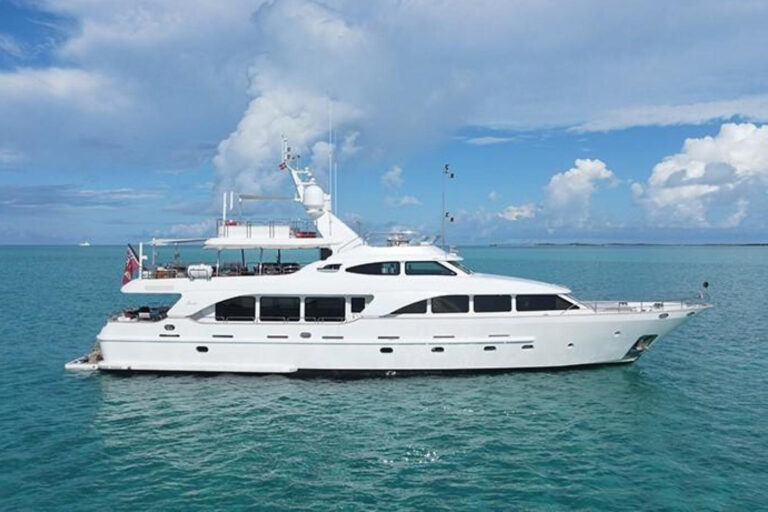
For Sale: Benetti Tradition 100 Tri-Deck

- Digital Edition
- Customer Service
- Terms of Use
- Email Newsletters
- Cruising World
- Florida Travel + Life
- Sailing World
- Salt Water Sportsman
- Sport Fishing
- Wakeboarding
Many products featured on this site were editorially chosen. Yachting may receive financial compensation for products purchased through this site.
Copyright © 2024 Yachting. A Bonnier LLC Company . All rights reserved. Reproduction in whole or in part without permission is prohibited.
File : LadyLara-Yacht-Ibiza05.16.JPG
File history, file usage on commons, file usage on other wikis.

Original file (4,320 × 3,240 pixels, file size: 2.61 MB, MIME type: image/jpeg )
Summary [ edit ]
Licensing [ edit ].
- to share – to copy, distribute and transmit the work
- to remix – to adapt the work
- attribution – You must give appropriate credit, provide a link to the license, and indicate if changes were made. You may do so in any reasonable manner, but not in any way that suggests the licensor endorses you or your use.
- share alike – If you remix, transform, or build upon the material, you must distribute your contributions under the same or compatible license as the original.
Click on a date/time to view the file as it appeared at that time.
You cannot overwrite this file.
The following page uses this file:
- User:AbdealiJKTravis/logs/uncatimages/20160720
The following other wikis use this file:
- Liste der längsten Motoryachten
This file contains additional information such as Exif metadata which may have been added by the digital camera, scanner, or software program used to create or digitize it. If the file has been modified from its original state, some details such as the timestamp may not fully reflect those of the original file. The timestamp is only as accurate as the clock in the camera, and it may be completely wrong.
Structured data
Items portrayed in this file, copyright status, copyrighted, copyright license, creative commons attribution-sharealike 3.0 unported, 21 april 2016, source of file, original creation by uploader.
- Lady Lara (ship, 2015)
- CC-BY-SA-3.0
- Self-published work
Navigation menu

Turn Your Curiosity Into Discovery
Latest facts.

3 TopRated Sites To Boost Your TikTok and Instagram Following

5 Detailed Facts About Medical Cannabis
40 facts about elektrostal.
Written by Lanette Mayes
Modified & Updated: 02 Mar 2024
Reviewed by Jessica Corbett

Elektrostal is a vibrant city located in the Moscow Oblast region of Russia. With a rich history, stunning architecture, and a thriving community, Elektrostal is a city that has much to offer. Whether you are a history buff, nature enthusiast, or simply curious about different cultures, Elektrostal is sure to captivate you.
This article will provide you with 40 fascinating facts about Elektrostal, giving you a better understanding of why this city is worth exploring. From its origins as an industrial hub to its modern-day charm, we will delve into the various aspects that make Elektrostal a unique and must-visit destination.
So, join us as we uncover the hidden treasures of Elektrostal and discover what makes this city a true gem in the heart of Russia.
Key Takeaways:
- Elektrostal, known as the “Motor City of Russia,” is a vibrant and growing city with a rich industrial history, offering diverse cultural experiences and a strong commitment to environmental sustainability.
- With its convenient location near Moscow, Elektrostal provides a picturesque landscape, vibrant nightlife, and a range of recreational activities, making it an ideal destination for residents and visitors alike.
Known as the “Motor City of Russia.”
Elektrostal, a city located in the Moscow Oblast region of Russia, earned the nickname “Motor City” due to its significant involvement in the automotive industry.
Home to the Elektrostal Metallurgical Plant.
Elektrostal is renowned for its metallurgical plant, which has been producing high-quality steel and alloys since its establishment in 1916.
Boasts a rich industrial heritage.
Elektrostal has a long history of industrial development, contributing to the growth and progress of the region.
Founded in 1916.
The city of Elektrostal was founded in 1916 as a result of the construction of the Elektrostal Metallurgical Plant.
Located approximately 50 kilometers east of Moscow.
Elektrostal is situated in close proximity to the Russian capital, making it easily accessible for both residents and visitors.
Known for its vibrant cultural scene.
Elektrostal is home to several cultural institutions, including museums, theaters, and art galleries that showcase the city’s rich artistic heritage.
A popular destination for nature lovers.
Surrounded by picturesque landscapes and forests, Elektrostal offers ample opportunities for outdoor activities such as hiking, camping, and birdwatching.
Hosts the annual Elektrostal City Day celebrations.
Every year, Elektrostal organizes festive events and activities to celebrate its founding, bringing together residents and visitors in a spirit of unity and joy.
Has a population of approximately 160,000 people.
Elektrostal is home to a diverse and vibrant community of around 160,000 residents, contributing to its dynamic atmosphere.
Boasts excellent education facilities.
The city is known for its well-established educational institutions, providing quality education to students of all ages.
A center for scientific research and innovation.
Elektrostal serves as an important hub for scientific research, particularly in the fields of metallurgy, materials science, and engineering.
Surrounded by picturesque lakes.
The city is blessed with numerous beautiful lakes, offering scenic views and recreational opportunities for locals and visitors alike.
Well-connected transportation system.
Elektrostal benefits from an efficient transportation network, including highways, railways, and public transportation options, ensuring convenient travel within and beyond the city.
Famous for its traditional Russian cuisine.
Food enthusiasts can indulge in authentic Russian dishes at numerous restaurants and cafes scattered throughout Elektrostal.
Home to notable architectural landmarks.
Elektrostal boasts impressive architecture, including the Church of the Transfiguration of the Lord and the Elektrostal Palace of Culture.
Offers a wide range of recreational facilities.
Residents and visitors can enjoy various recreational activities, such as sports complexes, swimming pools, and fitness centers, enhancing the overall quality of life.
Provides a high standard of healthcare.
Elektrostal is equipped with modern medical facilities, ensuring residents have access to quality healthcare services.
Home to the Elektrostal History Museum.
The Elektrostal History Museum showcases the city’s fascinating past through exhibitions and displays.
A hub for sports enthusiasts.
Elektrostal is passionate about sports, with numerous stadiums, arenas, and sports clubs offering opportunities for athletes and spectators.
Celebrates diverse cultural festivals.
Throughout the year, Elektrostal hosts a variety of cultural festivals, celebrating different ethnicities, traditions, and art forms.
Electric power played a significant role in its early development.
Elektrostal owes its name and initial growth to the establishment of electric power stations and the utilization of electricity in the industrial sector.
Boasts a thriving economy.
The city’s strong industrial base, coupled with its strategic location near Moscow, has contributed to Elektrostal’s prosperous economic status.
Houses the Elektrostal Drama Theater.
The Elektrostal Drama Theater is a cultural centerpiece, attracting theater enthusiasts from far and wide.
Popular destination for winter sports.
Elektrostal’s proximity to ski resorts and winter sport facilities makes it a favorite destination for skiing, snowboarding, and other winter activities.
Promotes environmental sustainability.
Elektrostal prioritizes environmental protection and sustainability, implementing initiatives to reduce pollution and preserve natural resources.
Home to renowned educational institutions.
Elektrostal is known for its prestigious schools and universities, offering a wide range of academic programs to students.
Committed to cultural preservation.
The city values its cultural heritage and takes active steps to preserve and promote traditional customs, crafts, and arts.
Hosts an annual International Film Festival.
The Elektrostal International Film Festival attracts filmmakers and cinema enthusiasts from around the world, showcasing a diverse range of films.
Encourages entrepreneurship and innovation.
Elektrostal supports aspiring entrepreneurs and fosters a culture of innovation, providing opportunities for startups and business development.
Offers a range of housing options.
Elektrostal provides diverse housing options, including apartments, houses, and residential complexes, catering to different lifestyles and budgets.
Home to notable sports teams.
Elektrostal is proud of its sports legacy, with several successful sports teams competing at regional and national levels.
Boasts a vibrant nightlife scene.
Residents and visitors can enjoy a lively nightlife in Elektrostal, with numerous bars, clubs, and entertainment venues.
Promotes cultural exchange and international relations.
Elektrostal actively engages in international partnerships, cultural exchanges, and diplomatic collaborations to foster global connections.
Surrounded by beautiful nature reserves.
Nearby nature reserves, such as the Barybino Forest and Luchinskoye Lake, offer opportunities for nature enthusiasts to explore and appreciate the region’s biodiversity.
Commemorates historical events.
The city pays tribute to significant historical events through memorials, monuments, and exhibitions, ensuring the preservation of collective memory.
Promotes sports and youth development.
Elektrostal invests in sports infrastructure and programs to encourage youth participation, health, and physical fitness.
Hosts annual cultural and artistic festivals.
Throughout the year, Elektrostal celebrates its cultural diversity through festivals dedicated to music, dance, art, and theater.
Provides a picturesque landscape for photography enthusiasts.
The city’s scenic beauty, architectural landmarks, and natural surroundings make it a paradise for photographers.
Connects to Moscow via a direct train line.
The convenient train connection between Elektrostal and Moscow makes commuting between the two cities effortless.
A city with a bright future.
Elektrostal continues to grow and develop, aiming to become a model city in terms of infrastructure, sustainability, and quality of life for its residents.
In conclusion, Elektrostal is a fascinating city with a rich history and a vibrant present. From its origins as a center of steel production to its modern-day status as a hub for education and industry, Elektrostal has plenty to offer both residents and visitors. With its beautiful parks, cultural attractions, and proximity to Moscow, there is no shortage of things to see and do in this dynamic city. Whether you’re interested in exploring its historical landmarks, enjoying outdoor activities, or immersing yourself in the local culture, Elektrostal has something for everyone. So, next time you find yourself in the Moscow region, don’t miss the opportunity to discover the hidden gems of Elektrostal.
Q: What is the population of Elektrostal?
A: As of the latest data, the population of Elektrostal is approximately XXXX.
Q: How far is Elektrostal from Moscow?
A: Elektrostal is located approximately XX kilometers away from Moscow.
Q: Are there any famous landmarks in Elektrostal?
A: Yes, Elektrostal is home to several notable landmarks, including XXXX and XXXX.
Q: What industries are prominent in Elektrostal?
A: Elektrostal is known for its steel production industry and is also a center for engineering and manufacturing.
Q: Are there any universities or educational institutions in Elektrostal?
A: Yes, Elektrostal is home to XXXX University and several other educational institutions.
Q: What are some popular outdoor activities in Elektrostal?
A: Elektrostal offers several outdoor activities, such as hiking, cycling, and picnicking in its beautiful parks.
Q: Is Elektrostal well-connected in terms of transportation?
A: Yes, Elektrostal has good transportation links, including trains and buses, making it easily accessible from nearby cities.
Q: Are there any annual events or festivals in Elektrostal?
A: Yes, Elektrostal hosts various events and festivals throughout the year, including XXXX and XXXX.
Was this page helpful?
Our commitment to delivering trustworthy and engaging content is at the heart of what we do. Each fact on our site is contributed by real users like you, bringing a wealth of diverse insights and information. To ensure the highest standards of accuracy and reliability, our dedicated editors meticulously review each submission. This process guarantees that the facts we share are not only fascinating but also credible. Trust in our commitment to quality and authenticity as you explore and learn with us.
Share this Fact:
BETA GIDA, OOO
- / BUSINESS DIRECTORY
- / MANUFACTURING
- / FOOD MANUFACTURING
- / OTHER FOOD MANUFACTURING
- / RUSSIAN FEDERATION
- / MOSCOW REGION
- / ELEKTROSTAL
- / BETA GIDA, OOO
- Ozench Avdzhy Director-General
Dynamic search and list-building capabilities
Real-time trigger alerts
Comprehensive company profiles
Valuable research and technology reports
Expedia Rewards is now One Key™
Find hotels in elektrostal.
Most hotels are fully refundable. Because flexibility matters.
Save 10% or more on over 100,000 hotels worldwide as a One Key member.
Search over 2.9 million properties and 550 airlines worldwide.
Bed & breakfast
Fully refundable
Reserve now, pay later
Breakfast included
Lunch included
Dinner included
All inclusive
Pet friendly
Golf course
Electric car charging station
Outdoor space
WiFi included
Air conditioned
Washer and dryer
Airport shuttle included
Service animals allowed
In-room accessibility
Wheelchair-accessible parking
Sign language-capable staff
Accessible bathroom
Stair-free path to entrance
Roll-in shower
LGBTQ welcoming
See properties that pledge to make all guests feel safe, welcome, and respected.
Business friendly
See properties with amenities to help you work comfortably, like WiFi and breakfast.
Family friendly
See properties that include family essentials like in-room conveniences and activities for the kids.
Compare hotels, room rates, hotel reviews and availability. Most hotels are fully refundable.
Stay near popular elektrostal attractions, electrostal history and art museum.
You can spend time exploring the galleries in Electrostal History and Art Museum in Elektrostal. Take in the museums while you're in the area.
Elektrostal Travel Info
Frequently asked questions.
Yes! The majority of room reservations are refundable if you cancel prior to the hotel's cancellation deadline, which is often 24 or 48 hours before your check-in date. If you have a non-refundable reservation, you might still have the option to cancel and receive a refund within 24 hours of booking. Filter your search by fully refundable to find flexible hotel deals in Elektrostal.
To access more information about rescheduling or cancelling your trip to Elektrostal, head over to our customer service page .
Apart Hotel Yantar is one of the top choices for your stay based on our traveler data, and this 3-star hotel offers free parking and free WiFi. It's located 1.9 mi (3 km) from Electrostal History and Art Museum. Another good option is Apartments , located 4.6 mi (7.4 km) away.
Hotel Mys Otdykha Nadezhda : Offers spa services, an indoor pool, and free parking. Park Hotel Yahonty Noginsk and Areal Congress Hotel are a couple of other choices that feature an onsite pool.
Visitors can enjoy all that Elektrostal has to offer including its museums. There are 35 hotels and other accommodations in the surrounding area. Find out more about Elektrostal .
A favorite place to visit is Electrostal History and Art Museum . You'll also find History of Russian Scarfs and Shawls Museum and Central Museum of the Air Forces at Monino in the area. Check out what more to see and do in Expedia's Elektrostal guide .
The hottest months are usually July and August with an average temp of 63°F, while the coldest months are January and February with an average of 22°F. The snowiest months in Elektrostal are December, November, February, and January, with each month seeing an average of 38 inches of snowfall.
- Explore a world of travel with Expedia
- Yuri Gagarin Cosmonaut Training Center
- Peter the Great Military Academy
- Balashikha Arena
- Fryazino Centre for Culture and Leisure
- Military Technical Museum
- Drama Theatre BOOM
- Bykovo Manor
- Malenky Puppet Theater
- Shirokov House
- Borisoglebsky Sports Palace
- Fifth House Gallery
- Church of Vladimir
Hotels near Elektrostal Airports
- Bykovo Airport
- Sheremetyevo Airport
- Domodedovo Intl. Airport
- Vnukovo Intl. Airport
- Chkalovsky Airport Airport
- Zhukovsky Airport
Other Hotels near Elektrostal, Moscow Oblast
- Northern Europe Hotels
- Eastern Europe Hotels
- Balashikha Hotels
- Lyubertsy Hotels
- Ramenskoye Hotels
- Noginsk Hotels
- Kosherovo Hotels
- Zheleznodorozhny Hotels
- Shchelkovo Hotels
- Malakhovka Hotels
- Fryazino Hotels
- Ogudnevskoe Hotels
- Fryazevo Hotels
- Istomkino Hotels
- Peshkovo Hotels
- Imeni Vorovskogo Hotels
- Berezka Hotels
- Afonasovo Pervoye Hotels
- Bol'shoye Bun'kovo Hotels
- Pavlovskiy Posad Hotels
Expedia's Latest Trends
Additional information about expedia group.
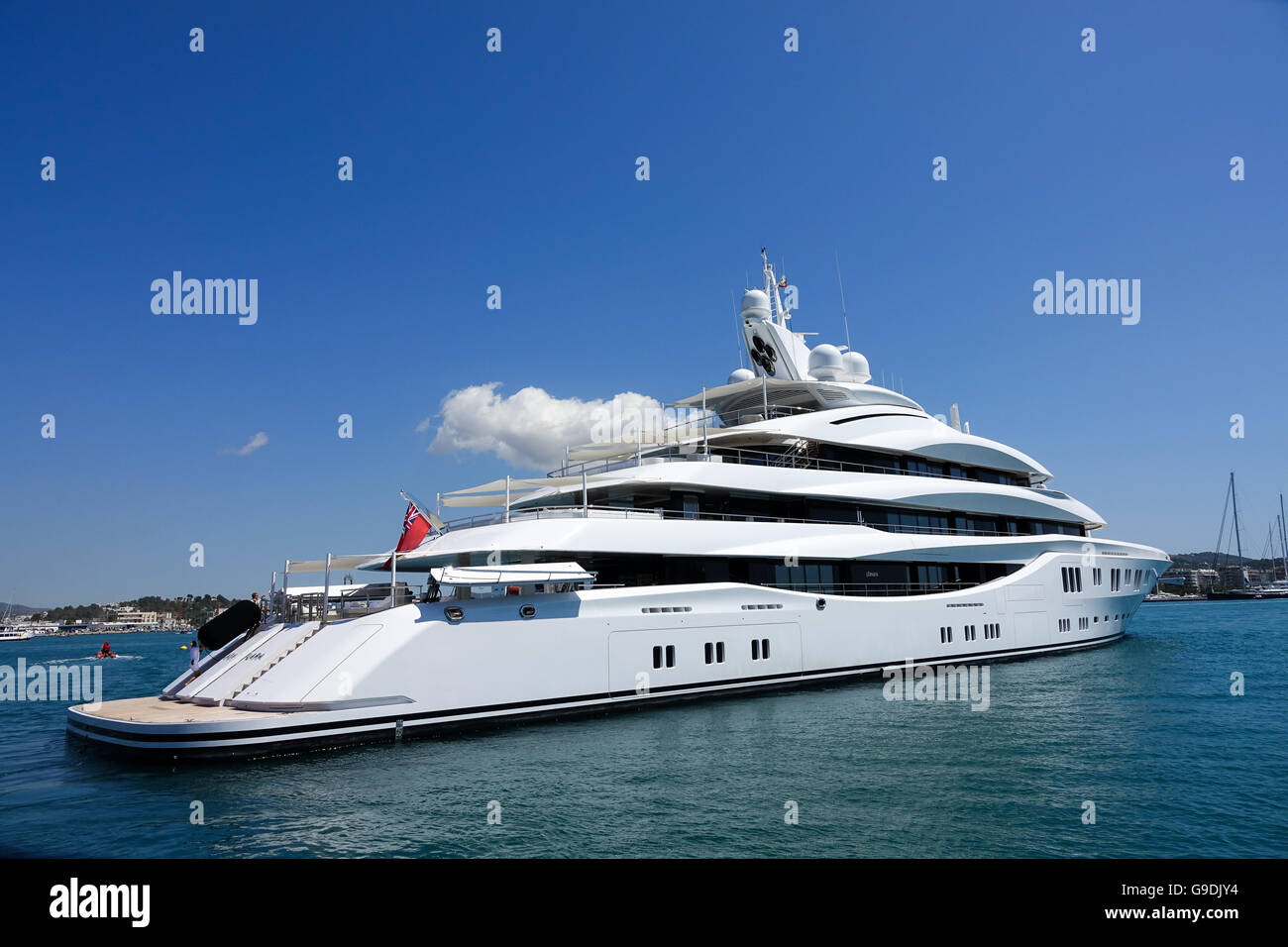
Ahead of one of the meetings with the owners, the designers carved into a foam model of the yacht with a scalpel and sandpaper to bring out the dramatic details they imagined for Lady Lara's undulating form.To best appreciate the artful exterior, the designers and I stand on the dock and gaze upwards at the 2,945GT yacht that floats before us.
91-meter luxury mega yacht, interior and exterior by Reymond Langton, custom construction by Lürssen, master German shipbuilder with a legacy in motor yachts since 1875. Marked by exceptional features including a large waterside beach club, VIP guest suites with fold down balconies and extensive spa and treatment facilities. Delivered in 2015.
The Lady Lara Yacht is a 92-meter motor yacht built by Lurssen in 2015. Powered by twin MTU engines, she boasts a top speed of 18 knots and a cruising speed of 14 knots. The yacht's interior and exterior were designed by Reymond Langton Design, with features such as VIP suites with fold-down balconies and a large beach club. ...
Lady Lara spotted in Ibiza. Lady Lara Mega Super Yacht, is a motor yacht built in 2015 by Lürssen in Schacht-Audorf. She is owned by Israeli/Kazakh billionaire Alexander Mashkevitch. With an overall length of 91.00 m (298.56 ft) and a beam of 14.82 m (48.6 ft).
Lady Lara one of the latest deliveries by Lürssen in Ibiza Port Megayacht berth. #ladylara #luerssen #megayacht #ibiza
The LADY LARA yacht is a 298.6ft / 91m luxury yacht for sale, built and launched by yacht builder Lurssen. Delivered to a proud yacht owner in 2015 and refit in 2023, this luxury yacht sleeps up to 16 guests in 8 staterooms and has accommodations for 29 crew. She has a beam of 47.1ft / 14.4m, a draft of 13.1ft / 4m, and she measures in at 2,945 ...
Impressive 6,000nm range. Vast array of toys. Recent refit in 2023. Lady Lara is spacious and packed with things to do making her fully primed for guests seeking a luxury charter at sea. The award winning 91m/298'7" motor yacht 'Lady Lara' by the German shipyard Lurssen offers flexible accommodation for up to 12 guests in 8 cabins and features ...
The LADY LARA yacht is a 91m superyacht with a beam of 14.82m and a draft of 4m. The vessel reaches a maximum speed of 18 knots and a cruising speed of 14 knots. She is powered by 2 MTU engines and has a displacement of 2,945 gross tons. She features an advanced stabilization system that provides guests with the best comfort levels on board by ...
Lady Lara is a motor yacht built in 2015 by Lürssen in Schacht-Audorf. She is owned by Israeli / Kazakh billionaire Alexander Mashkevitch . [3] The vessel has an overall length of 91.00 m (298.56 ft) and a beam of 14.82 m (48.6 ft).
Getting closer to the 2015 M/Y LADY LARA while on anchor in Cap-Martin for the summer.The Lurssen built yacht features an exterior and interior design by Rey...
Lady Lara is a 91m superyacht built by Lürssen which exceeds expectations at every level. With a dedicated wellness area which includes a treatment room, ham...
The 91-metre Lürssen motor yacht Lady Lara has been listed for sale with Max Bulley and Gary Wright of Y.CO and Merle Wood of Merle Wood & Associates and will be one of the largest brokerage boats on display at the Monaco Yacht Show . Lady Lara is offered for sale for the first time since her delivery in 2015 and has been kept under wraps up ...
Lady Lara is powered by twin MTU diesel engines delivering 3,004 hp engines each and taking it to a top speed of 17 knots (19.5 mph/31.5 kph). At a cruising speed of 12 knots (13.8 mph/22.2 kph ...
Yacht, IMO 1012311. VesselFinder. Vessels. Miscellaneous. LADY LARA. The current position of LADY LARA is at Caribbean Sea reported 1 min ago by AIS. The vessel LADY LARA (IMO 1012311, MMSI 319082300) is a Yacht built in 2015 (9 years old) and currently sailing under the flag of Cayman Islands .
By Yachting Staff. January 9, 2024. Lady Lara, a 298-foot Lürssen, is chartering in the Caribbean and Bahamas at a weekly base rate of $1.4 million. Courtesy Y.CO. Y.CO has just welcomed the 298-foot Lürssen Lady Lara to the charter fleet. The lowest weekly base rate is $1.4 million for bookings this winter in the Caribbean and Bahamas.
Superyacht LADY LARA docked in Ibiza waiting for owner
English: The Super Yacht Lady Lara in Ibiza Harbour April 2016. Deutsch: Die Mega-Yacht 'Lady Lara' im Hafen von Ibiza, April 2016. Date: 21 April 2016: Source: Own work: Author: JanManu:
Known as the "Motor City of Russia." Elektrostal, a city located in the Moscow Oblast region of Russia, earned the nickname "Motor City" due to its significant involvement in the automotive industry.. Home to the Elektrostal Metallurgical Plant. Elektrostal is renowned for its metallurgical plant, which has been producing high-quality steel and alloys since its establishment in 1916.
Lady Lara super yacht Ibiza 2017 160mln $
Find company research, competitor information, contact details & financial data for BETA GIDA, OOO of Elektrostal, Moscow region. Get the latest business insights from Dun & Bradstreet.
The nearest airport to Elektrostal is Zhukovsky (ZIA) Airport which is 32.5 km away. Other nearby airports include Moscow Domodedovo (DME) (54 km), Moscow Sheremetyevo (SVO) (67.2 km) and Moscow Vnukovo (VKO) (75.4 km).
Find hotels in Elektrostal. Check-in. Most hotels are fully refundable. Because flexibility matters. Save 10% or more on over 100,000 hotels worldwide as a One Key member. Search over 2.9 million properties and 550 airlines worldwide. View in a map.
yacht master rose gold two tone

amadeus sailing yacht
New on boatsatsea.
- Mischievous
- The Blue Dream

NEWEST SPECIAL OFFERS
- Adeona ( Lastminute 30% off )
- Royal Flush ( Jun 20% off )
- Aquarella ( 10% off)
- Aquila ( 5% off)
- Ulisse ( 10% off)
- Boom ( 10% off)
- See All Special Offers
TOP CHARTER YACHTS
- Crystal Dreams ( 15% off)
- Bella ( $1,000 off)
- See All Yachts
Most Searched Yacht
Ad astra 5.4.
From $28,500 per week
TOP DESTINATIONS
- Virgin Islands (BVI & USVI)
- Leeward Islands / St. Martin
- Windward Islands / Grenadines
EUROPE / MEDITERRANEAN
- Amalfi Coast & Sicily
- Riviera & Corsica & Sardinia
- Spain / Balearics
- New England
- South America
MY FAVORITE YACHTS
- See Favorite Yachts
- Send & Share Favorite Yachts
- Empty Favorite Yacht List
- Yacht Charter FAQ
- Rates Explanations
- Concierge Service
- Customer Satisfaction
- BoatsAtSea Reviews
- Dedicated Support
Privacy Policy
- Cookie Policy
Amadeus - Crewed Sailing Yacht Charter
Amadeus €35,000.
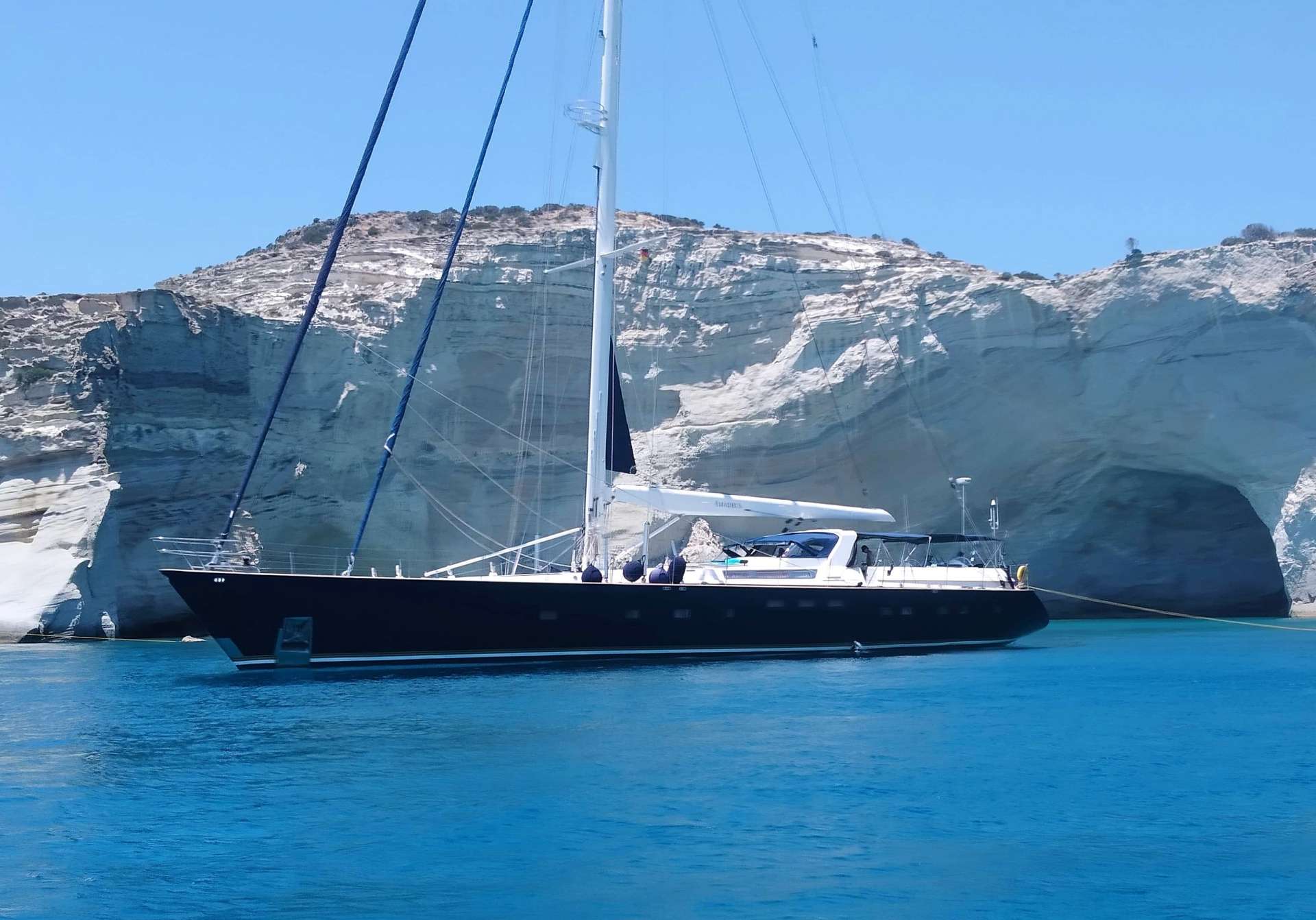
Amadeus Image 1/22
Layout of Amadeus
Amadeus Image 3/22
Amadeus Image 4/22
SUNBATHING FORWARD
SUNBATHING FORWARD ANOTHER VIEW
- Splash Pool
Splash Pool another view
Amadeus Image 9/22
Amadeus Image 12/22
Amadeus Image 13/22
Amadeus Image 14/22
Amadeus Image 15/22
Amadeus Image 19/22
Amadeus Image 20/22
Anastasia Yurash (Asst. Stewardess)
Stelios Mandos (Engineer)
- From €35,000 / week
- Sailing Monohull + 6 crew
- Summer Port: Cruising Areas Summer: Greece, Turkey Summer Port: Marina Zea, Piraeus, Greece Winter: Greece Winter Port: Marina Zeas, Pireaus, Greece ">Marina Zea, Piraeus, Greece
- Winter Port: Cruising Areas Summer: Greece, Turkey Summer Port: Marina Zea, Piraeus, Greece Winter: Greece Winter Port: Marina Zeas, Pireaus, Greece ">Marina Zeas, Pireaus, Greece
- Length: 110 ft / 33.5 meters 110 feet 33.5 meters
- Guests: 12 in 5 cabins
- Builder: Dynamique Ya
- Built: 1996 / Refit: 2014/2020
- Offers Rendezvous Scuba Diving only
Plus Expenses
- Reviews (1)
Amadeus Description
Built by the famous Dynamique Yachts shipyard, and having undergone a total refit in 2018, S/Y Amadeus was designed to please the most demanding of yachtsmen. Built for smooth sailing, this elegant cutter rigged sloop has a sleek hull design, comfortably reaching top speeds of 12 knots and ensuring excellent sailing performance. S/Y Amadeus has just undergone this past winter (2018) a major refit such as total repaint top to bottom, new rigging (BSI Denmark), Novourania with new Evinrude 75hp outboard, Splash pool, new Bimini/Sprayhood/Awnings, new exterior fabrics and many other enhancements. In 2016 new “North Sails” were placed onboard. The yacht is maintained in excellent condition with a five-star crew year round. Her generous uncluttered teak deck offers plenty of space for sunbathing. The spacious and unique outdoor saloon has two tables seating upto 12 guests and is a perfect setting for outdoor dining and entertainment. Thanks to a special canopy and roll-up windows, the deck saloon has the added attraction that it can be fully enclosed, making it ideal for all weather conditions. Her forward area includes a splash pool and sun bathing area which can also be shaded with a removable awning. From the cockpit, a stairway leads to the light-filled spacious saloon offering ample seating, ideal for relaxing or enjoying a drink from the bar, and offers a formal dining area. This area also includes a LCD TV, entertainment center, ipod dock station, playstation, and is ideal for indoor activities. She can accommodate 10-12 guests in one full width master stateroom, two double bedded cabins each having one extra single bed and two twin bedded cabins which can be easily converted to double beds (upon request), thus, making her the only 5 double bedded sailboat in the Greek market. She also has a nice selection of toys which include water ski (adult and children), tubes, inflatable canoes, wakeboard, fishing rod and snorkeling gear.
Cruising Area of Amadeus
Accommodations, specification, water sports, scuba diving, entertainment, amadeus crew profile, chief stewardess.
CAPTAIN - Harry Fotopoulos Captain Harry is a graduate of the Merchant Marine Academy and holds a Captain Class A’ Diploma. He also holds a Canadian Commercial Pilot license class B, sailing and speedboat license. He has over 15 years of experience onboard many types of Charter Yachts. He holds Certificates in GMDSS, Fire Fighting & First Aid, Personal Safety, Life Saving, and Ship Security. He has a great knowledge of the Greek islands and will navigate guests to remarkable destinations. During his one season on board he showed great leadership skills and received positive feedback from all guests. He is calm yet very outgoing and speaks very good English. DECKHAND - Konstantinos Santas CHIEF STEWARDESS - Mirella Davint Mirella has 8+ years of experience as a stewardess onboard charter and private yachts. She has a very pleasant personality and she aims to accommodate her guests to the fullest. Comments received from previous guests are memorable. This will be Mirella’s eighth season onboard. Mirella speaks English and she is 38 years old. ENGINEER - Stelios Mandos Stelios holds an Engineer Class B’ Diploma from the Greek Merchant Marine Academy as well as a Sailor’s License. He has over 15 years of experience onboard Ocean-Going Vessels and Charter Yachts. His hobbies include spearfishing and sailing. He speaks good English. Stelios is 45 years old, married with two children. CHEF - Thanasis Kiritsis Thanasis is 39 years old and has worked as a chef for more than 20 years in numerous hotels restaurants, yachts and resorts including owning his own pastry shop / bakery for 5 years. Thanasis looks forward to welcoming his guests on board and introducing them to his culinary world. He speaks good English and Greek. He is a young chef full of energy, skills and passion towards his job. We are confident that he will serve his guests unforgettable flavors. ASSISTANT STEWARDESS - Anastasia Yurash Anastasia is 31 years old and has been in the yachting industry since 2021. Her working experience includes 7 years as a housekeeper and assistant stewardess. Anastasia speaks very good English. One of Anastasia’s strongest attributes is her appetite for work. She is also very sociable, welcoming and looks forward to having guests on board S/Y Amadeus. Her hobbies include Latin dancing, snowboard and yoga.
Amadeus Calendar
Amadeus reservations & port locations, amadeus rates / week, low price: €35,000, high price: €42,500, additional rate details, amadeus guest reviews, amadeus / charter july 20-27, 2019.
Sent: Wednesday, July 31, 2019 9:02 PM Hi George, client just informed me, that he and his friends were very happy. Good atmosphere on board, excellent crew, good chef and professional service. Yacht in good condition, nice cabins. The proposed itinerary was good. Clients intend to book AMADEUS next summer again. Please send my big thank you to the Captain. Best regards,
Amadeus Sample Menu
Breakfast selections.
Freshly Squeezed Orange And/Or Grapefruit Juice
Selection Of Other Juices Such As Peach, Pineapple, Tomato.
Fresh Milk Cold And/Or Hot.
Freshly Brewed Coffee And/Or Decaf Coffee, Cappuccino, Espresso (Nespresso)
Hot Or Cold Chocolate, Selection Of Teas Served With Lemon, Honey And/Or Milk.
Breads: Plain Croissant, Chocolate Croissant, Brioche, Muffins, Traditional Greek Bread,
Rolls, Pastries, Toast White/Wheat/Rye.
Selection Of Jams And Marmalades Such As Apricot, Strawberry, Rasberry, Orange And Honey.
Selection Of Cheese Such As Emmental, Edam, Gruyere, Kefalotiri, Graviera,
Cream Cheese, Cottage Cheese, Cheese Spread.
Ham, Bacon, Salami, Smoked Turkey, Prosciutto.
Choice Of: Scrambled Eggs, Boiled Eggs, Fried Eggs, Poached Eggs, Omelets.
Eggs And Omelets Are Prepared To Order And Accompanied According To The Guest’s Requests.
Pancakes, Served With Jam, Honey, Maple Syrup, Fruits And/Or Whipped Cream.
Home-Made Carrot Cake.
Selection Of Cereals Such As Corn Flakes, Bran,Rice Crispies , Muesli.
Greek Plain Yoghurt And Fruit Yoghurt.
Fruit Salad, Half Grapefruit, Mixed Berries, Stewed Prunes, Dried Fruits And Nuts.
LUNCH SELECTIONS
Greek Salad With Marinated Anchovy And Extra Virgin Olive Oil
Fresh Talliatele With Mushrooms And Parmesan Chips
Seawolf Fiilet With Vegetables Briam, Fried Caper And Fresh Thyme Panacotta With Ginger
Salad With Radish, Dill, Parsley, Arabic Pita Bread And Soumak
Egg-Plant Napoleon With Feta Cheese And Tomato Couli
Chicken Roll, Cous-Cous With Raisins, Pine Nut And Orange Sauce Walnut Cake With Vanilla Ice-Cream
Salad With Grilled Peach And Apricot And Watermelon Vinaigrette Sauce
Risotto With Red Mullet, Pine Nuts And Sun Dried Tomato
Pork Loin Filled With Naxos Graviere
Halvas (Semolina) With Korinthous Raisins Kai Cinnamon
Salad With Fennel Root, Olives And Orange
Tarte With Goat Cheese And Green Apple
Gurnet Fillet With Lemon Sauce Baby Potatoes And Parsley
Yogurt Mousse With Fresh Vanilla
Watermelon Salad,Feta Onion And Lemon Sauce, Balsamic Vinegar And Extra Virgin Olive Oil
Stuffed Squid With Chocolate Sauce
Tuna Fillet With Orange Confite And Red Wine Sauce
Peach Cheesecake
Green Salad With Smoked Salmon And Salmon Eggs
Mussels With Fresh White Cheese (Anthotiro) And Peppers
Sole Fillet Saute With Spring Onion And Fava (Yellow Split Peas) Fron Santorini Island
Galaktompoureko (Pastry Fillo Filled With Cream) And Orange Couli
Salad With Rocket, Parmezan Flakes, Sun Dried Tomato And Caramel Balsamic Sauce
Grilled Octapus With Chick Peas And Lemon
Anglerfish Stew With Green Talliatele
Tiramisu With Aigina Pistachios
DINNER SELECTIONS
Salad With Cretan Hard Bread , Tomato And Fresh White Cheese (Anthotiro) Grilled Vegetables Napoleon With Mastello (Chios Cheese) Bream Fillet With Crust From Cuttlefish Ink, Artichoke Mousse And Marinated Fennel Root Chocolate Souffle With Ice-Cream
Green Salad With Cottage Cheese, Walnuts And Extra Virgin Olive Oil With Herbs Cabbage Leafs Filled With Shrimps, Cracked Wheat And Egg-Lemon Sauce And Ginger T-Bone Steak With Mushrooms Sauce,Dofinouaze Potato Trifle With Coffee
Caesars Salad With Poached Egg, Parmesan Tuille And Mustard Crackers Fousili With Pesto Sauce And King Prawns Cod Fish Cooked With Safron, Green Olives And Potato Kantaifi With Pistachio And Ice Cream
Mozzarella Buffal0 With Black Eyed Beans And Fennel Rizotto Venere With Chicken Breast And Crawfish Rib-Eye With Fresh Potato Chips And Vegetable Sauce Almond Pie With Chocolate
Baby Spinach Salad, Pears With Pepper And Walnut Vinegar From Blackberry Beef Carpaccio With Caper, Parmesan And Rocket Gilthead Fillet, Vegetable Chips And Hot Balsamic Sauce Greek Loukoumades, Thyme Honey And Walnuts
Cracked Wheat Salad, Parsley,Cucumber,Tomato And Pomegrenade Sauce Goat And Feta Cheese Croquete, Orange And Cumin Sauce Pork Souvlaki, Greek Pita Bread, Tzatziki Sauce And French Fries Caltsounia (Pastry) With Manouri Cheese, Mint, Honey-Orange Sauce
Grilled Vegetables Salad And Chaloumi (Cyprus Cheese) Eggplant “Papoutsakia”, Mince Meat With Fresh Tomato Sauce Spagetti Flavored With Cutlefish Ink, Shrimps Hazelnut Cream Profiterolle
SIMILAR YACHTS
Check out similar yachts to amadeus.
Estrella De Mar
€23,450 / week
Guests in Cabins: 12 / 5
Length: 111.5 ft (34 m)
Summer Port: Bodrum, Turkey
Prices from: €23,450 / week
€50,000 / week
Guests in Cabins: 9 / 4
Length: 100.6 ft (30.65 m)
Summer Port: Athens, Greece
Winter Port: Athens, Greece
Prices from: €50,000 / week
Wind of Change
€24,000 / week
Guests in Cabins: 6 / 3
Length: 95.1 ft (29 m)
Prices from: €24,000 / week
€29,000 / week
Guests in Cabins: 8 / 4
Length: 99 ft (30.2 m)
Winter: Greece
Prices from: €29,000 / week
€43,500 / week
Length: 108.3 ft (33 m)
Summer Port: Lavrio, Greece
Prices from: €43,500 / week
€21,000 / week
Guests in Cabins: 14 / 7
Length: 115.5 ft (35.20 m)
Summer Port: Gocek, Turkey
Winter Port: Gocek, Turkey
Prices from: €21,000 / week

AMADEUS is a fast cruising sailing yacht built by the famous Dynamique Yachts shipyard and totally refit in 2004, she was designed to please the most demanding of yachtsmen. Built for smooth sailing, this elegant cutter rigged sloop has a sleek hull design that enables her to comfortably reach top speeds of 12 knots and ensures excellent sailing performance.
This sailing yacht's generous uncluttered teak deck with a foredeck pool, offers plenty of space for sunbathing. The spacious and unique outdoor saloon has two tables, a bar and barbeque, a perfect setting for outdoor dining and entertainment. Thanks to a special canopy and roll-up windows, the deck saloon has the added attraction that it can be fully enclosed, making it ideal for all weather conditions. From the cockpit, a stairway leads to the light-filled spacious saloon offering ample seating, ideal for relaxing or enjoying a drink from the bar, and a formal dining area with seating for up to 12 guests.
Accomodation is offered for up to 12 guests in 5 spacious cabins: the bow master cabin on AMADEUS features a double bed, vanity unit and generous storage facilities, as well as audio/visual entertainment. The en-suite bath includes a shower and separate large bath. Two double cabins with additional single bunks situated forward. Two twin cabins situated aft. All cabins with en suite facilities and audio/visual entertainment. Crew of 5 in separate quarters.
Special Features :
- Fast cruising sailing yacht - Spacious teck deck, sunbathing areas - Outdoor saloon with a bar and barbecue
Tender: Novourania tender 4.20m with YAMAHA X 70hp plus MERCURY x 10hp
Activities : Wakeboard , Kayak , Snorkeling equipment , Waterskis , Fishing equipment , Monoski , Tender , Tubes .
Summer : East Mediterranean Greece - The Cyclades Islands | Turkey | Greece – The Ionian Islands
Winter : East Mediterranean Greece - The Cyclades Islands | Turkey | Greece – The Ionian Islands
News & publications
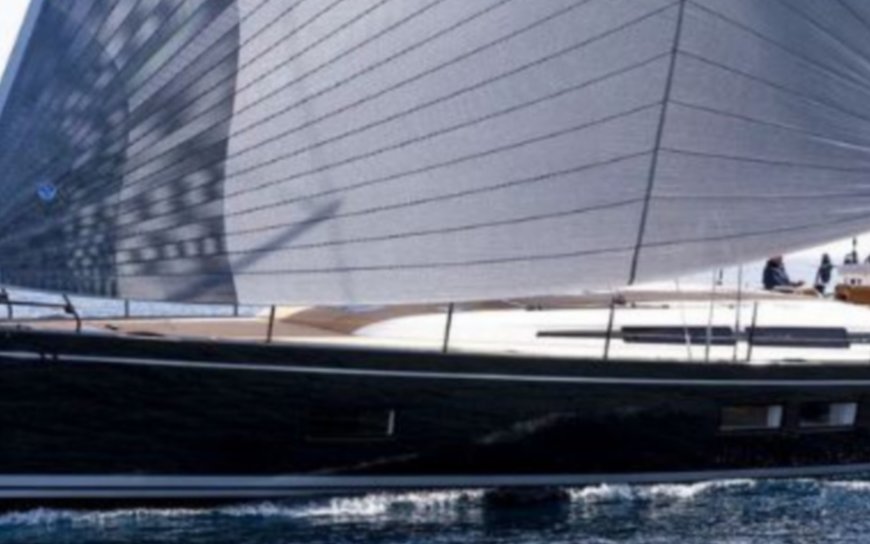
SHINE: New yacht for sale!
A simply stunning Swan 58 as only Swan can. The big sister to the 48 she sails phenomenally well and was designed to allow for fast, safe and comfortable Bluewater passage making. This original owner has used her to cruise the Baltic and she has certainly proven herself. She is ready...
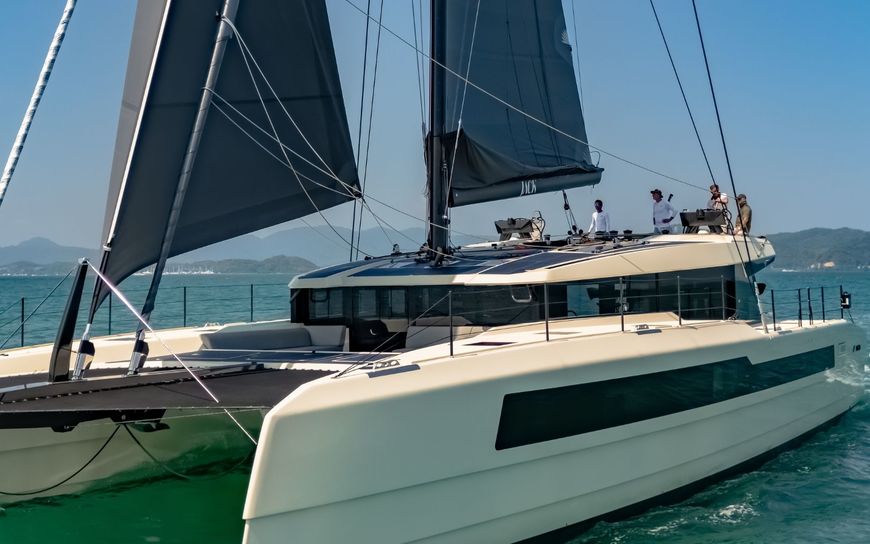
JACK: New Central Agency Yacht
Built in 2023, JACK is a sophisticated and comfortable catamaran that embodies a blend of lightweight construction, eco-friendliness, and remarkable performance. Indeed, she is able to achieve remarkable speeds of up to 21 knots in just 20 knots of wind. Her exterior includes a sprawling...
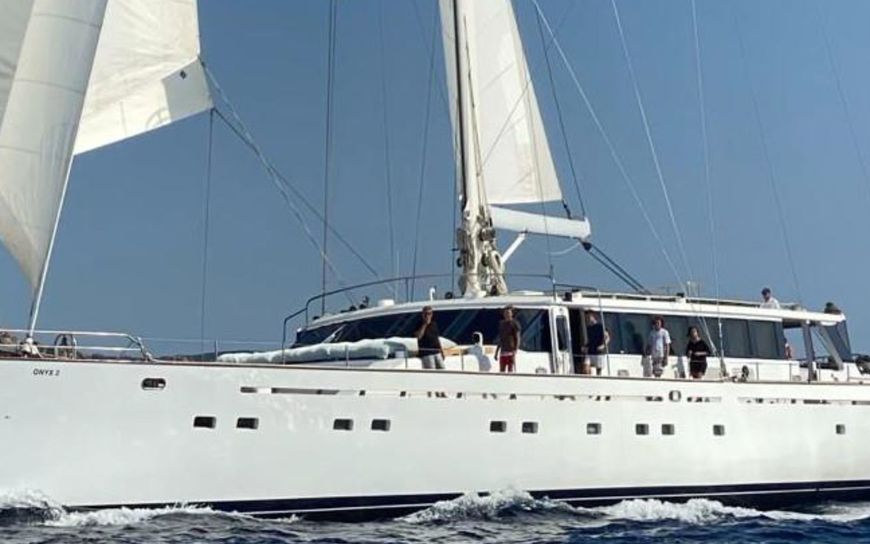
ONYX 2: New sailing yacht for sale!
ONYX 2 offers amazing space and comfort for those onboard to cruise anywhere in the world. She is seaworthy, solidly-built and well-equipped. She accommodates up to 12 guests in 6 cabins and 7 crew in 3 cabins. There is also a fantastic deck house which offers an incomparable interior...
Similar boats for charter
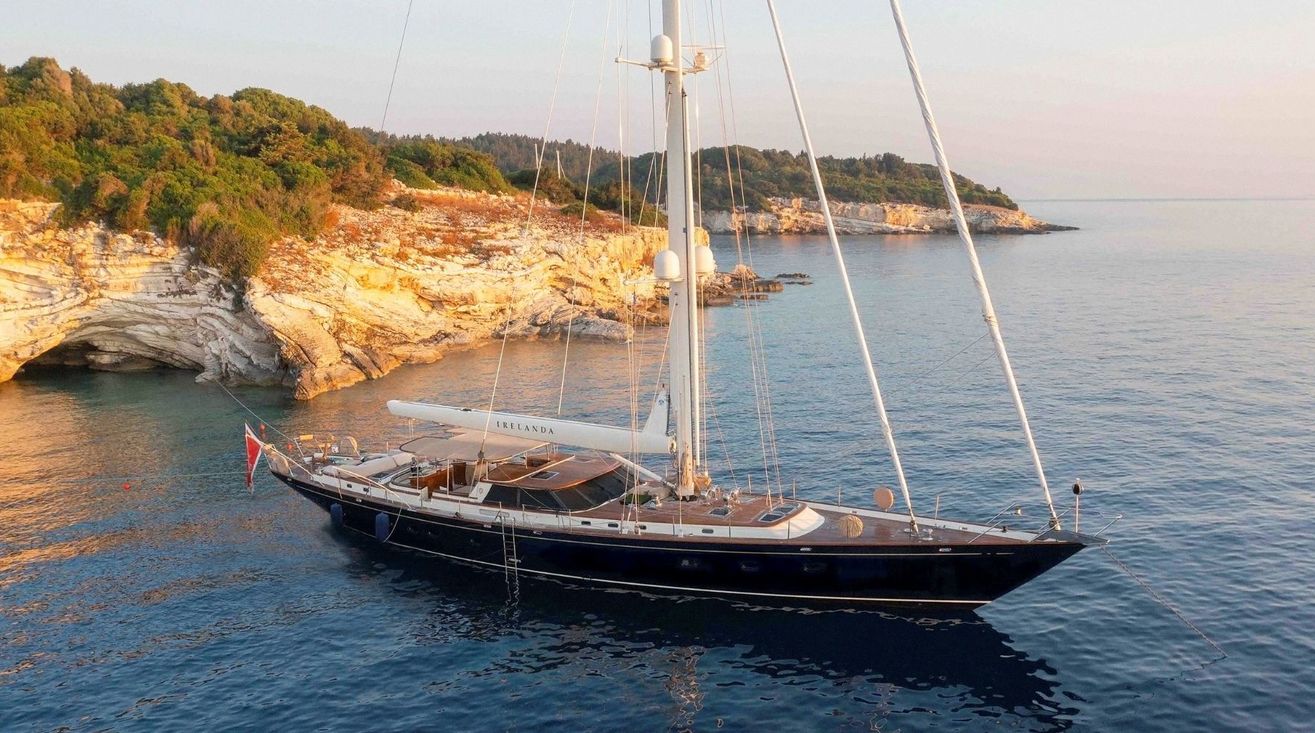
Length : 31.95 m / Passengers : 6
Special features : - Elegant and sophisticated, with classy mahogany interiors- Wide beam and high volume with a vast centre cockpit, large deckhouse and voluminous main...
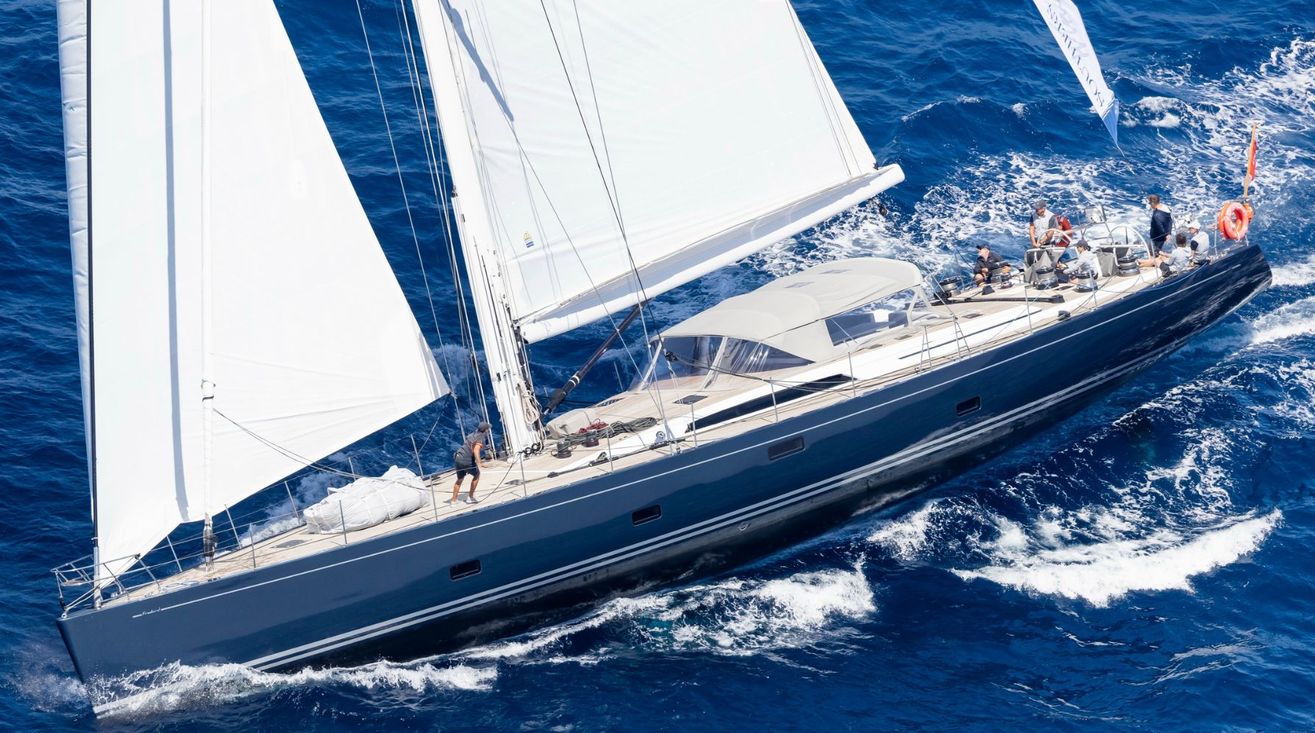
Length : 30.3 m / Passengers : 8
Special features : - Deck plan designed for easy sailing and comfort both for crew and guests- Maximum flexibility for shading the guest cockpit and the sunbathing area,...
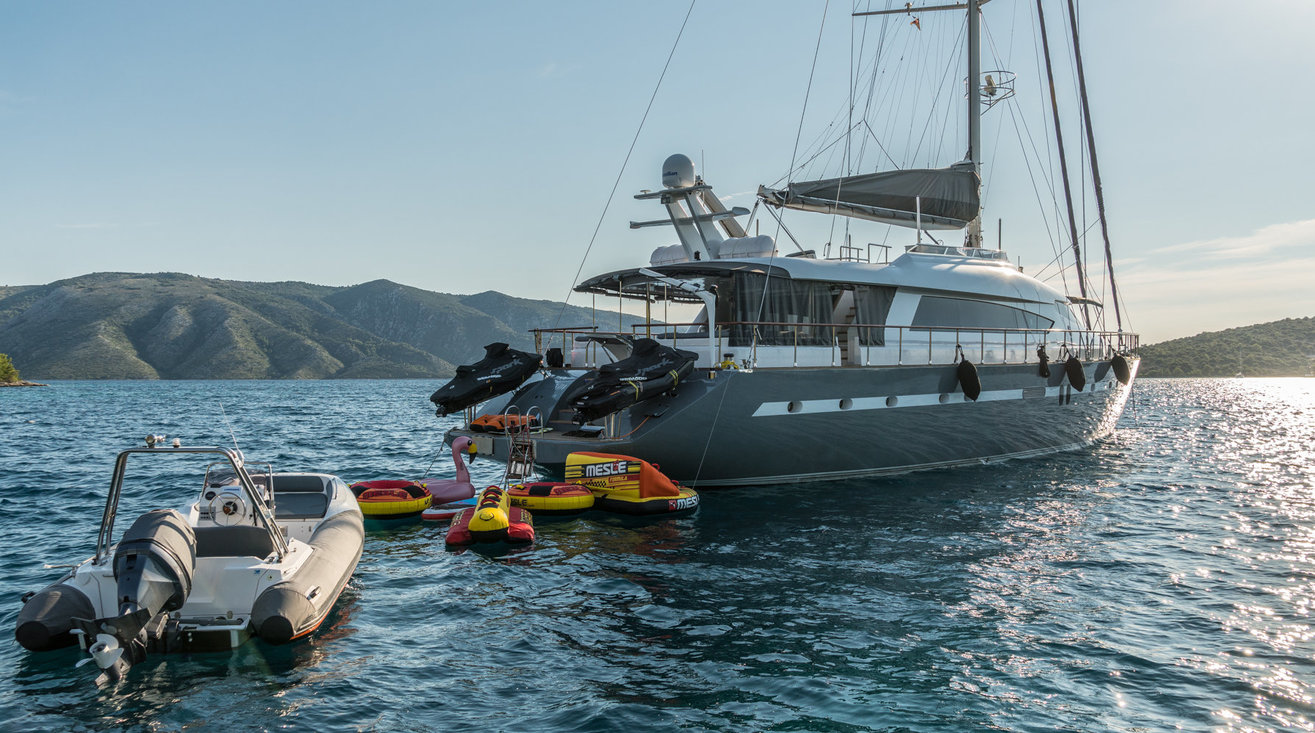
Length : 34.8 m / Passengers : 8
Special features : Tenders:- "Lina": 7.10 m Scanner with 300 HP inboard engine, specially equipped wih bimini and sprayhood, new in 2018- "Mieke": 4.70 m ZAR with 100 HP...
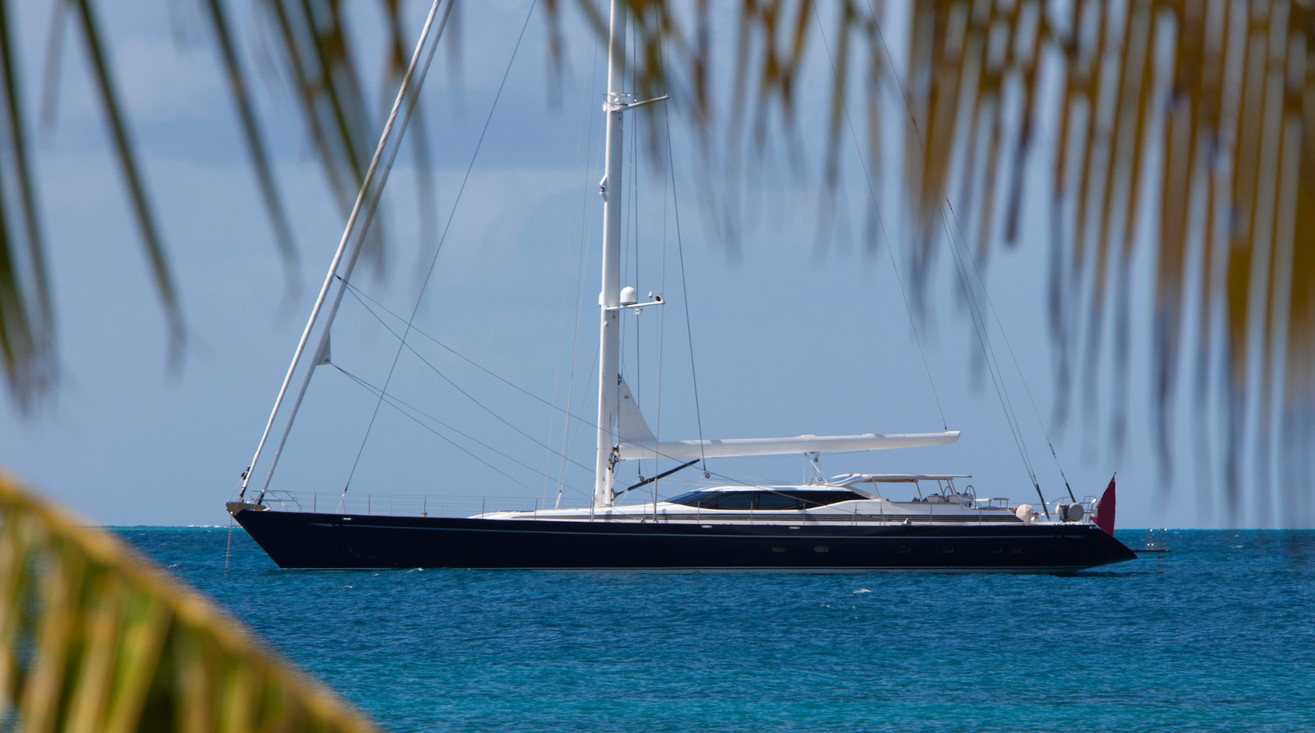
Length : 37 m / Passengers : 8
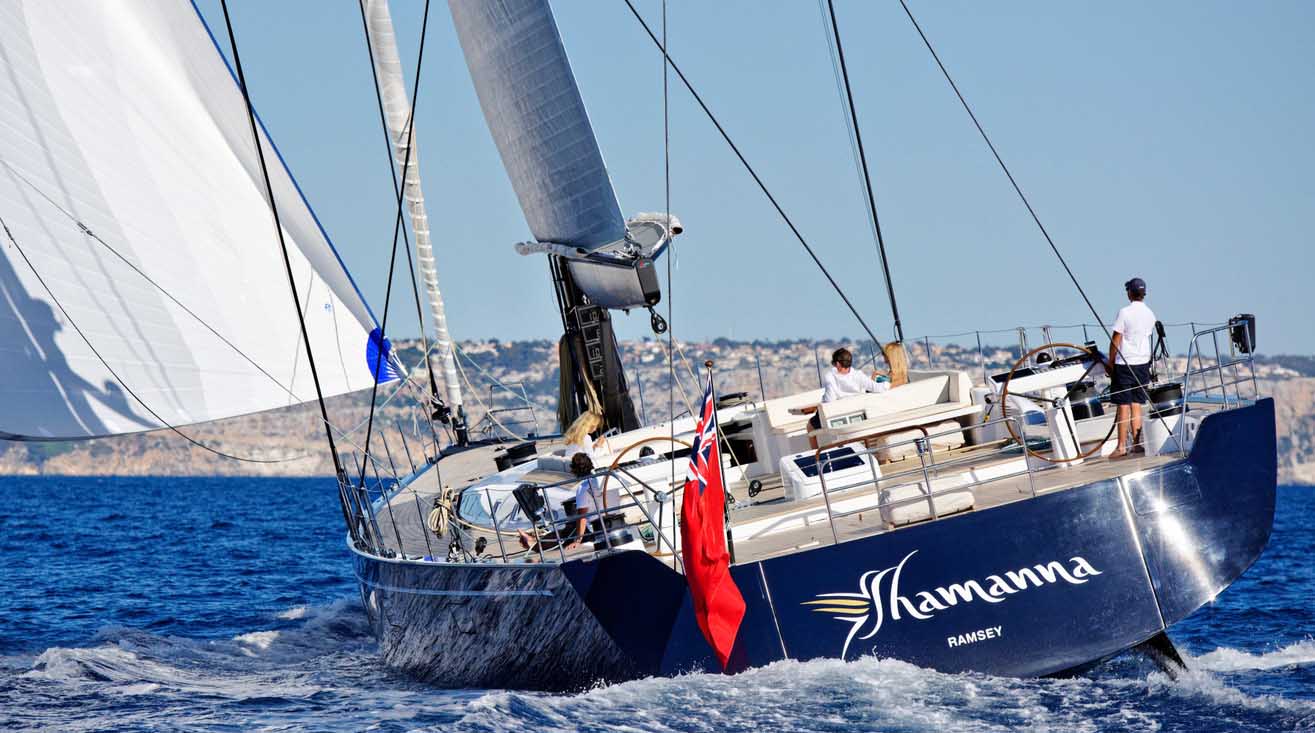
Length : 35.2 m / Passengers : 6
Special features : - High tech performance sailing yacht- Plumb bow and wide stern for improved performance and stability- Twin rudders for increased responsiveness- Aerodynamic...
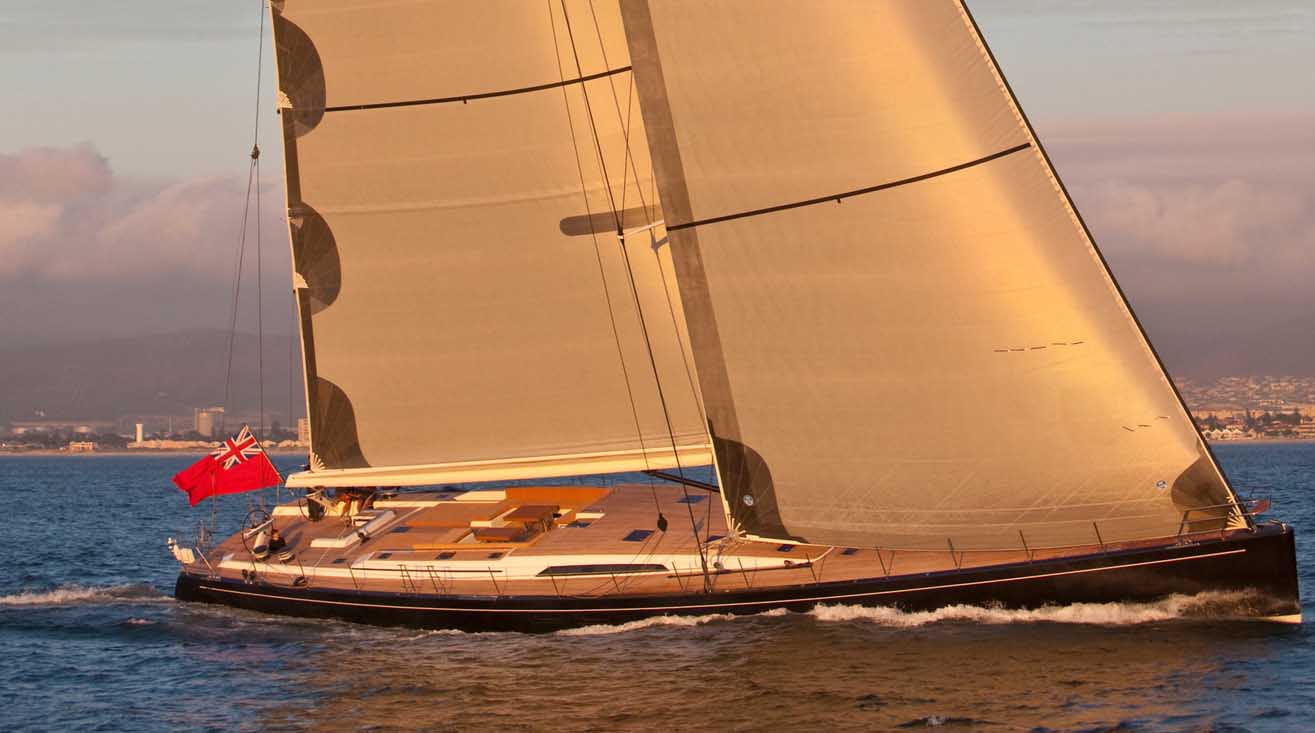
Length : 33.7 m / Passengers : 8
Special features : - Five Stars Crew with an outstanding Chef led by Captain Eddy- Best combination of Elegance and High Performance Sailing yacht- New sails ( DFI aramide...
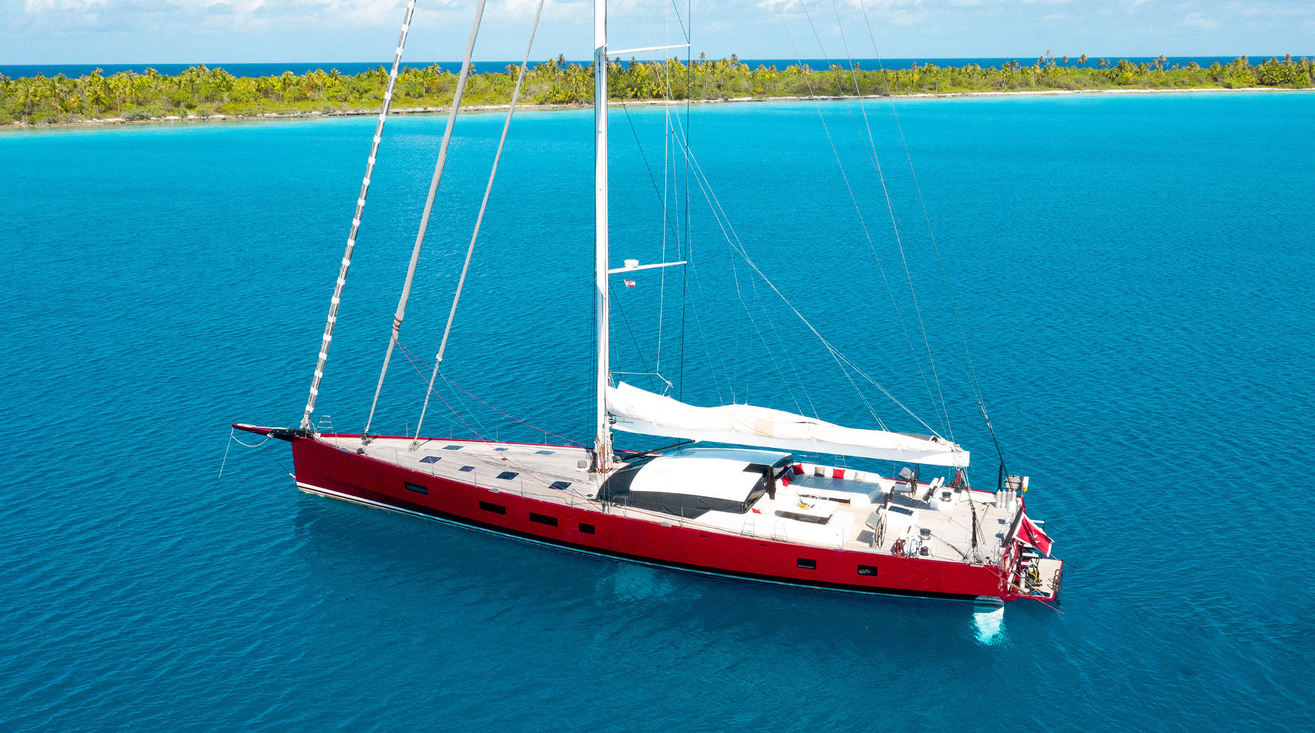
Length : 30.48 m / Passengers : 12
Special features : - Gold medal winner for the RORC Transatlantic 2015, setting a new record. This performance yacht with the sensation of speed and power is equipped with...
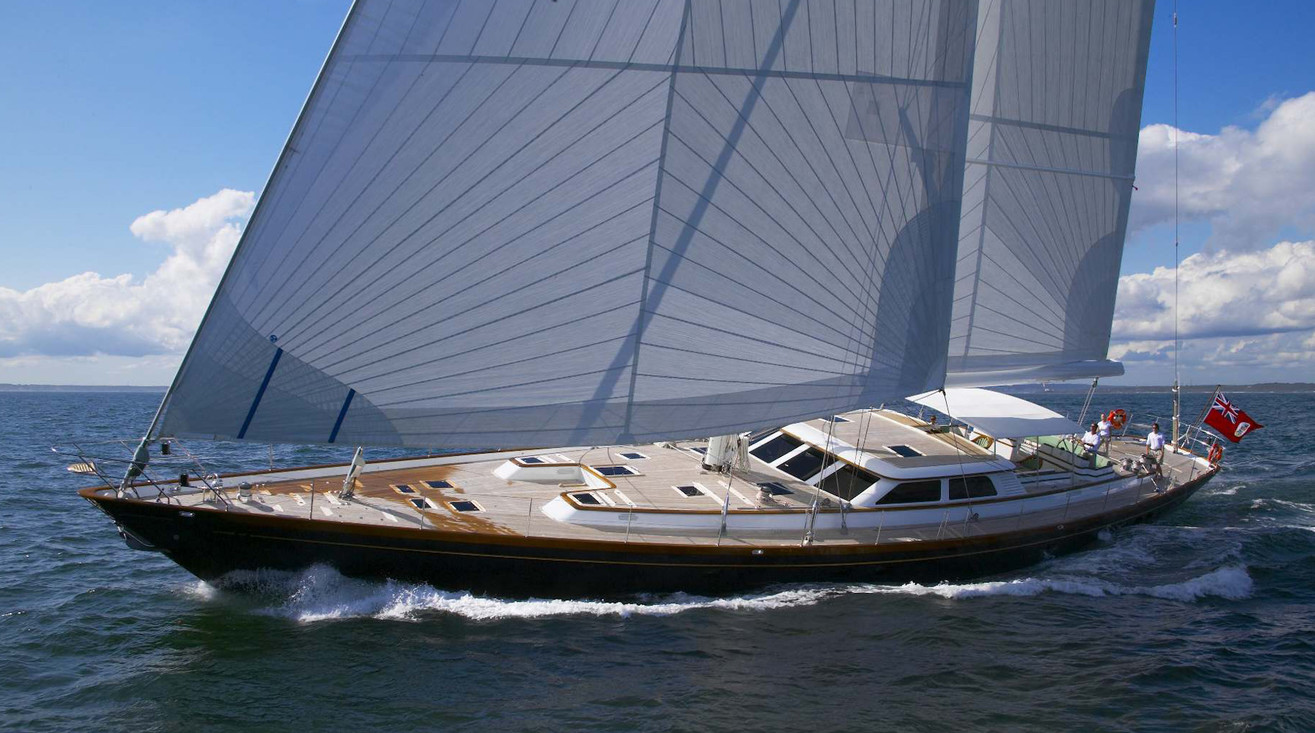
Length : 35.36 m / Passengers : 6
Special features : Tender: 115 Hp Yamaha on 15' Rendova
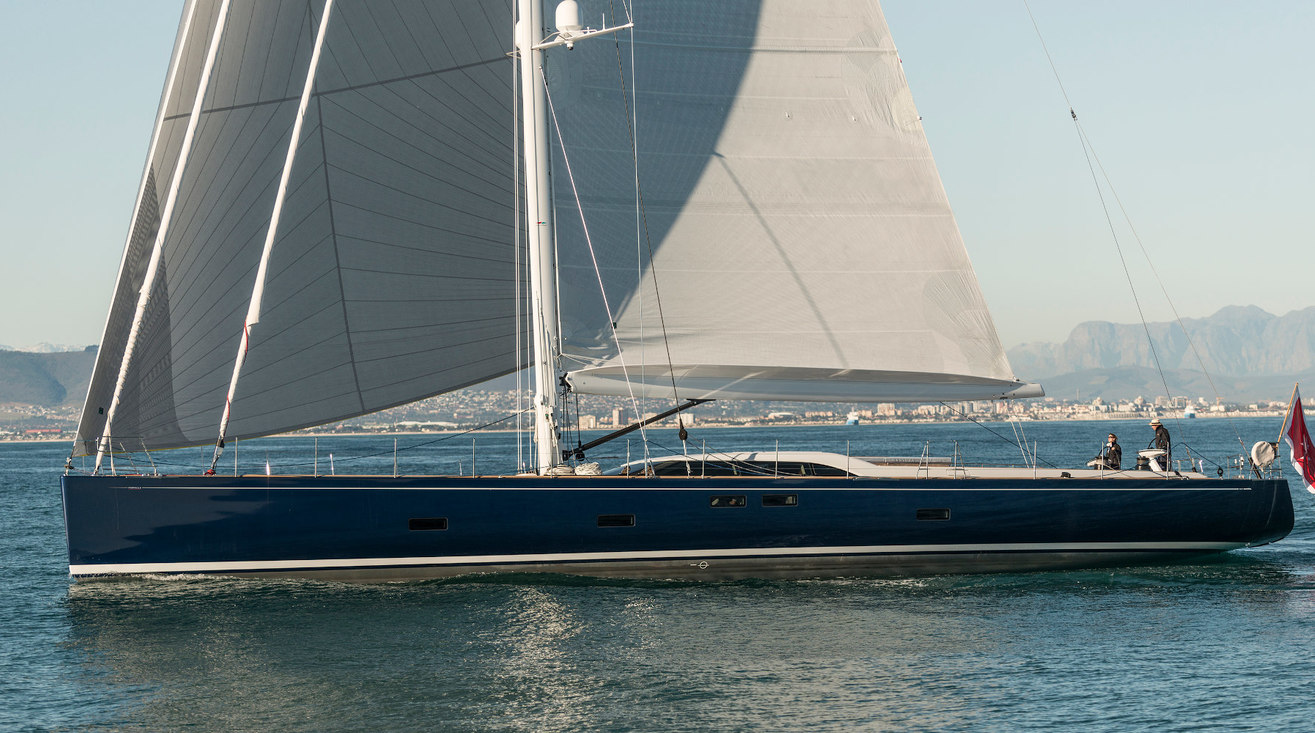
Length : 31.78 m / Passengers : 8
Special features : KEY FEATURES- Awarded the prestigious Quality and Value award at the 2015 World Superyacht Awards- Offers high performance sailing with first class...
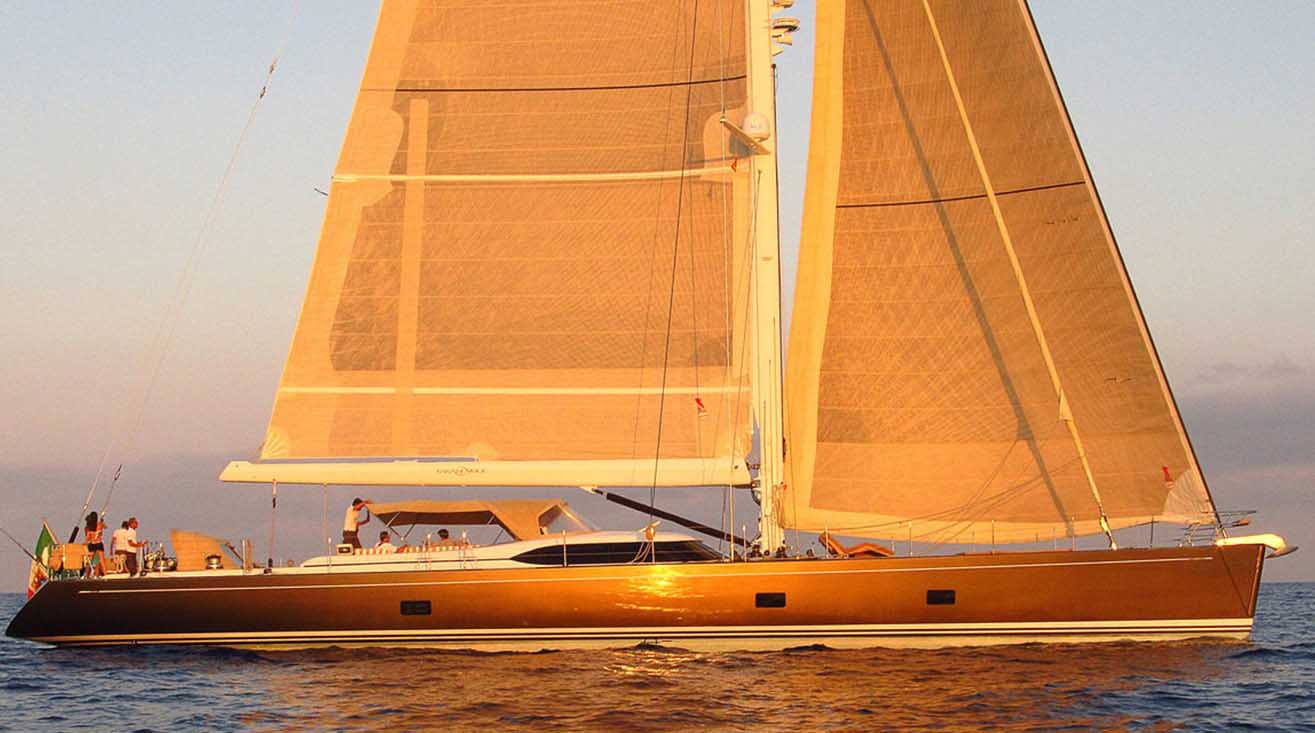
Length : 30.2 m / Passengers : 8
Special features : - One of the most elegant SW100- Excellent and experienced crew- Very elegant interiors- Available in West and East Med- Large outdoor spaceTender: 4.30...
- Receive the brochure of this yacht
- FR +33 AC +247 AD +376 AE +971 AF +93 AG +1 AI +1 AL +355 AM +374 AO +244 AR +54 AS +1 AT +43 AU +61 AW +297 AX +358 AZ +994 BA +387 BB +1 BD +880 BE +32 BF +226 BG +359 BH +973 BI +257 BJ +229 BL +590 BM +1 BN +673 BO +591 BQ +599 BR +55 BS +1 BT +975 BW +267 BY +375 BZ +501 CA +1 CC +61 CD +243 CF +236 CG +242 CH +41 CI +225 CK +682 CL +56 CM +237 CN +86 CO +57 CR +506 CU +53 CV +238 CW +599 CX +61 CY +357 CZ +420 DE +49 DJ +253 DK +45 DM +1 DO +1 DZ +213 EC +593 EE +372 EG +20 EH +212 ER +291 ES +34 ET +251 FI +358 FJ +679 FK +500 FM +691 FO +298 FR +33 GA +241 GB +44 GD +1 GE +995 GF +594 GG +44 GH +233 GI +350 GL +299 GM +220 GN +224 GP +590 GR +30 GT +502 GU +1 GW +245 GY +592 HK +852 HN +504 HR +385 HT +509 HU +36 ID +62 IE +353 IL +972 IM +44 IN +91 IQ +964 IR +98 IS +354 IT +39 JE +44 JM +1 JO +962 JP +81 KE +254 KG +996 KH +855 KI +686 KM +269 KN +1 KP +850 KR +82 KW +965 KY +1 KZ +7 LA +856 LB +961 LC +1 LI +423 LK +94 LR +231 LS +266 LT +370 LU +352 LV +371 LY +218 MA +212 MC +377 MD +373 ME +382 MF +590 MG +261 MH +692 MK +389 ML +223 MM +95 MN +976 MO +853 MP +1 MQ +596 MR +222 MS +1 MT +356 MU +230 MV +960 MW +265 MX +52 MY +60 MZ +258 NA +264 NC +687 NE +227 NF +672 NG +234 NI +505 NL +31 NO +47 NP +977 NR +674 NU +683 NZ +64 OM +968 PA +507 PE +51 PF +689 PG +675 PH +63 PK +92 PL +48 PM +508 PR +1 PS +970 PT +351 PW +680 PY +595 QA +974 RE +262 RO +40 RS +381 RU +7 RW +250 SA +966 SB +677 SC +248 SD +249 SE +46 SG +65 SH +290 SI +386 SJ +47 SK +421 SL +232 SM +378 SN +221 SO +252 SR +597 SS +211 ST +239 SV +503 SX +1 SY +963 SZ +268 TC +1 TD +235 TG +228 TH +66 TJ +992 TL +670 TM +993 TN +216 TO +676 TR +90 TT +1 TV +688 TW +886 TZ +255 UA +380 UG +256 US +1 UY +598 UZ +998 VA +39 VC +1 VE +58 VG +1 VI +1 VN +84 VU +678 WF +681 WS +685 XK +383 YE +967 YT +262 ZA +27 ZM +260 ZW +263
Thanks for contacting us. We will get back to you shortly.
Une erreur s'est produite. Merci de rééssayer.
Contact us
Send message

About Amadeus
Charter rates.
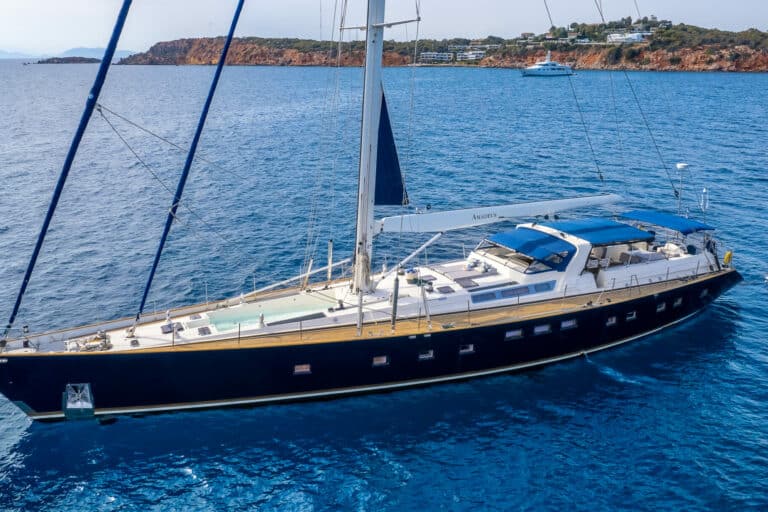
specifications
- Length 33.52M (110′)
- Beam 7.53M (25′-4″)
Builder Dynamique Yachts
- Year of build 1996
Tenders & Toys
- Fishing equipment
- inflatable canoes
- On deck pool
- Snorkeling gear
Talk to our experts
Looking for a yacht charter? We’re happy to help! Please call the number below, send an email or contact us via WhatsApp.

Maxim Beckers

Carl-Antoine Saverys
Share this yacht, related yachts for charter.
© EXMAR YACHTING | All rights reserved
Subscribe to receive the latest news
Contact our team.
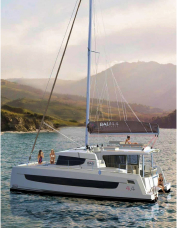
Sales Department
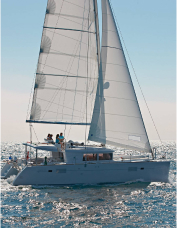
Crewed Department
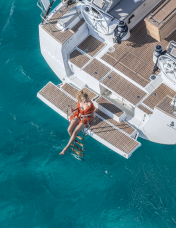
Bareboat Department
- Sailing Yachts
- Motor Sailers
- Motor Yachts
- Our bareboat bases in Greece
- Yacht Management
- Technical Support / After-sales services
- Concierge services
Vernicos Yachts
Get in Touch
Sales Department: [email protected]
Crewed Department: [email protected]
Bareboat Department: [email protected]
Other: [email protected]
T : +30 210 9896 000
Ideas for you
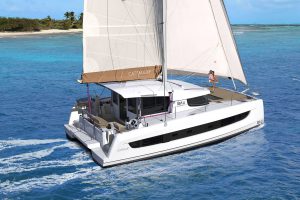
BALI Catsmart
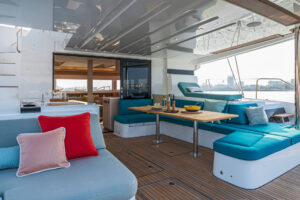
BAVARIA Cruiser 51
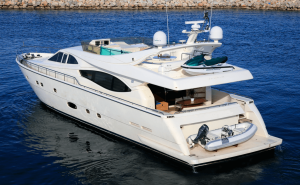
Private: FERRETTI 760
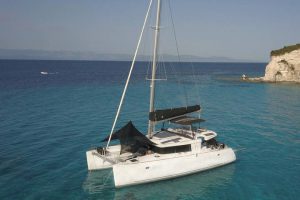
Lagoon 450F “ZACAPA”
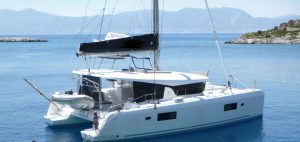
LAGOON 42 “ALEXANDROS”
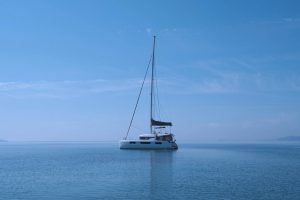
LAGOON 50 “VICTORIA”
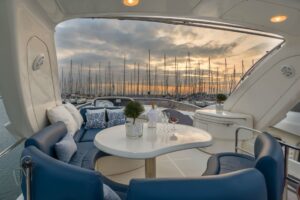
BARACUDA VALLETTA
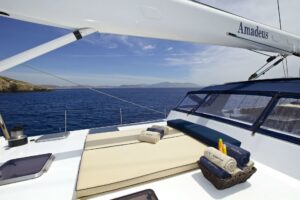
Bareboat yacht charter in Greece
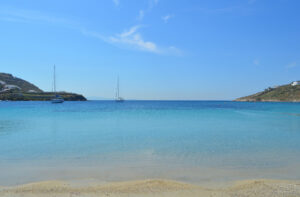
Best beaches for Mykonos boat trips
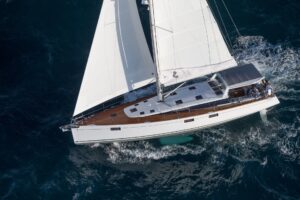
Boats for sale in Greece
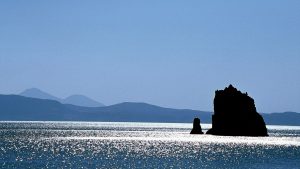
Bareboat Yachts
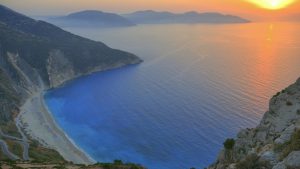
Bareboat Bases
or chat with an expert
Contact our charter team
Crewed Team
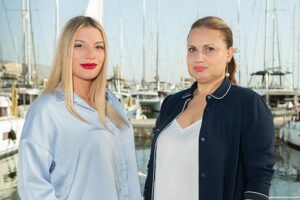
Send me a message
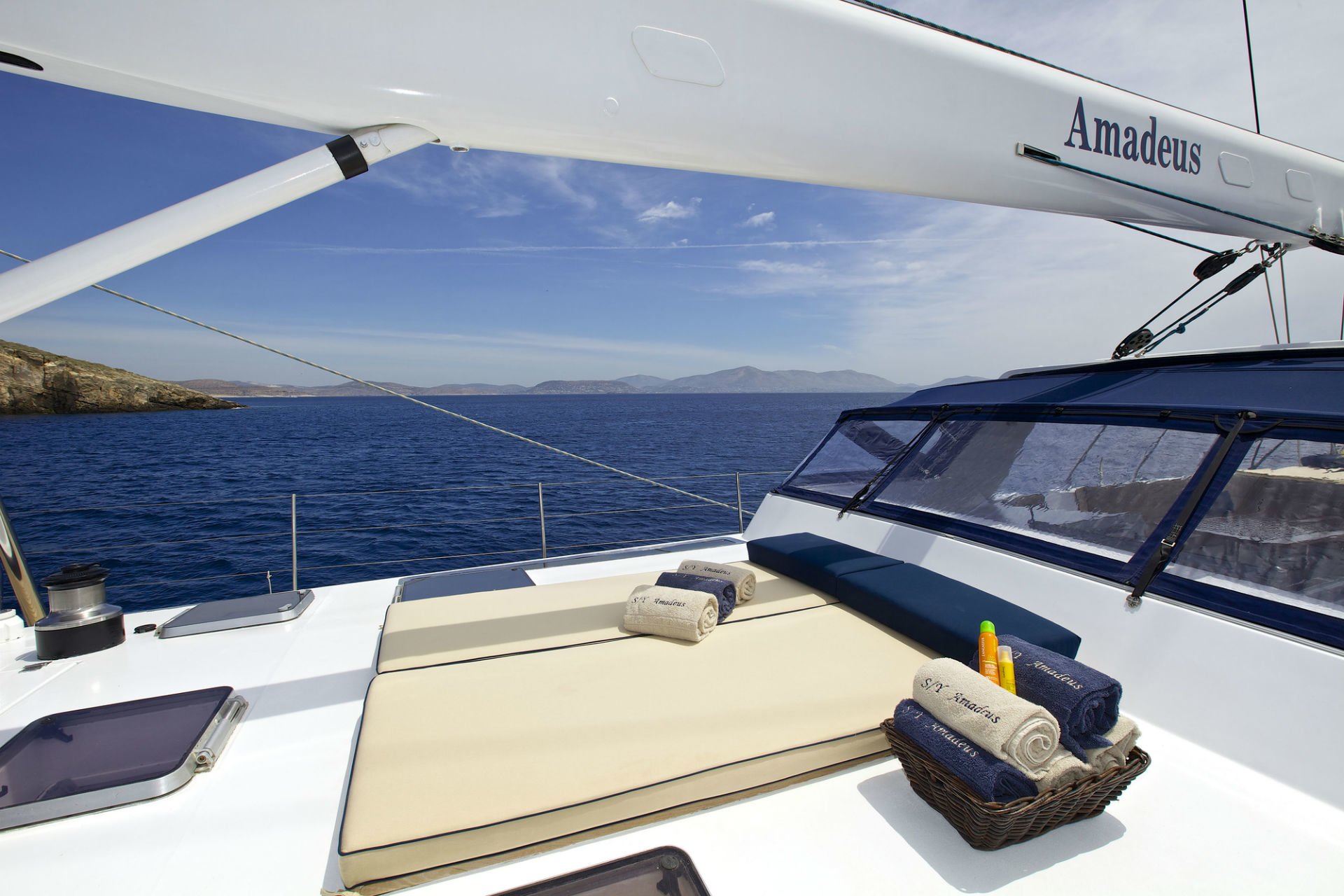
Built by the famous Dynamique Yachts shipyard, and having undergone a total refit in 2014, S/Y Amadeus was designed to please the most demanding of yachtsmen.
Built for smooth sailing, this elegant cutter rigged sloop has a sleek hull design, comfortably reaching top speeds of 12 knots and ensuring excellent sailing performance. Accommodation is offered for up to 12 guests in 5 spacious cabins (one master cabin, two identical double cabins with additional single bunks, two identical twin cabins) all with en suite facilities and audio/visual entertainment.
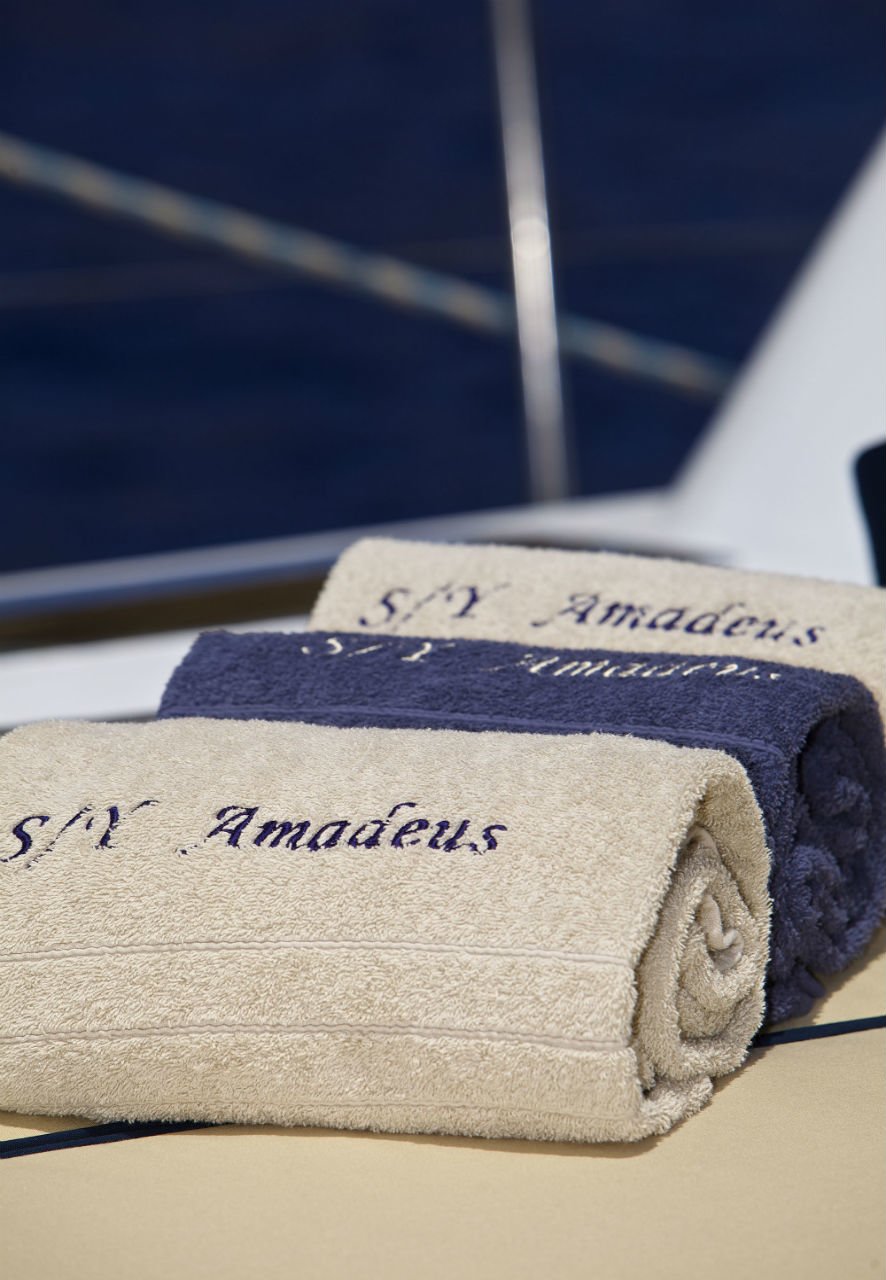
General Description
Carian Coast, Ionian Islands
Dynamique Yachts
1996 / 2018
Rates (MYBA Terms: + ALL)
45,500 € per week
35,000 € per week
2018 Nuvorania tender 4.60m Outboard EVINRUDE 75hp Splash pool Water Skis (adult and kids) Mono Ski Wakeboard
2 Tubes Inflatable Kayak Fishing Gear Snorkeling Equipment 4 Yoga mats
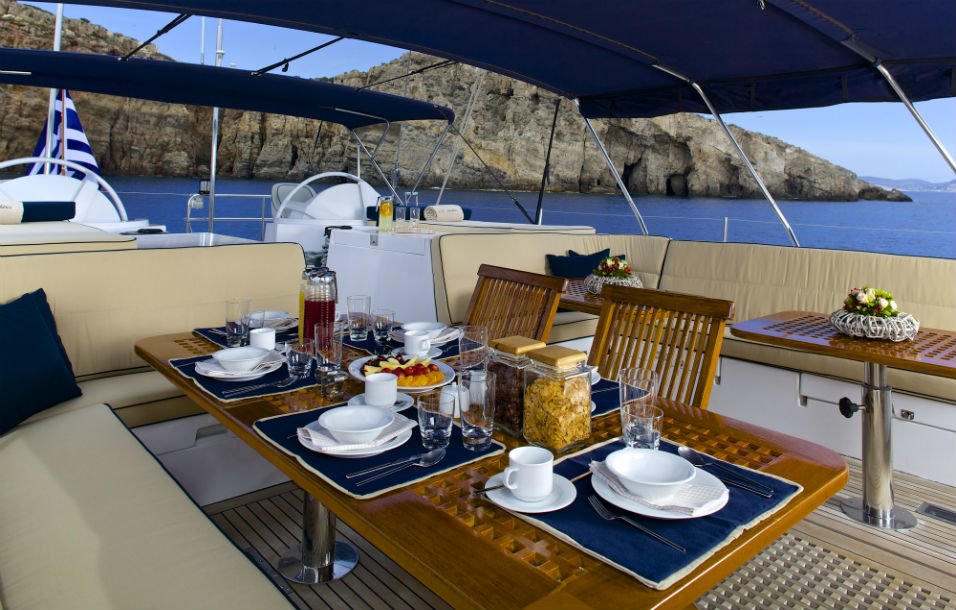
Destinations
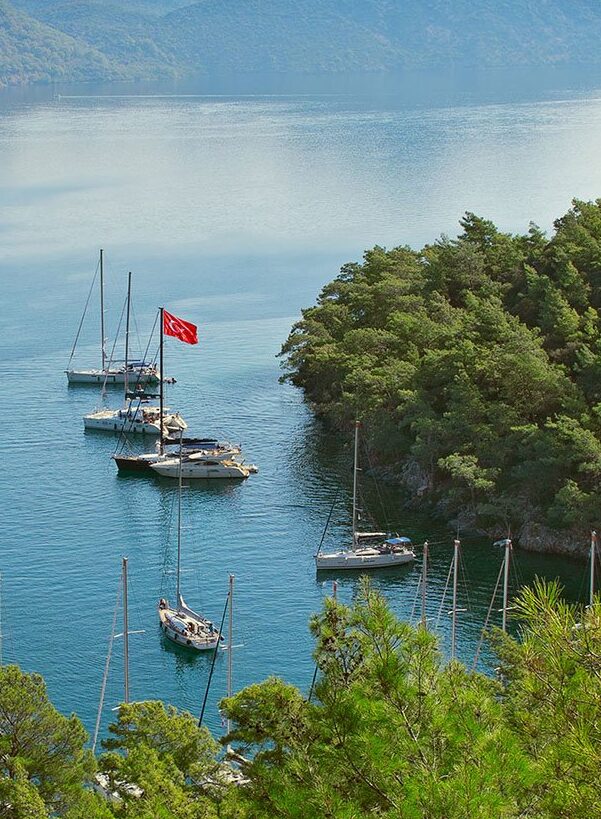
Carian Coast
Superb historical sites set in magnificent scenery
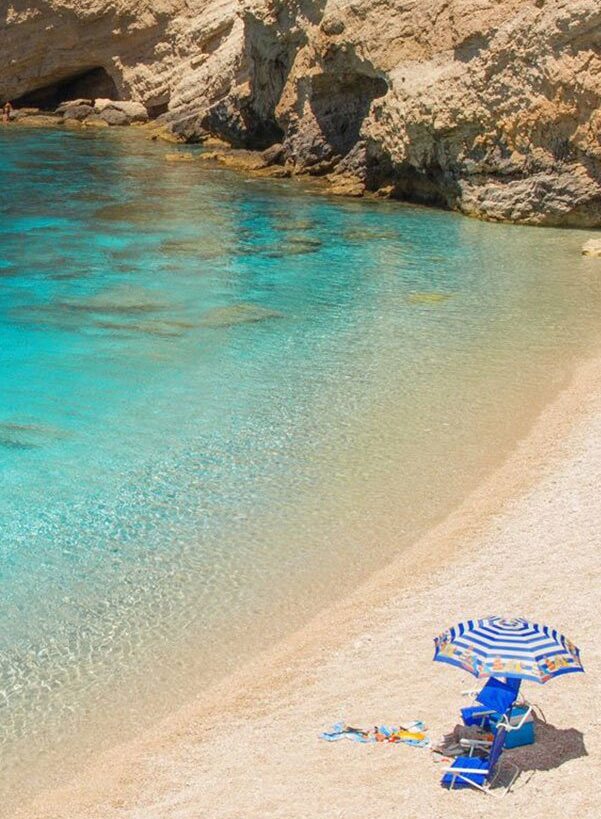
Ionian Islands
Unforgettable Sailing Holidays
Request Availability
Get in touch for the yacht: AMADEUS
Download Brochure
Download brochure for the yacht
Add to Favourites
Keep track of your preferred yachts and access them quickly whenever you revisit our website.
AMADEUS Dynamique Yachts SA
- Inspiration
AMADEUS has 2 Photos
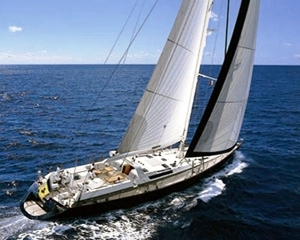
Amadeus News
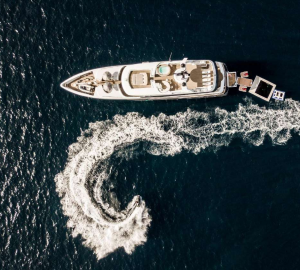
Reduced charter rate offered by 44m ...
Similar yachts.
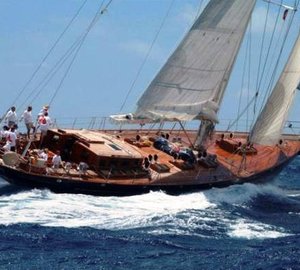
SHAMOUN | From US$ 65,100/wk
- Yachts >
- All Yachts >
- All Sail Boats Over 100ft/30m >
If you have any questions about the AMADEUS information page below please contact us .
A General Description of Sailing Yacht AMADEUS
AMADEUS was previously registered as project/yacht name Amadeus 1er. This 33 metre (109 ft) luxury yacht was built by Dynamique Yachts in 1991. Sailing Yacht AMADEUS is a well proportioned superyacht. The yacht is a modern sloop with a cutter rig. The naval architecture office whom authored the design work on this ship was Philippe Briand. Luxury yacht AMADEUS is a quality yacht that is able to accommodate as many as 12 guests on board and has a total of 5 crew members.
Sailing yacht AMADEUS was built by the famous Dynamique Yachts shipyard .The yacht features superb sailing characteristics which are complimented by her spacious interior and abundant deck space. Sailing sloop AMADEUS can accommodate 10 passengers in five cabins. With one large master stateroom and four additional cabins which are all air conditioned and have en suite bathrooms. She also has two separate salons and a full dining room. The aft deck is fully covered with seating. The fore deck has an unique pool on deck and swimming in the sea is made accessible by a large swim aft platform.
The Construction & Naval Architecture relating to Luxury Yacht AMADEUS
Philippe Briand was the naval architect firm involved in the formal nautical design work for AMADEUS. Also the company Philippe Briand skillfully collaborated on this undertaking. In 1991 she was actually launched to triumph in Marans and following sea trials and final completion was afterwards passed on to the yacht owner. Dynamique Yachts completed their new build sailing yacht in France. A reasonable proportion is brought about with a maximum beam (width) of 7.5 metres / 24.6 feet. With a 3.6m (11.8ft) draught (maximum depth) she is reasonably deep. The material composite was used in the building of the hull of the sailing yacht. Her superstructure above deck is built with the use of composite. Over the deck of AMADEUS she is 32.7 (107.3 ft) in length. In 2004 extra refitting and modernisation was also finished.
Engines & Speed For S/Y AMADEUS:
She is driven by twin screw propellers. The main engine of the ship gives 375 horse power (or 276 kilowatts). She is equiped with 2 engines. The combined thrust for the boat is therefore 750 HP / 552 KW.
On board Superyacht AMADEUS She has The Following Guest Accommodation Format:
Bestowing bedding for a maximum of 12 yacht guests sleeping aboard, the AMADEUS accommodates them in style. Normally the vessel requires approximately 5 professional crewmembers to run.
A List of the Specifications of the AMADEUS:
Further information on the yacht.
Condaria is the company that installed the A/C on the yacht. AMADEUS features a teak deck.
AMADEUS Disclaimer:
The luxury yacht AMADEUS displayed on this page is merely informational and she is not necessarily available for yacht charter or for sale, nor is she represented or marketed in anyway by CharterWorld. This web page and the superyacht information contained herein is not contractual. All yacht specifications and informations are displayed in good faith but CharterWorld does not warrant or assume any legal liability or responsibility for the current accuracy, completeness, validity, or usefulness of any superyacht information and/or images displayed. All boat information is subject to change without prior notice and may not be current.
Quick Enquiry
"Indeed we believe that the first function of a sailing yacht is the aesthetics and we spent a lot of time in refining the lines during the project." - "I understood very young that to win a race you have to have the best boat, and so I started to be interested about the technology and the design of the boat." - Philippe Briand
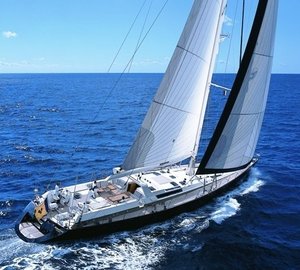
Yan Yelken | From EUR€ 28,980/wk
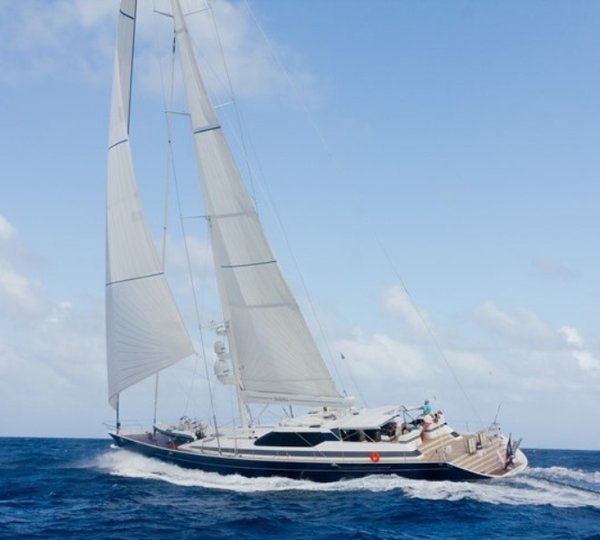
Seaquell | From US$ 40,000/wk
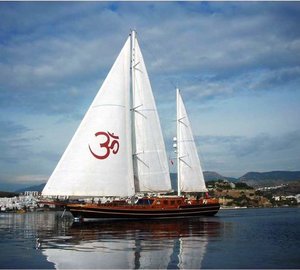
Shanti | From EUR€ 28,000/wk
- Yachts for sale
- Yachts for charter
- Brokerage News
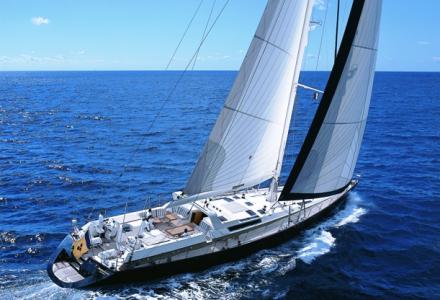
- Yacht Harbour
- Yacht Amadeus
Contact agent, specifications, similar yachts.
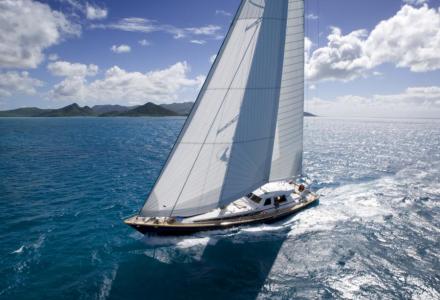
New listings
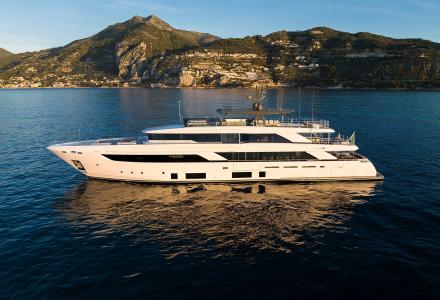
- USA:-1.866.492.4768
- UK:-0800.011.2492
- How We Help Clients
- How to book a charter?
- Why Use Our Company
- Where our Charters Go
- Why Charter a Yacht
- Decades of Experience
- Meet our staff
- Contact us now
- Search charter yachts online
- What type of yacht should I charter?
- About Luxury Yacht Charter
- Charter a Mega Yacht
- Charter a Motor Yacht
- Charter a Crewed Catamaran
- Charter a Sailboat
- Yacht charter Blog
- About Caribbean Yacht Charters
- Virgin Islands
- Leeward Islands
- Windward Islands
- Yachts in the Caribbean
- About Bahamas Yacht Charters
- Bahamas weather
- Yachts in the Bahamas
- Western Mediterranean Yacht Charters
- Eastern Mediterranean Charters
- Browse Yachts in the Mediterranean
- South of France
- Spain, Mallorca, Ibiza
- Italy, Sicily, Naples & Amalfi
- Corsica and Sardinia
- Pacific Islands
- Sample Charter Itineraries
- Destinations Blog
- How to choose a yacht charter broker?
- How to book a yacht charter?
- What is special about yacht charter?
- What yacht charter costs are there ?
- Are there all inclusive charters?
- Why charter a yacht?
- What kinds of yacht can I charter?
- Where do yacht charters go?
- What defines luxury yacht charter?
- How to rent a yacht?
- How We Help
- 5 Common Yacht Charter Questions
- How to choose the right yacht?
- When is the best time to charter?
- All Yacht Charter Destinations
- What can you do on a yachting vacation?
- What to expect on a luxury charter?
- What contracts are used to book?
- Even more questions about chartering a yacht
- Crewed charter reviews
- Caribbean Reviews
- BVI Reviews
- Bahamas Reviews
- Mediterranean Reviews
- Email or Call Us

AMADEUS 110' Fully Crewed Sailing Yacht
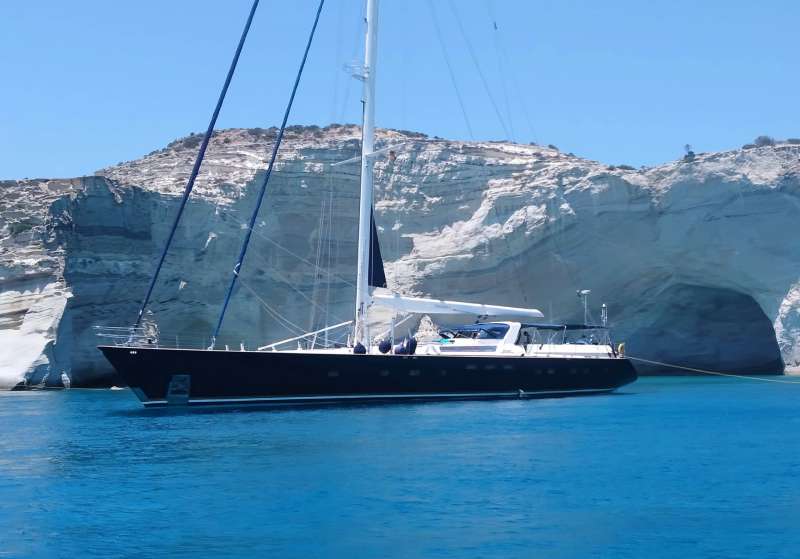
- Summer Locations: Greece , Turkey Winter Locations: Greece
- Max Guests : 12 Cabins : 5 Crew : 6
- Starting at : EUR €39,500 (approx. $45,820 USD )
Charter rates do not include expenses or taxes
Her master cabin features a walk around king bed, desk/vanity, and en-suite bathroom. Additionally, there are two guest cabins each with a queen bed convertible to two twins, and two guest cabins each with a queen bed and twin bed. Each guest cabin has an en-suite.
Her main salon has a spacious, contoured conversational area, along with a large, flatscreen T.V. The aft deck features al fresco dining with Bimini top. Up on deck there are sun pads and a splash pool for you and your guests to enjoy.
Watersports offered include a 15 foot tender with 75hp engine, water skis for adults and children, tube, wakeboard, kayak, fishing gear, snorkeling gear, and rendezvous diving.
Additional Images
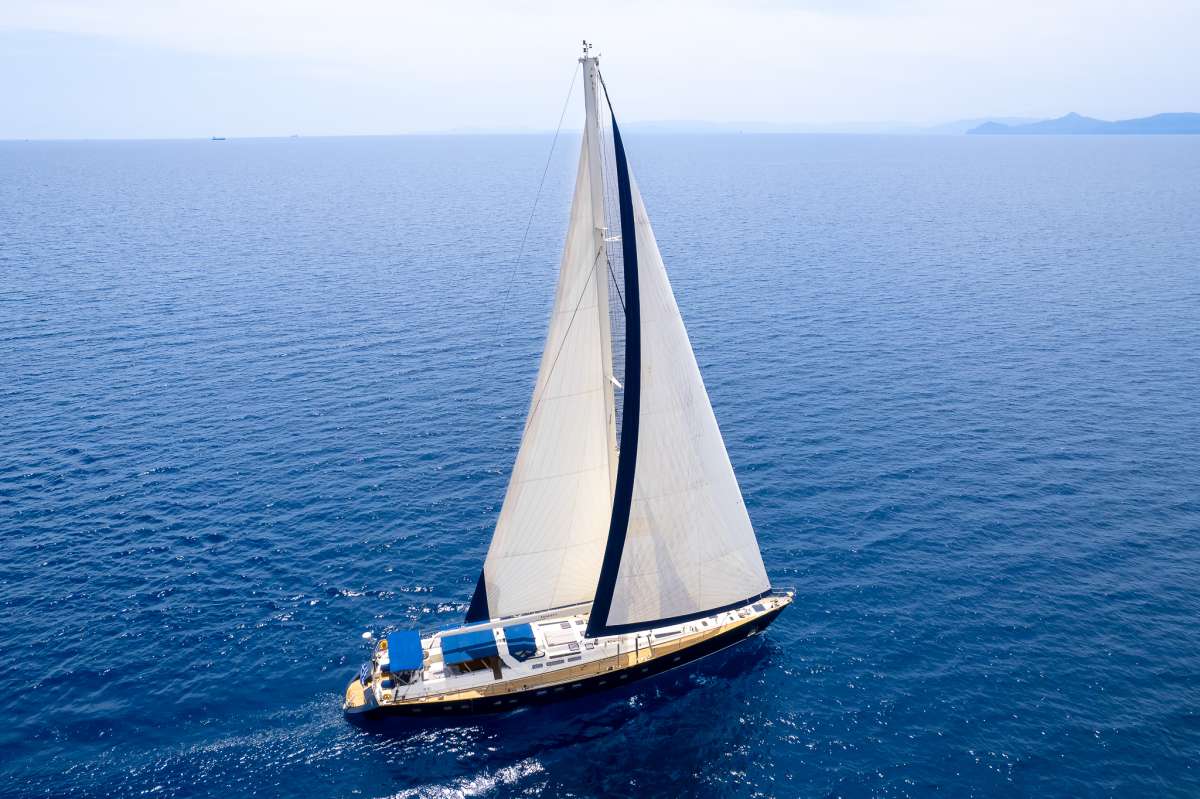
Does this yacht interest you?
Let us know a few details below, we'll check availability and answer all your questions:.
Even faster answer? Call Toll Free from USA/Canada: 1 866.492.4768 , Direct 1.954.448.5053
Send Message
Additional Sailing Yachts with 5 cabins:
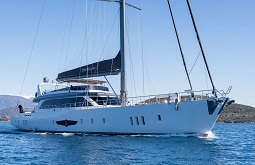
LONG ISLAND 127' sailing yacht
Can sleep up to 10 guests in 5 staterooms Weekly rate starts at: EUR €45,500 (approx. $52,780 USD)
Summer Locations: Turkey
See additional pictures and info about LONG ISLAND » Contact us about LONG ISLAND »
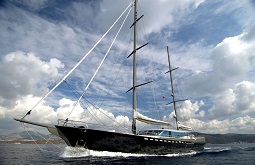
TIGRA 124' sailing yacht
Can sleep up to 10 guests in 5 staterooms Weekly rate starts at: EUR €32,000 (approx. $37,120 USD)
Winter Locations: Greece , Turkey
Summer Locations: Greece , Turkey
See additional pictures and info about TIGRA » Contact us about TIGRA »
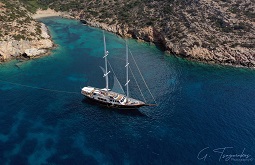
ALTHEA 122' sailing yacht
Can sleep up to 10 guests in 5 staterooms Weekly rate starts at: EUR €39,500 (approx. $45,820 USD)
Winter Locations: Greece
Summer Locations: Greece
See additional pictures and info about ALTHEA » Contact us about ALTHEA »
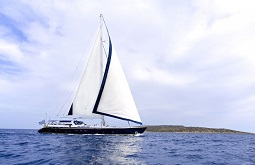
AMADEUS 110' sailing yacht
Can sleep up to 12 guests in 5 staterooms Weekly rate starts at: EUR €39,500 (approx. $45,820 USD)
See additional pictures and info about AMADEUS » Contact us about AMADEUS »
Yacht Name Search
Do you have a particular yacht in mind? We likely have it online and if not, email or call us for details. Search for it online by name here:
See Charter Yachts by region:
- Yachts in the Mediterranean
- Why you should choose us
Read more about charter yacht types:
- Mega Yachts
- Sailing yachts
International Yacht Charter Group Inc. does not guarantee the accuracy of any information or images displayed. Both are subject to change and may not be current. All information contained herein is not contractual. Continue reading for more details: 2003 - 2023 © All Rights Reserved. Privacy Policy Site map

Sailing Yacht | Amadeus

Fuel Capacity
Water capacity, sailing yacht amadeus | luxury crewed monohull.
Sailing yacht AMADEUS is a stunning 110 ft yacht available for charter in Greece. With a clean, spacious teak deck and a unique outdoor saloon that can seat up to 12 guests across two tables, it’s the perfect place for outdoor dining and entertainment. The deck saloon can also be enclosed with a special canopy and roll-up windows, making it suitable for use in all weather conditions. At the front of the boat, there’s a splash pool and sunbathing area with a removable awning for shade.
Inside the boat, a staircase from the cockpit leads to a well-lit and roomy saloon area with plenty of seating, including a formal dining area, bar, LCD TV, entertainment center, iPod dock station, and Playstation. Sailing Yacht AMADEUS can accommodate 10-12 guests in five large cabins, including a full-width master stateroom and two double cabins, each with an extra single bed. The two twin cabins can also be converted to doubles upon request, making her the only sailboat on the Greek market with five double beds.
To add to the fun, sailing yacht AMADEUS also comes with a range of water toys, including adult and children’s water skis, tubes, inflatable canoes, wakeboard, fishing rod, and snorkeling gear. She was built by Dynamique Yachts in 1996 and underwent a refit in 2014/2018.
ACCOMMODATION
- 1 Master cabin
- 2 VIP cabins
- 2 Twin cabins
Accomodation is offered for 10 -12 guests in 5 spacious cabins: Master cabin forward features a double bed, vanity unit and generous storage facilities, as well as audio/visual entertainment. The en-suite includess a large bath tub, shower and separate WC. Two identical double cabins with additional single bunks situated forward. Two identical double cabins situated aft which can be convertible to twins. (Total 5 double beds) All cabins with en suite facilities and audio/visual entertainment.
A professional crew of 5-6 members are accommodated in separate quarters.
Note that these specifications may vary slightly depending on the specific yacht’s configuration and modifications made by the owner.
New rigging BSI Denmark (2018) New North Sails (2016) Nuvorania tender 4.60m with a New Outboard EVINRUDE E tec 75hp Engines: 2 x 320HP Perkins Rolls Royce Generators: 1 Northern Lights x 25KW, 1 ONAN x 60KW Cruising speed: 10 Fuel consumption: 120 Litres/Hr Generators: 250 Liters/Day
Navigation and safety
- Outside GPS plotter
- Bow thruster
- Electric winches
- Classic mainsail
Saloon and cabins
- Air conditioning
- Coffee machine
- Kitchen utensils
- Pillows and blankets
Entertainment
- LCD 27″ TV, VCR, & CD entertainment systems in Saloon
- X-Box ONE X & Playstation 3 in Saloon
- Master cabin: TV, CD, & DVD entertainment systems
- Double cabins: TV, CD, & DVD entertainment systems
- Twin cabins (convertible to Doubles):TV, CD, & DVD entertainment systems
Water Sports
- Tender & Toys:
- 2018 Nuvorania tender 4.60m with a New Outboard EVINRUDE E tec75hp
- Water Skis (adult and kids)
- Inflatable Kayak
- Fishing Gear
- Snorkelling Equipment
- 4 Yoga mats
- Bathing platform
- Stand Up Paddle
Weekly price: €35,000 – €42,500
Low Season | High Season
Charter Type: Crewed
Berths: 10-12 guests, sailing area: argo-saronic, departure ports: alimos, athens, send us your request, personal information, booking information.
Odyssey Sailing is registered and bonded with the Greek National Tourist Organisation (GNTO – EOT) and is a member of the Hellenic Yacht Brokers Association (HYBA).
SOCIAL MEDIA
Useful links.
Antonopoulou 158D Volos, 38221, Greece
JOIN OUR NEWSLETTER
By subscribing to the Odyssey Sailing newsletter you agree to allow us collecting information about your open and click rates in order for us to develop further newsletter campaigns for our subscribers.

Length 33,5m / 109′ ft.
Built/Last Refit 2009/2021
Weekly rate Low € 35.000
Weekly rate High € 45.500
Accommodation
Luxury yacht AMADEUS can accommodate up to 12 guests in 5 cabins. One Master cabin with small desk and en suite facilities (wc separate from bath and shower). Two double cabins with additional single bed and two twin cabins. All cabins with en suite facilities.
Charter Amenities and Extras
S/Y AMADEUS has the following extras onboard: Tenders & Toys include Novourania tender 4.20m with YAMAHA X 70hp plus, MERCURY x 10hp, Water Skis, Mono Ski, Wakeboard, 2 Tubes, Fishing Gear, Snorkelling Equipment, Communications include VHF-GMDSS, Cellular phone, Radar, E-Mail/internet access, Audio Visual Equipment and Deck Facilities include Master cabin: TV, CD, & DVD entertainment system, Double cabins: TV, CD, & DVD entertainment system, Twin cabins: TV, CD, & DVD entertainment system, Saloon: LCD 27’ TV, VCR, & CD entertainment system.

Leave a comment Cancel reply
Save my name, email, and website in this browser for the next time I comment.
By using this form you agree with the storage and handling of your data by this website. *
This site uses functional cookies and external scripts to improve your experience.
Privacy settings
Privacy Settings
This site uses functional cookies and external scripts to improve your experience. Which cookies and scripts are used and how they impact your visit is specified on the left. You may change your settings at any time. Your choices will not impact your visit.
NOTE: These settings will only apply to the browser and device you are currently using.
Cookie Consent
This site uses cookies to offer you a better browsing experience. By using Hellas Yachting, you agree to our Privacy Policy, including cookie policy.
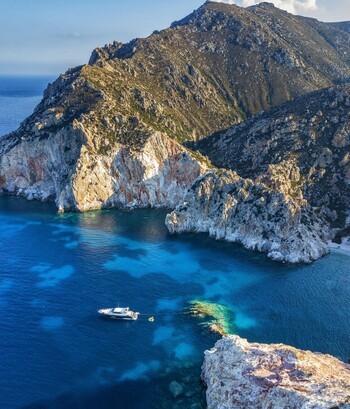
Discover more!
Sign up to receive inspiration on Yachting, the Mediterranean Lifestyle & Special Offers, the Valef way
*By completing this form you are signing up to receive our emails and can unsubscribe at any time
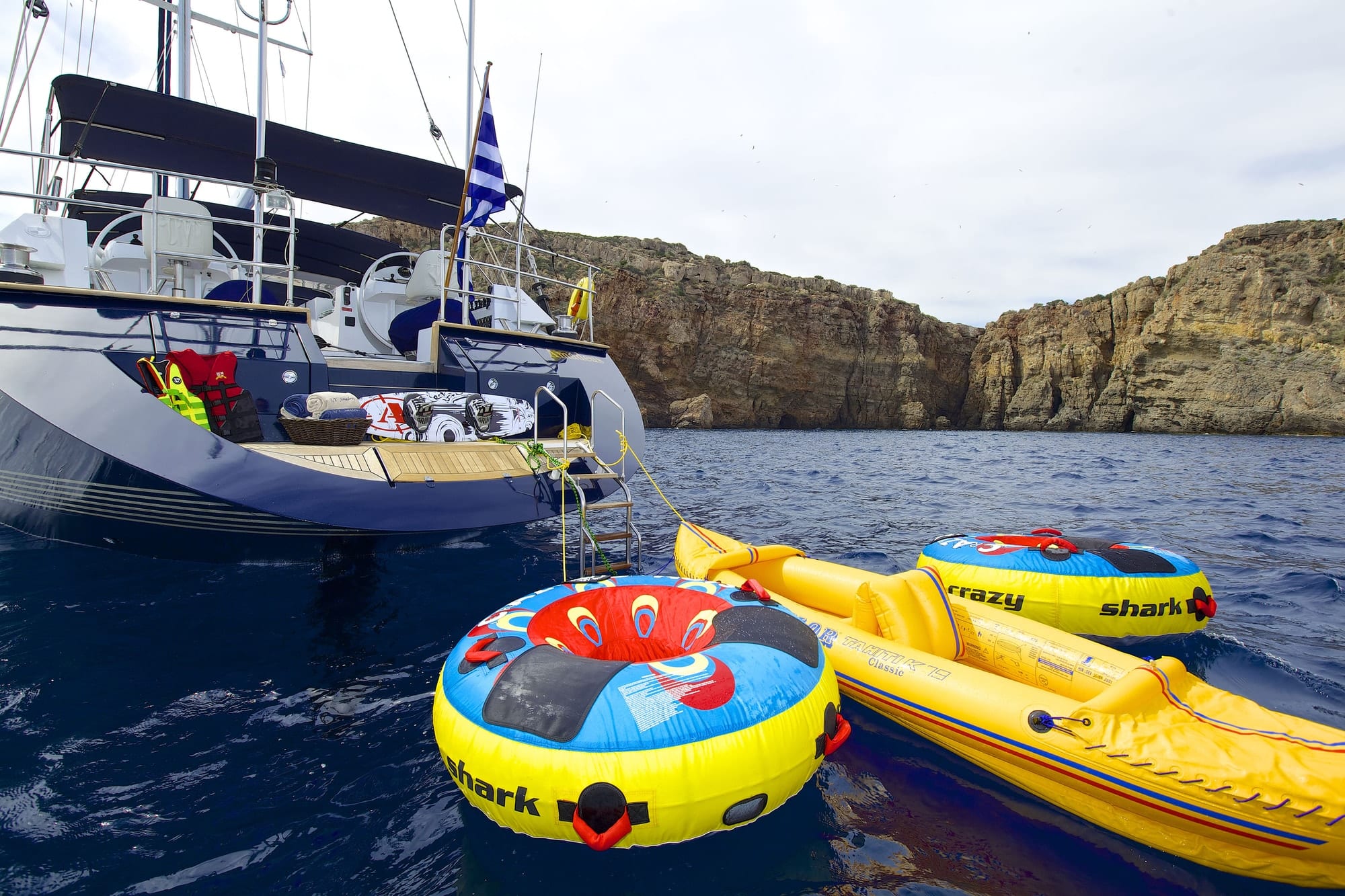
Charter the AMADEUS
AMADEUS is a 110-foot sailing yacht that can accommodate ten to twelve passengers in five staterooms as follows: a spacious Owner’s stateroom with a double bed, a vanity and an entertainment unit including TV, DVD and music system; two cabins with a double bed and an additional single bed; two cabins with two twin beds each. All staterooms have en suite bathrooms, a TV, DVD and CD player. There are two separate salons onboard as well as a full dining room. The aft deck is fully covered and has seating for all guests to dine in the open air. Forward of the cockpit is a lovely cushioned area for sunning and an unusual pool is found in the fore of the yacht. Swimming in the sea is made accessible by the large swim aft platform.
Image Gallery

Yacht Specifications:
Length: (33.26m/109.11ft), yacht type: sailing yachts, beam: 24.7 ft, built: 1996 | 2018, draft: 12.10 ft, builder: dynamic, guests: 10-12, engines: 2 x 320hp perkins rolls royce, generators: 1 northern lights x 25kw, 1 onan x 60kw, fuel: 120 ltrs/hr, configuration: 1 master cabin, 2 doubles cabins with a single bed each, 2 twin cabins, cruising speed: 10 knots/hr.
(*All specifications are given in good faith and offered for informational purposes only. Yacht inventory, specifications and charter rates are subject to change without prior notice.*)
Recreational Equipment
• NEW Novorania tender 4.60m with NEW EVINRUDE 75hp plus MERCURY x 10hp • Wakeboard • Water Skis (adult and kids), Mono Ski • 2 Tubes • Kayak • 4 Yoga mats • Fishing Gear Snorkelling Equipment
Weekly Rates
High season: €42,500/week, med season: €37,500/week, low season: €35,000/week.
(*Rates are given based on a week charter / Rates are subject to change without notice*)
Customer Reviews
I could no joke die tomorrow and be a happy man. ~ Matthew F.
Although we have traveled just about all over the world, this was probably our best vacation ever. We will be back! ~ Louise Z.
Our trip was FABULOUS! More than exceeded expectations. ~ Anne G.
We have just completed a vacation that I have thought about for a lot of years. Thank you all for making a dream come true!!!! ~ Mae & Bill M.
Everyone is still talking about the trip and I cannot imagine it going any better. ~ Jack D.
Interested in this yacht?
Let us create a custom tailored experience for you..
Country you Live In United States Canada Mexico United Kingdom Afghanistan Albania Algeria American Samoa Andorra Angola Anguilla Antigua and Barbuda Argentina Armenia Armenia Aruba Australia Austria Azerbaijan Azerbaijan Bahamas Bahrain Bangladesh Barbados Belarus Belgium Belize Benin Bermuda Bhutan Bolivia Bonaire Bosnia and Herzegovina Botswana Bouvet Island (Bouvetoya) Brazil British Indian Ocean Territory (Chagos Archipelago) British Virgin Islands Brunei Darussalam Bulgaria Burkina Faso Burundi Cambodia Cameroon Cape Verde Cayman Islands Central African Republic Chad Chile China Christmas Island Cocos (Keeling) Islands Colombia Comoros Congo Congo Cook Islands Costa Rica Cote d'Ivoire Croatia Cuba Curaçao Cyprus Cyprus Czech Republic Denmark Djibouti Dominica Dominican Republic Ecuador Egypt El Salvador Equatorial Guinea Eritrea Estonia Ethiopia Falkland Islands (Malvinas) Faroe Islands Fiji Finland France French Guiana French Polynesia French Southern Territories Gabon Gambia Georgia Georgia Germany Ghana Gibraltar Greece Greenland Grenada Guadeloupe Guam Guatemala Guernsey Guinea Guinea-Bissau Guyana Haiti Heard Island and McDonald Islands Holy See (Vatican City State) Honduras Hong Kong Hungary Iceland India Indonesia Iran Iraq Ireland Isle of Man Israel Italy Jamaica Japan Jersey Jordan Kazakhstan Kazakhstan Kenya Kiribati Korea Korea Kuwait Kyrgyz Republic Lao People's Democratic Republic Latvia Lebanon Lesotho Liberia Libyan Arab Jamahiriya Liechtenstein Lithuania Luxembourg Macao Macedonia Madagascar Malawi Malaysia Maldives Mali Malta Marshall Islands Martinique Mauritania Mauritius Mayotte Micronesia Moldova Monaco Mongolia Montenegro Montserrat Morocco Mozambique Myanmar Namibia Nauru Nepal Netherlands Netherlands Antilles New Caledonia New Zealand Nicaragua Niger Nigeria Niue Norfolk Island Northern Mariana Islands Norway Oman Pakistan Palau Palestinian Territory Panama Papua New Guinea Paraguay Peru Philippines Pitcairn Islands Poland Portugal Puerto Rico Qatar Reunion Romania Russian Federation Rwanda Saint Barthelemy Saint Helena Saint Kitts and Nevis Saint Lucia Saint Martin Saint Pierre and Miquelon Saint Vincent and the Grenadines Samoa San Marino Sao Tome and Principe Saudi Arabia Senegal Serbia Seychelles Sierra Leone Singapore Sint Maarten (Netherlands) Slovakia (Slovak Republic) Slovenia Solomon Islands Somalia South Africa South Georgia and the South Sandwich Islands Spain Sri Lanka Sudan Suriname Svalbard & Jan Mayen Islands Swaziland Sweden Switzerland Syrian Arab Republic Taiwan Tajikistan Tanzania Thailand Timor-Leste Togo Tokelau Tonga Trinidad and Tobago Tunisia Turkey Turkey Turkmenistan Turks and Caicos Islands Tuvalu U.S. Virgin Islands U.S. Minor Outlying Islands Uganda Ukraine United Arab Emirates Uruguay Uzbekistan Vanuatu Venezuela Vietnam Wallis and Futuna Western Sahara Yemen Zambia Zimbabwe
Destination Greece Turkey Montenegro and Croatia West Mediterranean
Number of Guests 1 2 - 4 4 - 6 6 - 8 8 - 10 10 - 12 12+
Number of Cabins 3 Cabin 4 Cabins 5 Cabins 6 Cabins 7 Cabins 8+ Cabins
Yacht Length 45ft - 70ft 70ft - 110ft 110ft - 130ft 130ft - 160ft 160ft +
Weekly Rate < €14,000 €14,000 - 35,000€ 35,000€ - 49,000€ 49,000€ - 70,000€ 70,000€ - 105,000€ 105,000€ - 175,000€ 175,000€ +
Write your Message
I want to receive news about Valef Yachts, yachts & charters and Mediterranean travel inspiration

Rent the Yacht, Own the feeling.

Call Us or fill the form
+90 216 900 28 62.
Don't hesitate to contact us!
Working time
Mon - Fri: 9:00 - 18:00 / Closed on Weekends
Company Headquarters
DEGIRMENDERE MAH. SANAYI CAD. 8 SK.7
KUSADASI 09400 AYDIN TURKIYE
Only for Carriers in the US , For loads, Please enter the required information.
Our offices.
Değirmendere Mah. Sanayi Cad.8
Sk. No:7 Kuşadası 09400 Aydın
+ (90) 256 340 03 40
[email protected]
Mon - Fri: 9:00 - 18:00 Closed on Weekends
Drive to us Now
Küçükbakkalköy Mah. Fevzipaşa Cad.
Bozkır Sok. No:1 ,K:3 D:15 Ataşehir 34750 Istanbul
+ (90) 216 900 28 62
+(90) 216 576 47 90
2, Stroitelny Lane, Elektrostal , Moscow
+7 (499) 390 35 04
Drive to our office
128 City Road , London EC1V 2NX
+44 20 4577 1271
Mon - Fri: 9:30 - 17:00 Closed on Weekends
26 Seaman Ave Hempstead 11550 New York
+1 646 980 28 04
Humberto 1 985,Piso 2,Ofic 222
Constitucion Capital Federal CP 1103
Buenos Aires
+54 11 52 371 371
Mon - Fri: 9:00 - 17:30 Closed on Weekends

Please use a modern browser to view this website. Some elements might not work as expected when using Internet Explorer.
- Landing Page
- Luxury Yacht Vacation Types
- Corporate Yacht Charter
- Tailor Made Vacations
- Luxury Exploration Vacations
- View All 3565
- Classic Yachts
- Catamaran Yachts
- Filter By Destination
- More Filters
- Latest Reviews
- Charter Special Offers
- Destination Guides
- Inspiration & Features
- Mediterranean Charter Yachts
- France Charter Yachts
- Italy Charter Yachts
- Croatia Charter Yachts
- Greece Charter Yachts
- Turkey Charter Yachts
- Bahamas Charter Yachts
- Caribbean Charter Yachts
- Australia Charter Yachts
- Thailand Charter Yachts
- Dubai Charter Yachts
- Destination News
- New To Fleet
- Charter Fleet Updates
- Special Offers
- Industry News
- Yacht Shows
- Corporate Charter
- Finding a Yacht Broker
- Charter Preferences
- Questions & Answers
- Add my yacht
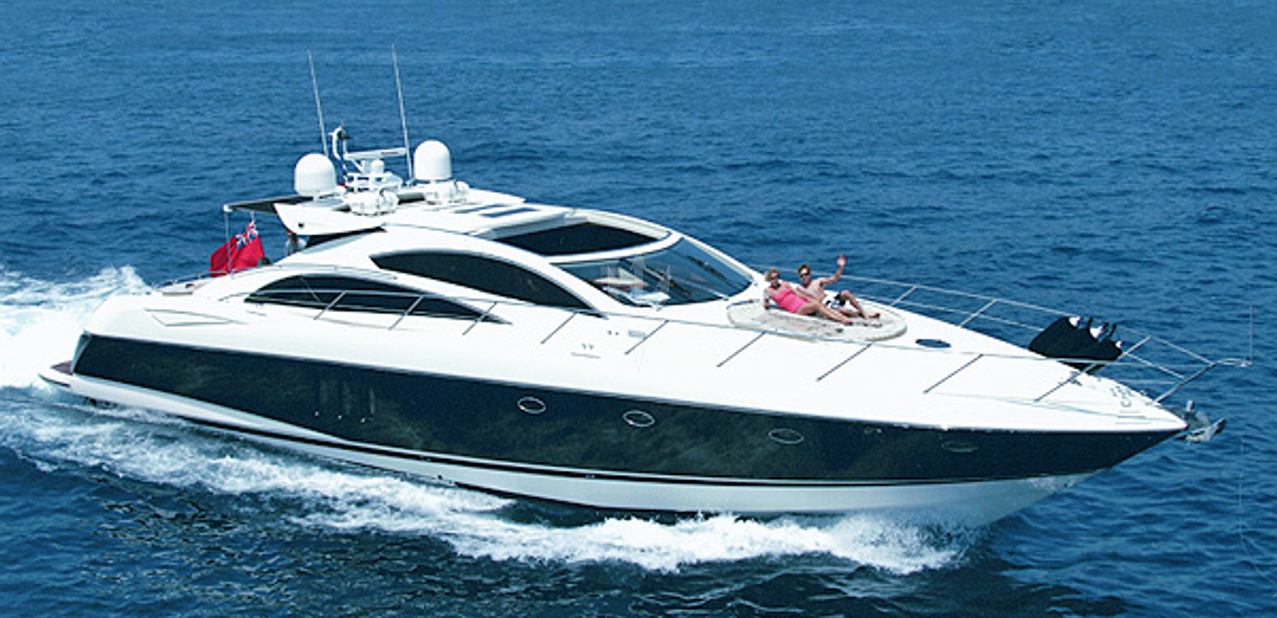
View More Photos
- Luxury Charter Yachts
- Motor Yachts for Charter
- Amenities & Toys
- Rates & Regions
- + Shortlist
AMADEUS YACHT CHARTER
21.95m / 72' sunseeker 2008.
- Previous Yacht
Cabin Configuration
Special Features:
- Cruising speed of 22 knots
- Sleeps 6 guests
- Williams Jet RIB
Luxury yacht Amadeus is the perfect charter platform for yachting vacations spent entertaining in style
The 21.95m/72' motor yacht 'Amadeus' by the British shipyard Sunseeker offers flexible accommodation for up to 6 guests in 3 cabins.
If you're looking for a family-friendly yacht with plenty of onboard amenities, Amadeus is the perfect choice, promising superb charter vacations whatever the destination.
Guest Accommodation
Built in 2008, Amadeus offers guest accommodation for up to 6 guests in 3 suites comprising a master suite, one VIP cabin and one twin cabin. There are 4 beds in total, including 1 queen, 1 double and 2 singles. She is also capable of carrying up to 2 crew onboard to ensure a relaxed luxury yacht charter experience.
Onboard Comfort & Entertainment
Whatever your activities on your charter, you'll find some impressive features are seamlessly integrated to help you, notably Wi-Fi connectivity, allowing you to stay connected at all times, should you wish. Guests will experience complete comfort while chartering thanks to air conditioning.
Performance & Range
Powered by twin MAN engines, she comfortably cruises at 22 knots, reaches a maximum speed of 35 knots with a range of up to 250 nautical miles.
Onboard Amadeus has a range of toys and accessories to keep you and your guests entertained on the water throughout your stay. Principle among these are Super wid waterskis that are hugely entertaining whether you are a beginner or a seasoned pro. Another excellent feature are O' Brien Ace wakeboards so guests can show off at speed. When it's time to travel from land to see, it couldn't be easier with a Williams Jet RIB.
Motor yacht Amadeus boasts an impressive array of outstanding amenities for truly out-of-this-world charter vacations that you’ll never forget.
TESTIMONIALS
There are currently no testimonials for Amadeus, please provide .
Amadeus Photos
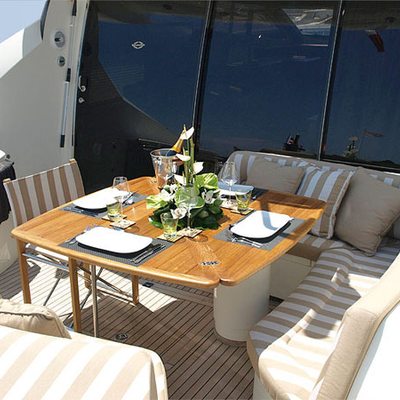
Amenities & Entertainment
For your relaxation and entertainment Amadeus has the following facilities, for more details please speak to your yacht charter broker.
Amadeus is reported to be available to Charter with the following recreation facilities:
- 1 x Williams 325 Jet RIB 100 HP engine
For a full list of all available amenities & entertainment facilities, or price to hire additional equipment please contact your broker.
- + shortlist
For a full list of all available amenities & entertainment facilities, or price to hire additional equipment please contact your broker.
'Amadeus' Charter Rates & Destinations
Please contact your charter broker for a quote or check availability .
Charter Amadeus
To charter this luxury yacht contact your charter broker , or we can help you.
To charter this luxury yacht contact your charter broker or
Update your yacht
Yacht Owner, Captain or Central Agents - Send us latest Photos, Charter Rates or Corrections Contact Us
SIMILAR YACHTS FOR CHARTER
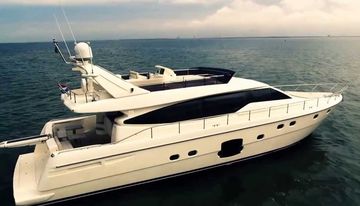
d'Artagnan
20m | Ferretti Yachts
from $25,000 p/week ♦︎
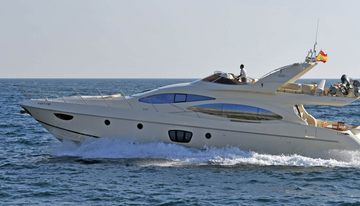
21m | Azimut
from $27,000 p/week
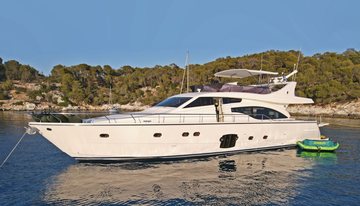
21m | Ferretti Yachts
from $23,000 p/week ♦︎
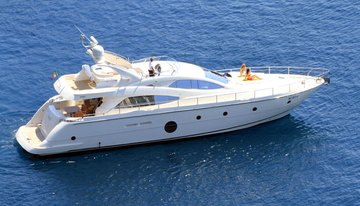
21m | Aicon
from $17,000 p/week ♦︎

22m | Sunseeker
from $28,000 p/week ♦︎

20m | Galeon
from $13,000 p/week ♦︎

22m | Baia Yachts
from $29,000 p/week ♦︎
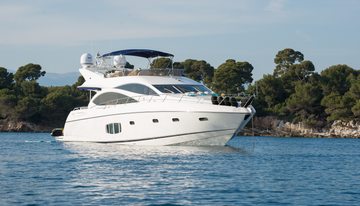
P'tite Bouille
21m | Princess
from $32,000 p/week ♦︎
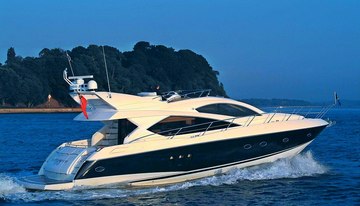
Saint George
20m | Sunseeker
POA ♦︎

21m | President
from $24,000 p/week ♦︎
NOTE to U.S. Customs & Border Protection
Specification
- Share on Facebook
- Share Yacht
SIMILAR LUXURY CHARTER YACHTS
Here are a selection of yachts which are similar to the current charter yacht. To view all similar luxury charter yachts click on the button below.

As Featured In
The YachtCharterFleet Difference
YachtCharterFleet makes it easy to find the yacht charter vacation that is right for you. We combine thousands of yacht listings with local destination information, sample itineraries and experiences to deliver the world's most comprehensive yacht charter website.
San Francisco
- Like us on Facebook
- Follow us on Twitter
- Follow us on Instagram
- Find us on LinkedIn
- Add My Yacht
- Affiliates & Partners
Popular Destinations & Events
- St Tropez Yacht Charter
- Monaco Yacht Charter
- St Barts Yacht Charter
- Greece Yacht Charter
- Mykonos Yacht Charter
- Caribbean Yacht Charter
Featured Charter Yachts
- Maltese Falcon Yacht Charter
- Wheels Yacht Charter
- Victorious Yacht Charter
- Andrea Yacht Charter
- Titania Yacht Charter
- Ahpo Yacht Charter
Receive our latest offers, trends and stories direct to your inbox.
Please enter a valid e-mail.
Thanks for subscribing.
Search for Yachts, Destinations, Events, News... everything related to Luxury Yachts for Charter.
Yachts in your shortlist

Turn Your Curiosity Into Discovery
Latest facts.

3 TopRated Sites To Boost Your TikTok and Instagram Following

5 Detailed Facts About Medical Cannabis
40 facts about elektrostal.
Written by Lanette Mayes
Modified & Updated: 02 Mar 2024
Reviewed by Jessica Corbett

Elektrostal is a vibrant city located in the Moscow Oblast region of Russia. With a rich history, stunning architecture, and a thriving community, Elektrostal is a city that has much to offer. Whether you are a history buff, nature enthusiast, or simply curious about different cultures, Elektrostal is sure to captivate you.
This article will provide you with 40 fascinating facts about Elektrostal, giving you a better understanding of why this city is worth exploring. From its origins as an industrial hub to its modern-day charm, we will delve into the various aspects that make Elektrostal a unique and must-visit destination.
So, join us as we uncover the hidden treasures of Elektrostal and discover what makes this city a true gem in the heart of Russia.
Key Takeaways:
- Elektrostal, known as the “Motor City of Russia,” is a vibrant and growing city with a rich industrial history, offering diverse cultural experiences and a strong commitment to environmental sustainability.
- With its convenient location near Moscow, Elektrostal provides a picturesque landscape, vibrant nightlife, and a range of recreational activities, making it an ideal destination for residents and visitors alike.
Known as the “Motor City of Russia.”
Elektrostal, a city located in the Moscow Oblast region of Russia, earned the nickname “Motor City” due to its significant involvement in the automotive industry.
Home to the Elektrostal Metallurgical Plant.
Elektrostal is renowned for its metallurgical plant, which has been producing high-quality steel and alloys since its establishment in 1916.
Boasts a rich industrial heritage.
Elektrostal has a long history of industrial development, contributing to the growth and progress of the region.
Founded in 1916.
The city of Elektrostal was founded in 1916 as a result of the construction of the Elektrostal Metallurgical Plant.
Located approximately 50 kilometers east of Moscow.
Elektrostal is situated in close proximity to the Russian capital, making it easily accessible for both residents and visitors.
Known for its vibrant cultural scene.
Elektrostal is home to several cultural institutions, including museums, theaters, and art galleries that showcase the city’s rich artistic heritage.
A popular destination for nature lovers.
Surrounded by picturesque landscapes and forests, Elektrostal offers ample opportunities for outdoor activities such as hiking, camping, and birdwatching.
Hosts the annual Elektrostal City Day celebrations.
Every year, Elektrostal organizes festive events and activities to celebrate its founding, bringing together residents and visitors in a spirit of unity and joy.
Has a population of approximately 160,000 people.
Elektrostal is home to a diverse and vibrant community of around 160,000 residents, contributing to its dynamic atmosphere.
Boasts excellent education facilities.
The city is known for its well-established educational institutions, providing quality education to students of all ages.
A center for scientific research and innovation.
Elektrostal serves as an important hub for scientific research, particularly in the fields of metallurgy, materials science, and engineering.
Surrounded by picturesque lakes.
The city is blessed with numerous beautiful lakes, offering scenic views and recreational opportunities for locals and visitors alike.
Well-connected transportation system.
Elektrostal benefits from an efficient transportation network, including highways, railways, and public transportation options, ensuring convenient travel within and beyond the city.
Famous for its traditional Russian cuisine.
Food enthusiasts can indulge in authentic Russian dishes at numerous restaurants and cafes scattered throughout Elektrostal.
Home to notable architectural landmarks.
Elektrostal boasts impressive architecture, including the Church of the Transfiguration of the Lord and the Elektrostal Palace of Culture.
Offers a wide range of recreational facilities.
Residents and visitors can enjoy various recreational activities, such as sports complexes, swimming pools, and fitness centers, enhancing the overall quality of life.
Provides a high standard of healthcare.
Elektrostal is equipped with modern medical facilities, ensuring residents have access to quality healthcare services.
Home to the Elektrostal History Museum.
The Elektrostal History Museum showcases the city’s fascinating past through exhibitions and displays.
A hub for sports enthusiasts.
Elektrostal is passionate about sports, with numerous stadiums, arenas, and sports clubs offering opportunities for athletes and spectators.
Celebrates diverse cultural festivals.
Throughout the year, Elektrostal hosts a variety of cultural festivals, celebrating different ethnicities, traditions, and art forms.
Electric power played a significant role in its early development.
Elektrostal owes its name and initial growth to the establishment of electric power stations and the utilization of electricity in the industrial sector.
Boasts a thriving economy.
The city’s strong industrial base, coupled with its strategic location near Moscow, has contributed to Elektrostal’s prosperous economic status.
Houses the Elektrostal Drama Theater.
The Elektrostal Drama Theater is a cultural centerpiece, attracting theater enthusiasts from far and wide.
Popular destination for winter sports.
Elektrostal’s proximity to ski resorts and winter sport facilities makes it a favorite destination for skiing, snowboarding, and other winter activities.
Promotes environmental sustainability.
Elektrostal prioritizes environmental protection and sustainability, implementing initiatives to reduce pollution and preserve natural resources.
Home to renowned educational institutions.
Elektrostal is known for its prestigious schools and universities, offering a wide range of academic programs to students.
Committed to cultural preservation.
The city values its cultural heritage and takes active steps to preserve and promote traditional customs, crafts, and arts.
Hosts an annual International Film Festival.
The Elektrostal International Film Festival attracts filmmakers and cinema enthusiasts from around the world, showcasing a diverse range of films.
Encourages entrepreneurship and innovation.
Elektrostal supports aspiring entrepreneurs and fosters a culture of innovation, providing opportunities for startups and business development.
Offers a range of housing options.
Elektrostal provides diverse housing options, including apartments, houses, and residential complexes, catering to different lifestyles and budgets.
Home to notable sports teams.
Elektrostal is proud of its sports legacy, with several successful sports teams competing at regional and national levels.
Boasts a vibrant nightlife scene.
Residents and visitors can enjoy a lively nightlife in Elektrostal, with numerous bars, clubs, and entertainment venues.
Promotes cultural exchange and international relations.
Elektrostal actively engages in international partnerships, cultural exchanges, and diplomatic collaborations to foster global connections.
Surrounded by beautiful nature reserves.
Nearby nature reserves, such as the Barybino Forest and Luchinskoye Lake, offer opportunities for nature enthusiasts to explore and appreciate the region’s biodiversity.
Commemorates historical events.
The city pays tribute to significant historical events through memorials, monuments, and exhibitions, ensuring the preservation of collective memory.
Promotes sports and youth development.
Elektrostal invests in sports infrastructure and programs to encourage youth participation, health, and physical fitness.
Hosts annual cultural and artistic festivals.
Throughout the year, Elektrostal celebrates its cultural diversity through festivals dedicated to music, dance, art, and theater.
Provides a picturesque landscape for photography enthusiasts.
The city’s scenic beauty, architectural landmarks, and natural surroundings make it a paradise for photographers.
Connects to Moscow via a direct train line.
The convenient train connection between Elektrostal and Moscow makes commuting between the two cities effortless.
A city with a bright future.
Elektrostal continues to grow and develop, aiming to become a model city in terms of infrastructure, sustainability, and quality of life for its residents.
In conclusion, Elektrostal is a fascinating city with a rich history and a vibrant present. From its origins as a center of steel production to its modern-day status as a hub for education and industry, Elektrostal has plenty to offer both residents and visitors. With its beautiful parks, cultural attractions, and proximity to Moscow, there is no shortage of things to see and do in this dynamic city. Whether you’re interested in exploring its historical landmarks, enjoying outdoor activities, or immersing yourself in the local culture, Elektrostal has something for everyone. So, next time you find yourself in the Moscow region, don’t miss the opportunity to discover the hidden gems of Elektrostal.
Q: What is the population of Elektrostal?
A: As of the latest data, the population of Elektrostal is approximately XXXX.
Q: How far is Elektrostal from Moscow?
A: Elektrostal is located approximately XX kilometers away from Moscow.
Q: Are there any famous landmarks in Elektrostal?
A: Yes, Elektrostal is home to several notable landmarks, including XXXX and XXXX.
Q: What industries are prominent in Elektrostal?
A: Elektrostal is known for its steel production industry and is also a center for engineering and manufacturing.
Q: Are there any universities or educational institutions in Elektrostal?
A: Yes, Elektrostal is home to XXXX University and several other educational institutions.
Q: What are some popular outdoor activities in Elektrostal?
A: Elektrostal offers several outdoor activities, such as hiking, cycling, and picnicking in its beautiful parks.
Q: Is Elektrostal well-connected in terms of transportation?
A: Yes, Elektrostal has good transportation links, including trains and buses, making it easily accessible from nearby cities.
Q: Are there any annual events or festivals in Elektrostal?
A: Yes, Elektrostal hosts various events and festivals throughout the year, including XXXX and XXXX.
Was this page helpful?
Our commitment to delivering trustworthy and engaging content is at the heart of what we do. Each fact on our site is contributed by real users like you, bringing a wealth of diverse insights and information. To ensure the highest standards of accuracy and reliability, our dedicated editors meticulously review each submission. This process guarantees that the facts we share are not only fascinating but also credible. Trust in our commitment to quality and authenticity as you explore and learn with us.
Share this Fact:
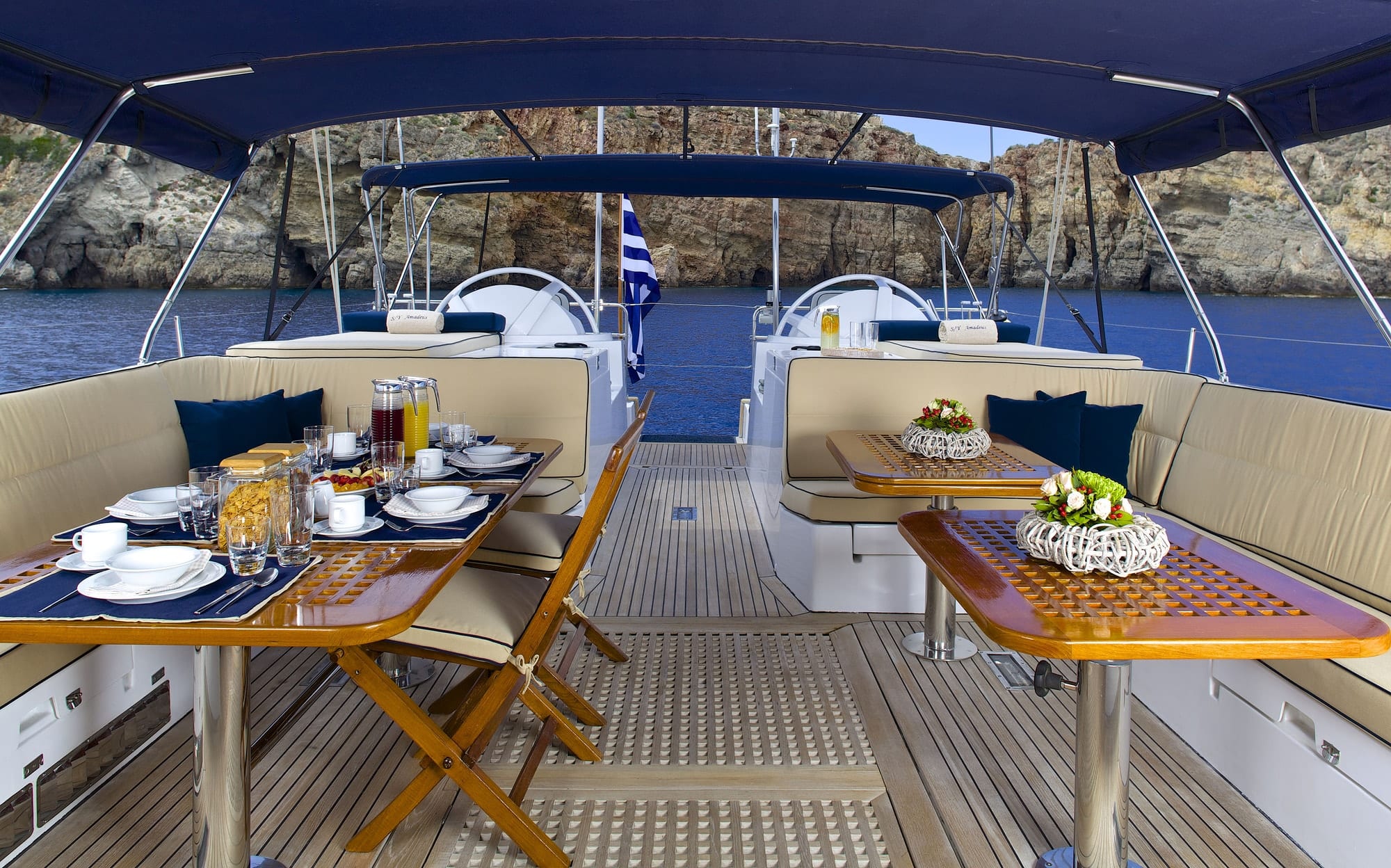
Built by the famous Dynamique Yachts shipyard and having undergone a refit in 2018, sailing Yacht Amadeus was designed to please the most demanding of yachtsmen. Built for smooth sailing, this elegant cutter rigged sloop has a sleek hull design, comfortably reaching top speeds of 12 knots and ensuring excellent sailing performance. ...
The 33.5m/109'11" 'Amadeus' sail yacht built by the French shipyard Dynamiq is available for charter for up to 10 guests in 5 cabins. This yacht features interior styling by French designer Philippe Briand. Whether you are after the thrill of sailing or prefer to kick back, Amadeus is custom-built for adventure, offering a ring-side seat at the heart of the action once her sails have unfurled ...
Sailing yacht AMADEUS is a luxury vessel that measures 33.5m (109.9ft) in length. She was built by the famous Dynamique Yachts shipyard in 1995 and received a total refit in 2004 and smaller refits in 2012/14 and 2018 plus new interior fabrics in 2022. AMADEUS is an elegant cutter rigged sloop with a sleek hull design painted in an eye-catching ...
Amadeus Description. Built by the famous Dynamique Yachts shipyard, and having undergone a total refit in 2018, S/Y Amadeus was designed to please the most demanding of yachtsmen. Built for smooth sailing, this elegant cutter rigged sloop has a sleek hull design, comfortably reaching top speeds of 12 knots and ensuring excellent sailing ...
Length : 30.2 m / Passengers : 8. Special features : - One of the most elegant SW100- Excellent and experienced crew- Very elegant interiors- Available in West and East Med- Large outdoor spaceTender: 4.30... Price Per week from : 46 000€. View this yacht. AMADEUS is a fast cruising sailing yacht built by Dynamique Yachts and totally refit in ...
The 23.85m/78'3" sail yacht 'Amadeus' was built by Custom. Her interior is styled by design house Jean Marc Piaton and she was completed in 2018. Guest Accommodation. Amadeus has been designed to comfortably accommodate up to 8 guests in 4 suites. She is also capable of carrying up to 2 crew onboard to ensure a relaxed luxury yacht experience.
Built by the famous Dynamique Yachts shipyard, and having undergone a total refit in 2018. S/Y Amadeus was designed to please the most demanding of yachtsmen. Built for smooth sailing, this elegant cutter rigged sloop has a sleek hull design. Comfortably reaching top speeds of 12 knots and ensuring excellent sailing performance.
The yacht is maintained in excellent condition with a five-star crew year round. Sailing Yacht Amadeus was designed to please the most demanding of yachtsmen. Built for smooth sailing, this elegant cutter rigged sloop has a sleek hull design, comfortably reaching top speeds of 12 knots and ensuring excellent sailing performance.
AMADEUS I is a 44m/144' motor yacht for charter delivered by the Timmerman shipyard in 2014. Considered as a great luxury charter yacht for friends and family, AMADEUS I was fully upgraded in 2019. Her key features include a huge sundeck with a jacuzzi pool plus a brand-new beach club with a gym and sauna at sea level.
Built by the famous Dynamique Yachts shipyard, and having undergone a total refit in 2014, S/Y Amadeus was designed to please the most demanding of yachtsmen. Built for smooth sailing, this elegant cutter rigged sloop has a sleek hull design, comfortably reaching top speeds of 12 knots and ensuring excellent sailing performance.
AMADEUS was previously registered as project/yacht name Amadeus 1er. This 33 metre (109 ft) luxury yacht was built by Dynamique Yachts in 1991. Sailing Yacht AMADEUS is a well proportioned superyacht. The yacht is a modern sloop with a cutter rig. The naval architecture office whom authored the design work on this ship was Philippe Briand.
Amadeus is a 33.5 m sailing yacht. She was built by Dynamique Yachts in 1991. With a beam of 7.5 m and a draft of 3.9 m. The sailing yacht can accommodate 12 guests in 5 cabins. The yacht was designed by Philippe Briand.
Launched in 1996 by Dynamique Yachts, Amadeus is a 110 foot sailing sloop. To keep her up to date and comfortable for her guests, she has received refits in 2014 and 2018. She has been fitted with twin 320hp Perkins Rolls Royce engines for power, along with her sails.
33.5m / 109'11 Dragos Yachts 1996 / 2007. The 34.75m/114' 'Amadeus' motor yacht built by shipyard Dragos Yachts is available for charter for up to 12 guests in 5 cabins. This yacht features interior styling by Ugar Kose. Built in 1996, Amadeus's bespoke fittings and design ensure guests can explore the ocean's wonders in style and comfort.
Sailing Yacht AMADEUS can accommodate 10-12 guests in five large cabins, including a full-width master stateroom and two double cabins, each with an extra single bed. The two twin cabins can also be converted to doubles upon request, making her the only sailboat on the Greek market with five double beds.
Fully crewed Sailing Yacht AMADEUS available for private yacht charter in Greece, the best sailing holidays & vacation in the Greek Islands. +30 6948 295 207. [email protected] . Aten, Solonos 22-24, Agii Anargiri 135 61, Greece ... Sailing Yachts; Motor Sailer; Yacht Charter Terms; V.I.P. Services; Destinations; About us;
Charter theAMADEUS. AMADEUS is a 110-foot sailing yacht that can accommodate ten to twelve passengers in five staterooms as follows: a spacious Owner's stateroom with a double bed, a vanity and an entertainment unit including TV, DVD and music system; two cabins with a double bed and an additional single bed; two cabins with two twin beds each.
AMADEUS I is a 44m luxury motor super yacht available for charter built in 2014, refitted in 2019. Charter up to 10 guests in 5 cabins (1 Master, 2 VIP, 3 Double & 2 Twin) with a crew of 9. She is also available for events and corporate charter.
No:7 Kuşadası 09400 Aydın. + (90) 256 340 03 40. [email protected] . Mon - Fri: 9:00 - 18:00. Closed on Weekends. Istanbul Branch - Türkiye. Moscow - Russia. London - United Kingdom. New York - United States of America.
Küçükbakkalköy Mah. Fevzipaşa Cad. Bozkır Sok. No:1 ,K:3 D:15 Ataşehir 34750 Istanbul + (90) 216 900 28 62 +(90) 216 576 47 90. [email protected]
Get directions to Yuzhny prospekt, 6к1 and view details like the building's postal code, description, photos, and reviews on each business in the building
The 21.95m/72' 'Amadeus' motor yacht built by the British shipyard Sunseeker is available for charter for up to 6 guests in 3 cabins.. Primed for exploring secluded beaches and tucked-away lagoons or simply relaxing and soaking up the rays onboard, motor yacht Amadeus is tailor-made for family fun.
Known as the "Motor City of Russia." Elektrostal, a city located in the Moscow Oblast region of Russia, earned the nickname "Motor City" due to its significant involvement in the automotive industry.. Home to the Elektrostal Metallurgical Plant. Elektrostal is renowned for its metallurgical plant, which has been producing high-quality steel and alloys since its establishment in 1916.

IMAGES
VIDEO
COMMENTS
So if a boat is 36' (the square root of 36 being six) the equation to determine hull speed is 1.34 x 6 = 8.04 knots. A displacement boat of this size will be designed to travel at up to 8.04 knots, but never beyond that. Displacement boats can be very fuel efficient, certainly much more efficient than planning hulls.
This modern classic yacht is a head turner on the racecourse, blending speed and style thanks to her highly varnished wooden hull. The 27.43 metre Tempus Fugit , from Arkin Pruva , was designed by Rob Humphreys to pay homage to J Class yachts , but she is beamier, offering more comfortable living accommodations below and in the cockpit during ...
This prevents the hull from flexing in water. Four MTU engines deliver 19,000-hp, and the addition of a fully-certified helipad means no place is off limits. Ulstein Verft's 290-Foot Motor Yacht ...
Each yacht nowadays is like a one-of-a-kind piece of art, tailored to the person who owns it. The Building Blocks of a Modern Yacht. Shape of the Boat (Hull Design): This is what helps the yacht move smoothly and quickly through the water. Designers are always finding new ways to make the yacht's bottom part (the hull) cut through waves more ...
Learn about the latest trends in yacht hull designs and how they combine form with function to create stunning aesthetics. This article dives into how modern yachts not only look good but also perform excellently due to their innovative hull shapes. Understand the balance between sleek lines and seagoing capabilities that make these yachts stand out.
Planing yacht hull design. Fn: 1.1 and above, preferably from 2 and up. Average power requirement: 60hp/ton plus. Prismatic coefficient: 0.68 0.76. LCB: 0.58 0.64. Typically monohedral prismatic aft shape constant deadrise. Light displacement. Engine room forms a significant part of hull volume (up to 30-40 per cent)
Fortunately, there are multiple yards around the world that are still building wooden boats—but with modern hulls and systems that eliminate the hassles of owning a vintage yacht. Some build ...
The modern boats have longer proportional waterlines, indicating higher potential speed. It also means that the boats immersed volume, or displacement, has been distributed over a greater length. ... By 1980, cruising-boat hulls were already becoming beamy relative to boats of the 1960s and 1970s. The current trend is to carry the beam aft, so ...
4. Seven. Part of the world's largest sailing yacht series by length, Seven is hull number 3 in Perini Navi's 60m ketch series, after Seahawk and Perseus 3.Launched in 2017, she was feted for ...
Sails provide power, foils the lift, which makes the hull the third critical leg of the AC75. Hull design has always been the most venerated aspect of an America's Cup yacht. The name on the ...
After a 30 year absence, a veteran marine journalist returns to the US Sailboat Show and discovers the many changes in cruising boat design and construction. By Dan Spurr. Updated: June 10, 2020. The X-Yachts 46 displays the wide beam, twin wheels and open transom that define many 2020 models. Jon Whittle.
With raked stem, deep V hull form, lower freeboard and slight curve to the topsides she has a more timeless aesthetic than many modern slab-sided high volume yachts, and with that a seakindly ...
A fuel-efficient hull is essential when it comes to ensuring an expedition yacht has the range to cross oceans. Cheoy Lee Yachts Explorer Series yachts feature a bulbous bow, which reduces the hull's resistance to the water. " When Overing Yacht Design developed their first 50-meter fast-displacement hull in the late 1990s, Overing brought ...
Modern boat and ship design incorporates a variety of hull materials, depending on the size, application, and expected life of the vessel. For smaller, recreational or shallow-sea activities, polyethylene boats are a good choice, both environmentally and economically.
The yachts also include 17,300 individual parts, 140 sensors, and 787 ft (240 mt) of hydraulic pipes, and are sailed by an 11-person crew. Interestingly, the hulls of these yachts are more akin to ...
What you're left with is a hull, and boat hulls take three basic forms. Displacement hull; Semi-displacement hulls; Planing hulls; ... Both catamarans and modern monohulls' hull shapes use their beams to reduce the amount of ballast and weight. A lighter boat can sail fast, but to make it more stable, naval architects increase the beam to ...
Victoria J. Manzo July 4, 2023. Hull design plays a critical role in the performance and efficiency of yachts, making it an essential consideration for yacht designers. The shape and form of the hull directly impact characteristics such as speed, stability, maneuverability, and fuel consumption. For instance, let's consider a hypothetical ...
Most owners of stepped-hull vessels are experienced and want to travel at high speeds in moderate to heavy seas, and/or achieve good economy and range. Yet to date, performance and center console builders aside, only Regal Boats, with its FasTrac hulls, and Formula have committed to using steps in production cruisers and sport boats.
The design of a yacht's hull plays a crucial role in determining its performance and efficiency on the water. Yacht designers must carefully consider the materials used for constructing the hull to ensure optimal results. ... As we delve deeper into innovations in composite materials for modern yacht hulls, it becomes evident that ...
Impressions; At 91 meters in length, Lady Lara is an ultramodern superyacht with sweeping curves and an elegantly balanced profile. Dynamic, sculpted features carry through her ex
The solution was a deep V hull which, with the shape of the bow and the use of interceptors, allows the boat to pierce the waves comfortably, even at high speeds. ... The WallyPower is also being honoured by the San Francisco Museum of Modern Art as the sole boat in its major architecture and design exhibition, 'Glamour: Fabricating Affluence ...
Imagined by Flynt for the serious owner and strengthened by Dutch superyacht design studio Vripack's robust naval architecture, Flynt 956 means business. A deep-V planing hull tears across water making the boat efficient, rapid and easy to manoeuvre. It delivers top speed performance from the comfort of adjustable Recaro sport seats.... The Flynt 956 Nova is a 9.56 meters caddy boat with 1 ...
Built by the famous Dynamique Yachts shipyard and having undergone a refit in 2018, sailing Yacht Amadeus was designed to please the most demanding of yachtsmen. Built for smooth sailing, this elegant cutter rigged sloop has a sleek hull design, comfortably reaching top speeds of 12 knots and ensuring excellent sailing performance. ..... The 33.5m/109'11" 'Amadeus' sail yacht built by the ...
SLO-MO PROP SHOT follow @u11racing Jamie Nilsen in the Legend Yacht Transport Presented by the Truss Company, leaves the dock during a Test Session at the 2023 Columbia Cup The current U-11...